Assignment On Qualitative Dissertation Research Plan.
VerifiedAdded on 2022/09/14
|37
|16713
|15
Assignment
AI Summary
Contribute Materials
Your contribution can guide someone’s learning journey. Share your
documents today.
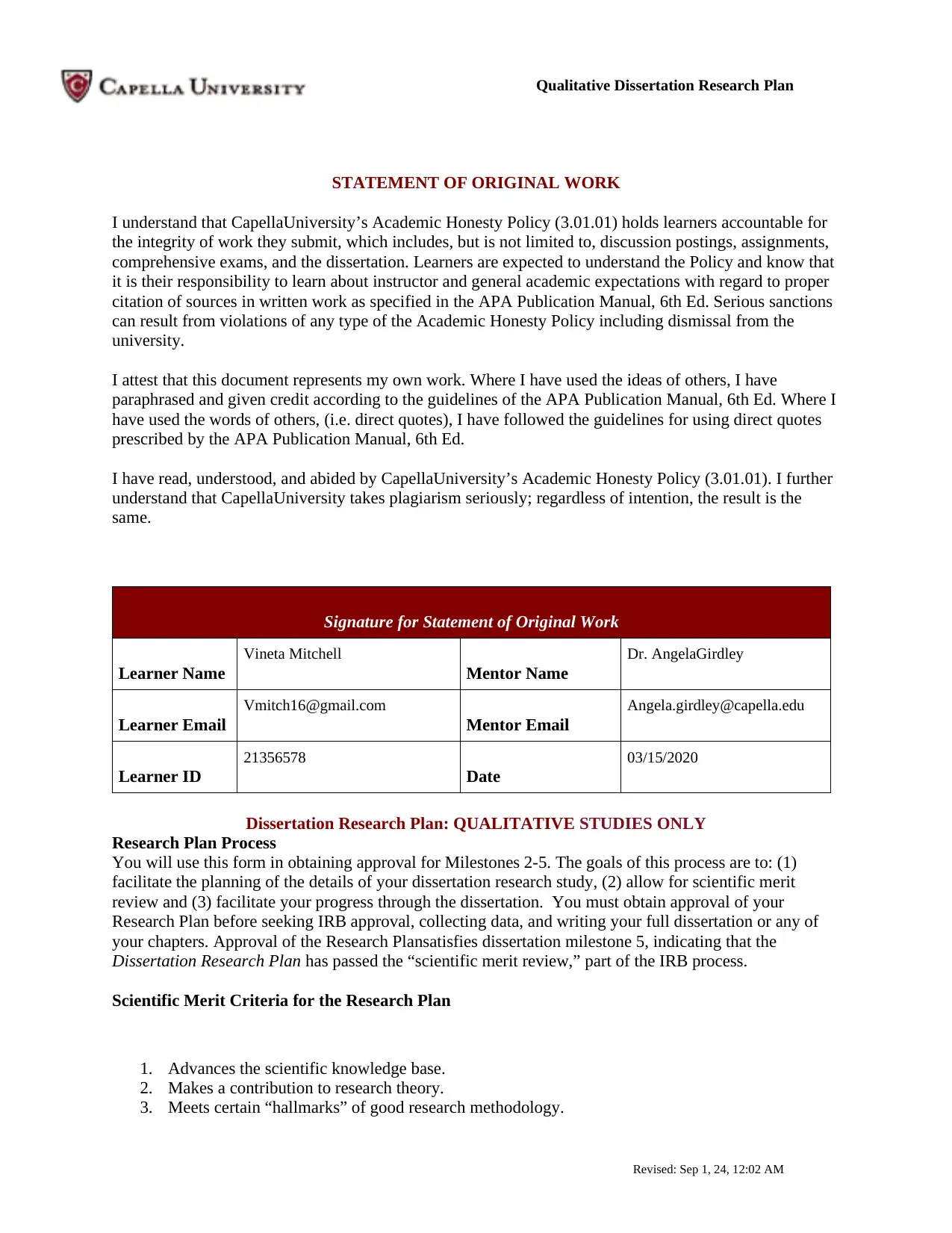
Qualitative Dissertation Research Plan
STATEMENT OF ORIGINAL WORK
I understand that CapellaUniversity’s Academic Honesty Policy (3.01.01) holds learners accountable for
the integrity of work they submit, which includes, but is not limited to, discussion postings, assignments,
comprehensive exams, and the dissertation. Learners are expected to understand the Policy and know that
it is their responsibility to learn about instructor and general academic expectations with regard to proper
citation of sources in written work as specified in the APA Publication Manual, 6th Ed. Serious sanctions
can result from violations of any type of the Academic Honesty Policy including dismissal from the
university.
I attest that this document represents my own work. Where I have used the ideas of others, I have
paraphrased and given credit according to the guidelines of the APA Publication Manual, 6th Ed. Where I
have used the words of others, (i.e. direct quotes), I have followed the guidelines for using direct quotes
prescribed by the APA Publication Manual, 6th Ed.
I have read, understood, and abided by CapellaUniversity’s Academic Honesty Policy (3.01.01). I further
understand that CapellaUniversity takes plagiarism seriously; regardless of intention, the result is the
same.
Signature for Statement of Original Work
Learner Name
Vineta Mitchell
Mentor Name
Dr. AngelaGirdley
Learner Email
Vmitch16@gmail.com
Mentor Email
Angela.girdley@capella.edu
Learner ID
21356578
Date
03/15/2020
Dissertation Research Plan: QUALITATIVE STUDIES ONLY
Research Plan Process
You will use this form in obtaining approval for Milestones 2-5. The goals of this process are to: (1)
facilitate the planning of the details of your dissertation research study, (2) allow for scientific merit
review and (3) facilitate your progress through the dissertation. You must obtain approval of your
Research Plan before seeking IRB approval, collecting data, and writing your full dissertation or any of
your chapters. Approval of the Research Plansatisfies dissertation milestone 5, indicating that the
Dissertation Research Plan has passed the “scientific merit review,” part of the IRB process.
Scientific Merit Criteria for the Research Plan
1. Advances the scientific knowledge base.
2. Makes a contribution to research theory.
3. Meets certain “hallmarks” of good research methodology.
Revised: Sep 1, 24, 12:02 AM
STATEMENT OF ORIGINAL WORK
I understand that CapellaUniversity’s Academic Honesty Policy (3.01.01) holds learners accountable for
the integrity of work they submit, which includes, but is not limited to, discussion postings, assignments,
comprehensive exams, and the dissertation. Learners are expected to understand the Policy and know that
it is their responsibility to learn about instructor and general academic expectations with regard to proper
citation of sources in written work as specified in the APA Publication Manual, 6th Ed. Serious sanctions
can result from violations of any type of the Academic Honesty Policy including dismissal from the
university.
I attest that this document represents my own work. Where I have used the ideas of others, I have
paraphrased and given credit according to the guidelines of the APA Publication Manual, 6th Ed. Where I
have used the words of others, (i.e. direct quotes), I have followed the guidelines for using direct quotes
prescribed by the APA Publication Manual, 6th Ed.
I have read, understood, and abided by CapellaUniversity’s Academic Honesty Policy (3.01.01). I further
understand that CapellaUniversity takes plagiarism seriously; regardless of intention, the result is the
same.
Signature for Statement of Original Work
Learner Name
Vineta Mitchell
Mentor Name
Dr. AngelaGirdley
Learner Email
Vmitch16@gmail.com
Mentor Email
Angela.girdley@capella.edu
Learner ID
21356578
Date
03/15/2020
Dissertation Research Plan: QUALITATIVE STUDIES ONLY
Research Plan Process
You will use this form in obtaining approval for Milestones 2-5. The goals of this process are to: (1)
facilitate the planning of the details of your dissertation research study, (2) allow for scientific merit
review and (3) facilitate your progress through the dissertation. You must obtain approval of your
Research Plan before seeking IRB approval, collecting data, and writing your full dissertation or any of
your chapters. Approval of the Research Plansatisfies dissertation milestone 5, indicating that the
Dissertation Research Plan has passed the “scientific merit review,” part of the IRB process.
Scientific Merit Criteria for the Research Plan
1. Advances the scientific knowledge base.
2. Makes a contribution to research theory.
3. Meets certain “hallmarks” of good research methodology.
Revised: Sep 1, 24, 12:02 AM
Secure Best Marks with AI Grader
Need help grading? Try our AI Grader for instant feedback on your assignments.
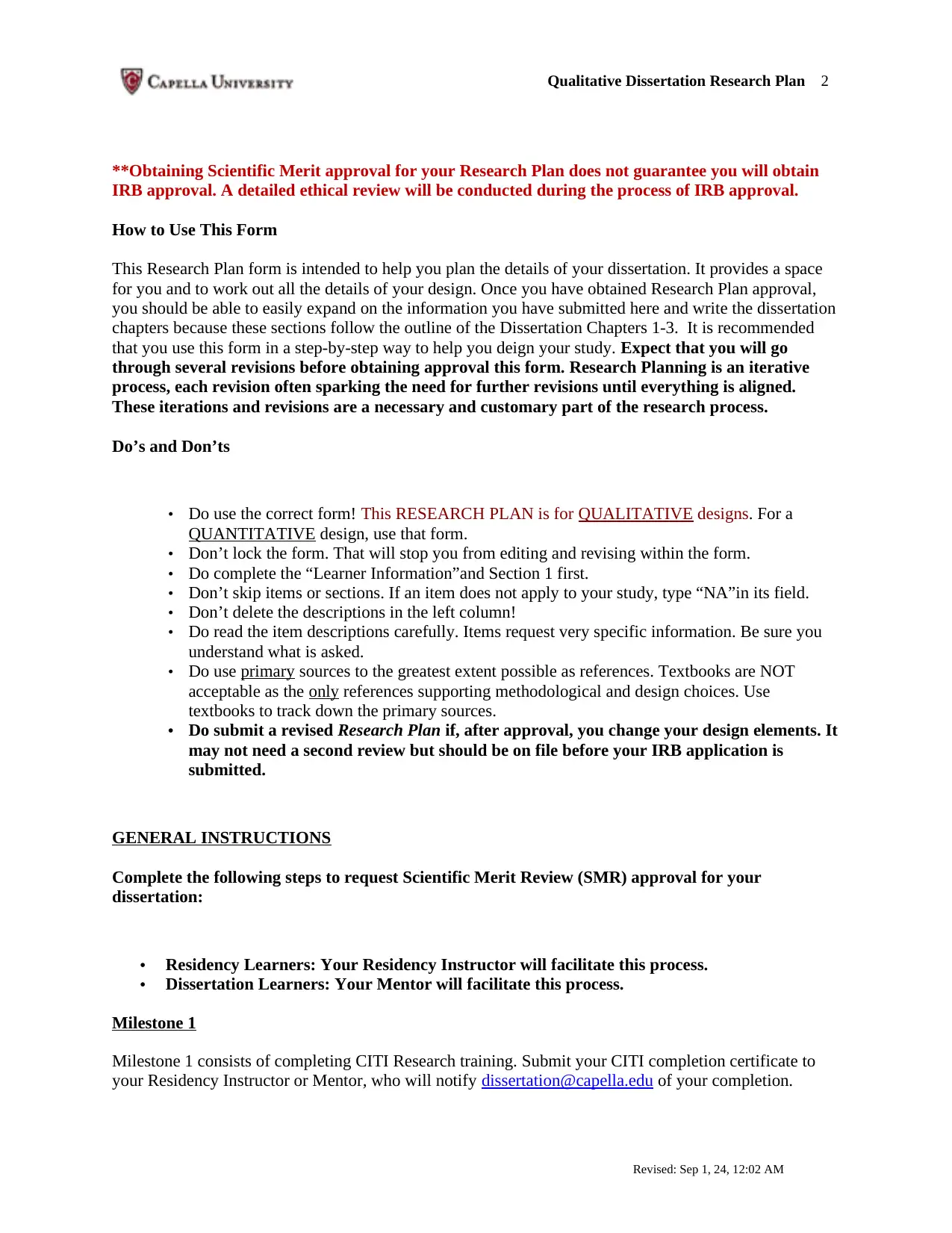
Qualitative Dissertation Research Plan 2
**Obtaining Scientific Merit approval for your Research Plan does not guarantee you will obtain
IRB approval. A detailed ethical review will be conducted during the process of IRB approval.
How to Use This Form
This Research Plan form is intended to help you plan the details of your dissertation. It provides a space
for you and to work out all the details of your design. Once you have obtained Research Plan approval,
you should be able to easily expand on the information you have submitted here and write the dissertation
chapters because these sections follow the outline of the Dissertation Chapters 1-3. It is recommended
that you use this form in a step-by-step way to help you deign your study. Expect that you will go
through several revisions before obtaining approval this form. Research Planning is an iterative
process, each revision often sparking the need for further revisions until everything is aligned.
These iterations and revisions are a necessary and customary part of the research process.
Do’s and Don’ts
• Do use the correct form! This RESEARCH PLAN is for QUALITATIVE designs. For a
QUANTITATIVE design, use that form.
• Don’t lock the form. That will stop you from editing and revising within the form.
• Do complete the “Learner Information”and Section 1 first.
• Don’t skip items or sections. If an item does not apply to your study, type “NA”in its field.
• Don’t delete the descriptions in the left column!
• Do read the item descriptions carefully. Items request very specific information. Be sure you
understand what is asked.
• Do use primary sources to the greatest extent possible as references. Textbooks are NOT
acceptable as the only references supporting methodological and design choices. Use
textbooks to track down the primary sources.
• Do submit a revised Research Plan if, after approval, you change your design elements. It
may not need a second review but should be on file before your IRB application is
submitted.
GENERAL INSTRUCTIONS
Complete the following steps to request Scientific Merit Review (SMR) approval for your
dissertation:
• Residency Learners: Your Residency Instructor will facilitate this process.
• Dissertation Learners: Your Mentor will facilitate this process.
Milestone 1
Milestone 1 consists of completing CITI Research training. Submit your CITI completion certificate to
your Residency Instructor or Mentor, who will notify dissertation@capella.edu of your completion.
Revised: Sep 1, 24, 12:02 AM
**Obtaining Scientific Merit approval for your Research Plan does not guarantee you will obtain
IRB approval. A detailed ethical review will be conducted during the process of IRB approval.
How to Use This Form
This Research Plan form is intended to help you plan the details of your dissertation. It provides a space
for you and to work out all the details of your design. Once you have obtained Research Plan approval,
you should be able to easily expand on the information you have submitted here and write the dissertation
chapters because these sections follow the outline of the Dissertation Chapters 1-3. It is recommended
that you use this form in a step-by-step way to help you deign your study. Expect that you will go
through several revisions before obtaining approval this form. Research Planning is an iterative
process, each revision often sparking the need for further revisions until everything is aligned.
These iterations and revisions are a necessary and customary part of the research process.
Do’s and Don’ts
• Do use the correct form! This RESEARCH PLAN is for QUALITATIVE designs. For a
QUANTITATIVE design, use that form.
• Don’t lock the form. That will stop you from editing and revising within the form.
• Do complete the “Learner Information”and Section 1 first.
• Don’t skip items or sections. If an item does not apply to your study, type “NA”in its field.
• Don’t delete the descriptions in the left column!
• Do read the item descriptions carefully. Items request very specific information. Be sure you
understand what is asked.
• Do use primary sources to the greatest extent possible as references. Textbooks are NOT
acceptable as the only references supporting methodological and design choices. Use
textbooks to track down the primary sources.
• Do submit a revised Research Plan if, after approval, you change your design elements. It
may not need a second review but should be on file before your IRB application is
submitted.
GENERAL INSTRUCTIONS
Complete the following steps to request Scientific Merit Review (SMR) approval for your
dissertation:
• Residency Learners: Your Residency Instructor will facilitate this process.
• Dissertation Learners: Your Mentor will facilitate this process.
Milestone 1
Milestone 1 consists of completing CITI Research training. Submit your CITI completion certificate to
your Residency Instructor or Mentor, who will notify dissertation@capella.edu of your completion.
Revised: Sep 1, 24, 12:02 AM
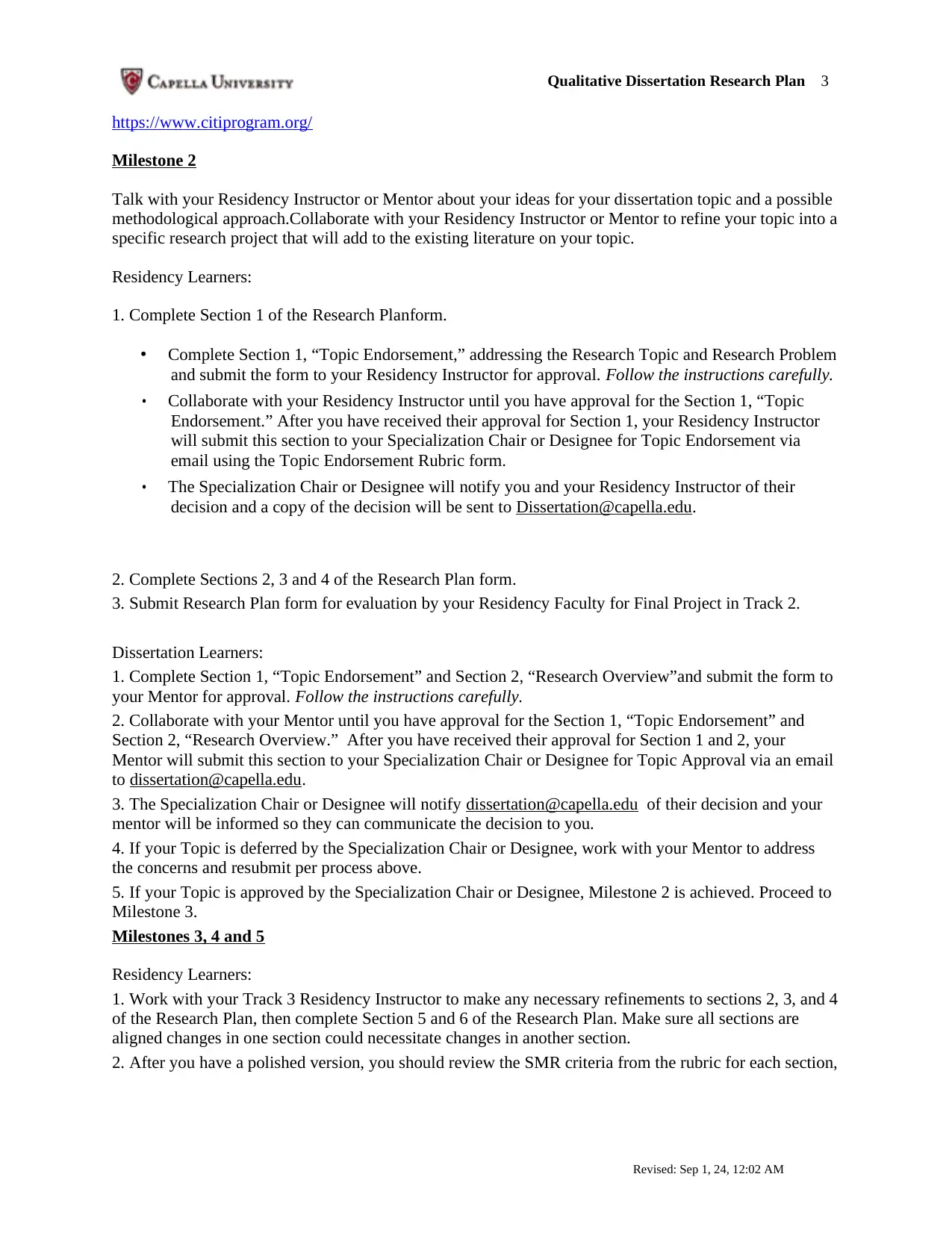
Qualitative Dissertation Research Plan 3
https://www.citiprogram.org/
Milestone 2
Talk with your Residency Instructor or Mentor about your ideas for your dissertation topic and a possible
methodological approach.Collaborate with your Residency Instructor or Mentor to refine your topic into a
specific research project that will add to the existing literature on your topic.
Residency Learners:
1. Complete Section 1 of the Research Planform.
• Complete Section 1, “Topic Endorsement,” addressing the Research Topic and Research Problem
and submit the form to your Residency Instructor for approval. Follow the instructions carefully.
• Collaborate with your Residency Instructor until you have approval for the Section 1, “Topic
Endorsement.” After you have received their approval for Section 1, your Residency Instructor
will submit this section to your Specialization Chair or Designee for Topic Endorsement via
email using the Topic Endorsement Rubric form.
• The Specialization Chair or Designee will notify you and your Residency Instructor of their
decision and a copy of the decision will be sent to Dissertation@capella.edu.
2. Complete Sections 2, 3 and 4 of the Research Plan form.
3. Submit Research Plan form for evaluation by your Residency Faculty for Final Project in Track 2.
Dissertation Learners:
1. Complete Section 1, “Topic Endorsement” and Section 2, “Research Overview”and submit the form to
your Mentor for approval. Follow the instructions carefully.
2. Collaborate with your Mentor until you have approval for the Section 1, “Topic Endorsement” and
Section 2, “Research Overview.” After you have received their approval for Section 1 and 2, your
Mentor will submit this section to your Specialization Chair or Designee for Topic Approval via an email
to dissertation@capella.edu.
3. The Specialization Chair or Designee will notify dissertation@capella.edu of their decision and your
mentor will be informed so they can communicate the decision to you.
4. If your Topic is deferred by the Specialization Chair or Designee, work with your Mentor to address
the concerns and resubmit per process above.
5. If your Topic is approved by the Specialization Chair or Designee, Milestone 2 is achieved. Proceed to
Milestone 3.
Milestones 3, 4 and 5
Residency Learners:
1. Work with your Track 3 Residency Instructor to make any necessary refinements to sections 2, 3, and 4
of the Research Plan, then complete Section 5 and 6 of the Research Plan. Make sure all sections are
aligned changes in one section could necessitate changes in another section.
2. After you have a polished version, you should review the SMR criteria from the rubric for each section,
Revised: Sep 1, 24, 12:02 AM
https://www.citiprogram.org/
Milestone 2
Talk with your Residency Instructor or Mentor about your ideas for your dissertation topic and a possible
methodological approach.Collaborate with your Residency Instructor or Mentor to refine your topic into a
specific research project that will add to the existing literature on your topic.
Residency Learners:
1. Complete Section 1 of the Research Planform.
• Complete Section 1, “Topic Endorsement,” addressing the Research Topic and Research Problem
and submit the form to your Residency Instructor for approval. Follow the instructions carefully.
• Collaborate with your Residency Instructor until you have approval for the Section 1, “Topic
Endorsement.” After you have received their approval for Section 1, your Residency Instructor
will submit this section to your Specialization Chair or Designee for Topic Endorsement via
email using the Topic Endorsement Rubric form.
• The Specialization Chair or Designee will notify you and your Residency Instructor of their
decision and a copy of the decision will be sent to Dissertation@capella.edu.
2. Complete Sections 2, 3 and 4 of the Research Plan form.
3. Submit Research Plan form for evaluation by your Residency Faculty for Final Project in Track 2.
Dissertation Learners:
1. Complete Section 1, “Topic Endorsement” and Section 2, “Research Overview”and submit the form to
your Mentor for approval. Follow the instructions carefully.
2. Collaborate with your Mentor until you have approval for the Section 1, “Topic Endorsement” and
Section 2, “Research Overview.” After you have received their approval for Section 1 and 2, your
Mentor will submit this section to your Specialization Chair or Designee for Topic Approval via an email
to dissertation@capella.edu.
3. The Specialization Chair or Designee will notify dissertation@capella.edu of their decision and your
mentor will be informed so they can communicate the decision to you.
4. If your Topic is deferred by the Specialization Chair or Designee, work with your Mentor to address
the concerns and resubmit per process above.
5. If your Topic is approved by the Specialization Chair or Designee, Milestone 2 is achieved. Proceed to
Milestone 3.
Milestones 3, 4 and 5
Residency Learners:
1. Work with your Track 3 Residency Instructor to make any necessary refinements to sections 2, 3, and 4
of the Research Plan, then complete Section 5 and 6 of the Research Plan. Make sure all sections are
aligned changes in one section could necessitate changes in another section.
2. After you have a polished version, you should review the SMR criteria from the rubric for each section,
Revised: Sep 1, 24, 12:02 AM
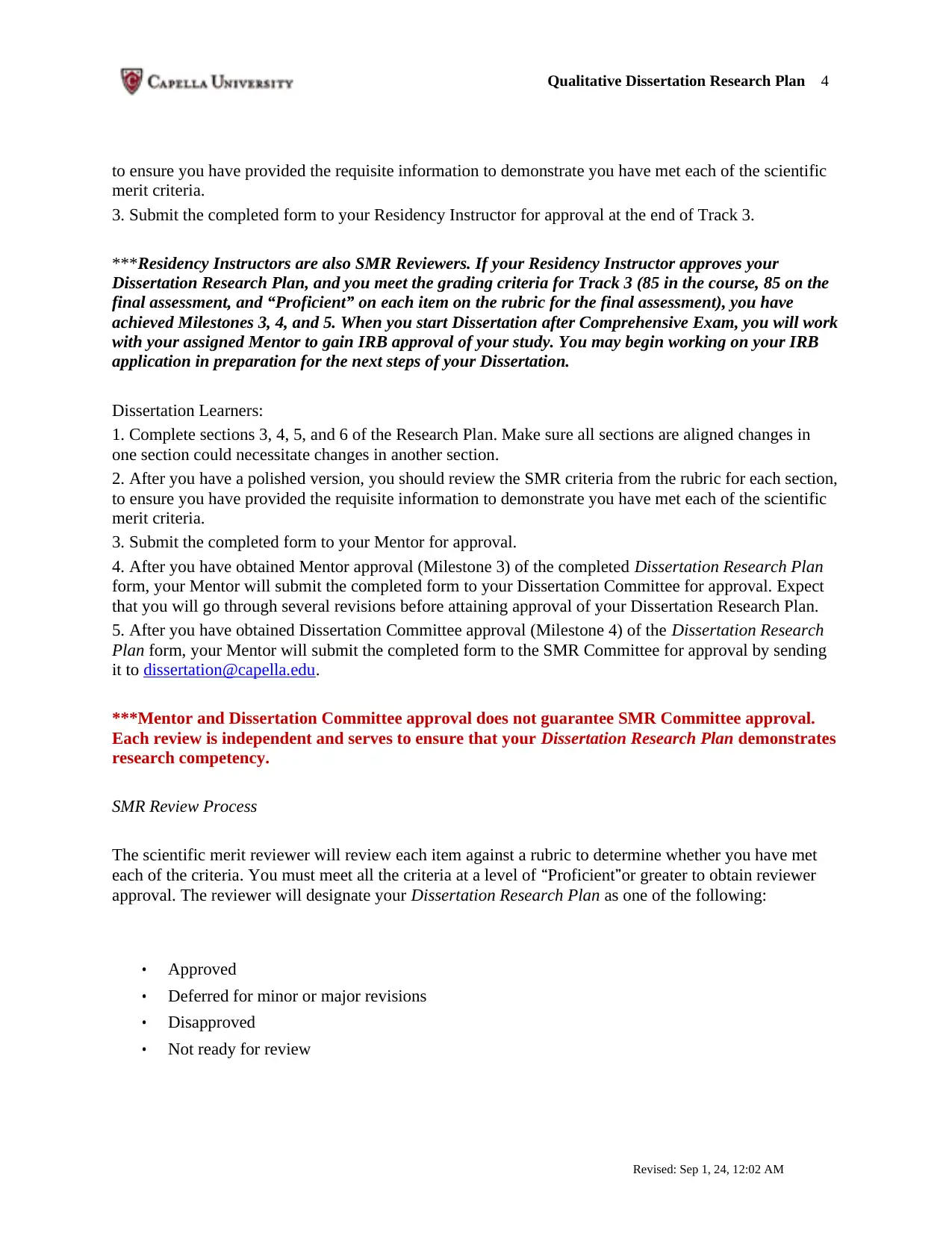
Qualitative Dissertation Research Plan 4
to ensure you have provided the requisite information to demonstrate you have met each of the scientific
merit criteria.
3. Submit the completed form to your Residency Instructor for approval at the end of Track 3.
***Residency Instructors are also SMR Reviewers. If your Residency Instructor approves your
Dissertation Research Plan, and you meet the grading criteria for Track 3 (85 in the course, 85 on the
final assessment, and “Proficient” on each item on the rubric for the final assessment), you have
achieved Milestones 3, 4, and 5. When you start Dissertation after Comprehensive Exam, you will work
with your assigned Mentor to gain IRB approval of your study. You may begin working on your IRB
application in preparation for the next steps of your Dissertation.
Dissertation Learners:
1. Complete sections 3, 4, 5, and 6 of the Research Plan. Make sure all sections are aligned changes in
one section could necessitate changes in another section.
2. After you have a polished version, you should review the SMR criteria from the rubric for each section,
to ensure you have provided the requisite information to demonstrate you have met each of the scientific
merit criteria.
3. Submit the completed form to your Mentor for approval.
4. After you have obtained Mentor approval (Milestone 3) of the completed Dissertation Research Plan
form, your Mentor will submit the completed form to your Dissertation Committee for approval. Expect
that you will go through several revisions before attaining approval of your Dissertation Research Plan.
5. After you have obtained Dissertation Committee approval (Milestone 4) of the Dissertation Research
Plan form, your Mentor will submit the completed form to the SMR Committee for approval by sending
it to dissertation@capella.edu.
***Mentor and Dissertation Committee approval does not guarantee SMR Committee approval.
Each review is independent and serves to ensure that your Dissertation Research Plan demonstrates
research competency.
SMR Review Process
The scientific merit reviewer will review each item against a rubric to determine whether you have met
each of the criteria. You must meet all the criteria at a level of “Proficient”or greater to obtain reviewer
approval. The reviewer will designate your Dissertation Research Plan as one of the following:
• Approved
• Deferred for minor or major revisions
• Disapproved
• Not ready for review
Revised: Sep 1, 24, 12:02 AM
to ensure you have provided the requisite information to demonstrate you have met each of the scientific
merit criteria.
3. Submit the completed form to your Residency Instructor for approval at the end of Track 3.
***Residency Instructors are also SMR Reviewers. If your Residency Instructor approves your
Dissertation Research Plan, and you meet the grading criteria for Track 3 (85 in the course, 85 on the
final assessment, and “Proficient” on each item on the rubric for the final assessment), you have
achieved Milestones 3, 4, and 5. When you start Dissertation after Comprehensive Exam, you will work
with your assigned Mentor to gain IRB approval of your study. You may begin working on your IRB
application in preparation for the next steps of your Dissertation.
Dissertation Learners:
1. Complete sections 3, 4, 5, and 6 of the Research Plan. Make sure all sections are aligned changes in
one section could necessitate changes in another section.
2. After you have a polished version, you should review the SMR criteria from the rubric for each section,
to ensure you have provided the requisite information to demonstrate you have met each of the scientific
merit criteria.
3. Submit the completed form to your Mentor for approval.
4. After you have obtained Mentor approval (Milestone 3) of the completed Dissertation Research Plan
form, your Mentor will submit the completed form to your Dissertation Committee for approval. Expect
that you will go through several revisions before attaining approval of your Dissertation Research Plan.
5. After you have obtained Dissertation Committee approval (Milestone 4) of the Dissertation Research
Plan form, your Mentor will submit the completed form to the SMR Committee for approval by sending
it to dissertation@capella.edu.
***Mentor and Dissertation Committee approval does not guarantee SMR Committee approval.
Each review is independent and serves to ensure that your Dissertation Research Plan demonstrates
research competency.
SMR Review Process
The scientific merit reviewer will review each item against a rubric to determine whether you have met
each of the criteria. You must meet all the criteria at a level of “Proficient”or greater to obtain reviewer
approval. The reviewer will designate your Dissertation Research Plan as one of the following:
• Approved
• Deferred for minor or major revisions
• Disapproved
• Not ready for review
Revised: Sep 1, 24, 12:02 AM
Secure Best Marks with AI Grader
Need help grading? Try our AI Grader for instant feedback on your assignments.
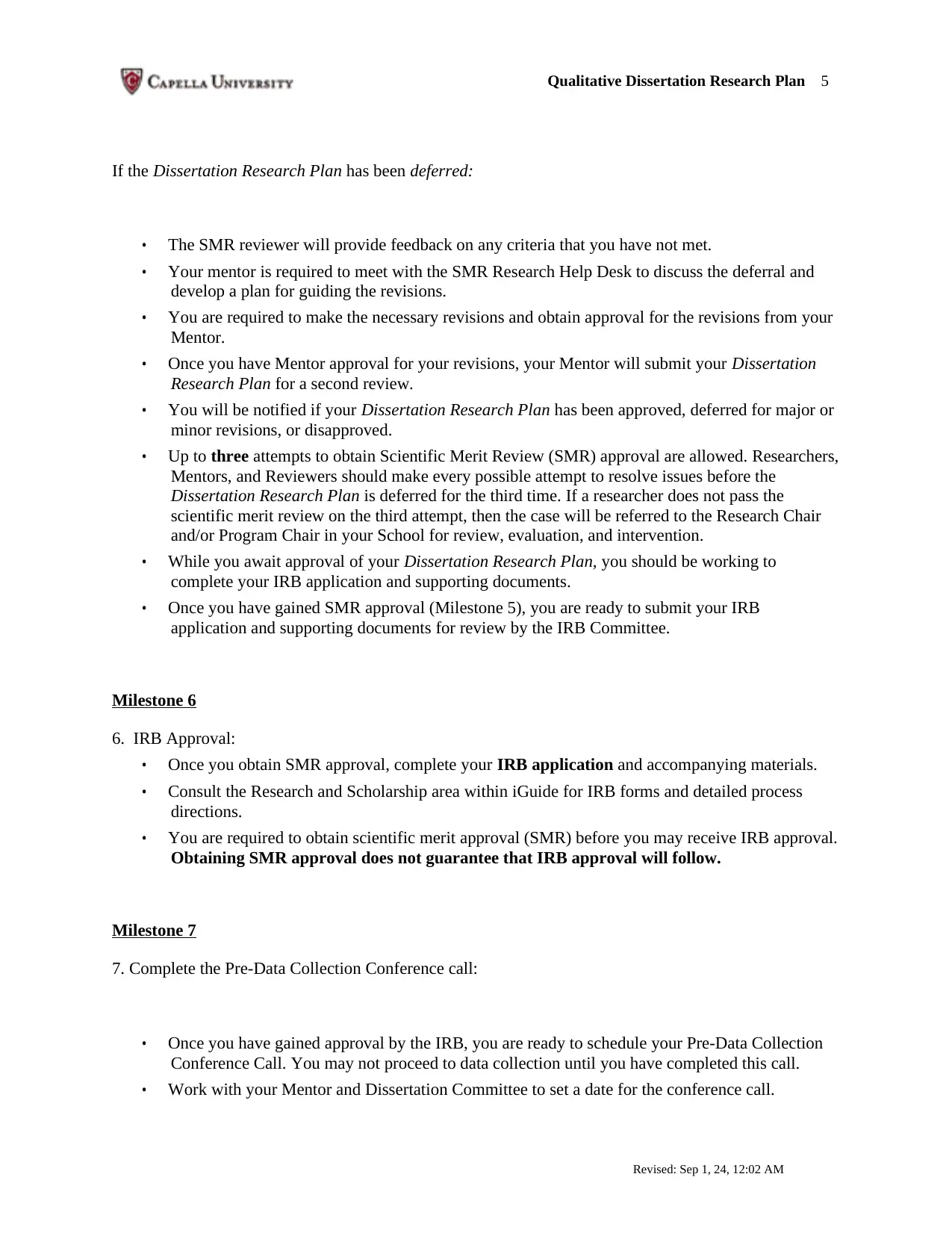
Qualitative Dissertation Research Plan 5
If the Dissertation Research Plan has been deferred:
• The SMR reviewer will provide feedback on any criteria that you have not met.
• Your mentor is required to meet with the SMR Research Help Desk to discuss the deferral and
develop a plan for guiding the revisions.
• You are required to make the necessary revisions and obtain approval for the revisions from your
Mentor.
• Once you have Mentor approval for your revisions, your Mentor will submit your Dissertation
Research Plan for a second review.
• You will be notified if your Dissertation Research Plan has been approved, deferred for major or
minor revisions, or disapproved.
• Up to three attempts to obtain Scientific Merit Review (SMR) approval are allowed. Researchers,
Mentors, and Reviewers should make every possible attempt to resolve issues before the
Dissertation Research Plan is deferred for the third time. If a researcher does not pass the
scientific merit review on the third attempt, then the case will be referred to the Research Chair
and/or Program Chair in your School for review, evaluation, and intervention.
• While you await approval of your Dissertation Research Plan, you should be working to
complete your IRB application and supporting documents.
• Once you have gained SMR approval (Milestone 5), you are ready to submit your IRB
application and supporting documents for review by the IRB Committee.
Milestone 6
6. IRB Approval:
• Once you obtain SMR approval, complete your IRB application and accompanying materials.
• Consult the Research and Scholarship area within iGuide for IRB forms and detailed process
directions.
• You are required to obtain scientific merit approval (SMR) before you may receive IRB approval.
Obtaining SMR approval does not guarantee that IRB approval will follow.
Milestone 7
7. Complete the Pre-Data Collection Conference call:
• Once you have gained approval by the IRB, you are ready to schedule your Pre-Data Collection
Conference Call. You may not proceed to data collection until you have completed this call.
• Work with your Mentor and Dissertation Committee to set a date for the conference call.
Revised: Sep 1, 24, 12:02 AM
If the Dissertation Research Plan has been deferred:
• The SMR reviewer will provide feedback on any criteria that you have not met.
• Your mentor is required to meet with the SMR Research Help Desk to discuss the deferral and
develop a plan for guiding the revisions.
• You are required to make the necessary revisions and obtain approval for the revisions from your
Mentor.
• Once you have Mentor approval for your revisions, your Mentor will submit your Dissertation
Research Plan for a second review.
• You will be notified if your Dissertation Research Plan has been approved, deferred for major or
minor revisions, or disapproved.
• Up to three attempts to obtain Scientific Merit Review (SMR) approval are allowed. Researchers,
Mentors, and Reviewers should make every possible attempt to resolve issues before the
Dissertation Research Plan is deferred for the third time. If a researcher does not pass the
scientific merit review on the third attempt, then the case will be referred to the Research Chair
and/or Program Chair in your School for review, evaluation, and intervention.
• While you await approval of your Dissertation Research Plan, you should be working to
complete your IRB application and supporting documents.
• Once you have gained SMR approval (Milestone 5), you are ready to submit your IRB
application and supporting documents for review by the IRB Committee.
Milestone 6
6. IRB Approval:
• Once you obtain SMR approval, complete your IRB application and accompanying materials.
• Consult the Research and Scholarship area within iGuide for IRB forms and detailed process
directions.
• You are required to obtain scientific merit approval (SMR) before you may receive IRB approval.
Obtaining SMR approval does not guarantee that IRB approval will follow.
Milestone 7
7. Complete the Pre-Data Collection Conference call:
• Once you have gained approval by the IRB, you are ready to schedule your Pre-Data Collection
Conference Call. You may not proceed to data collection until you have completed this call.
• Work with your Mentor and Dissertation Committee to set a date for the conference call.
Revised: Sep 1, 24, 12:02 AM
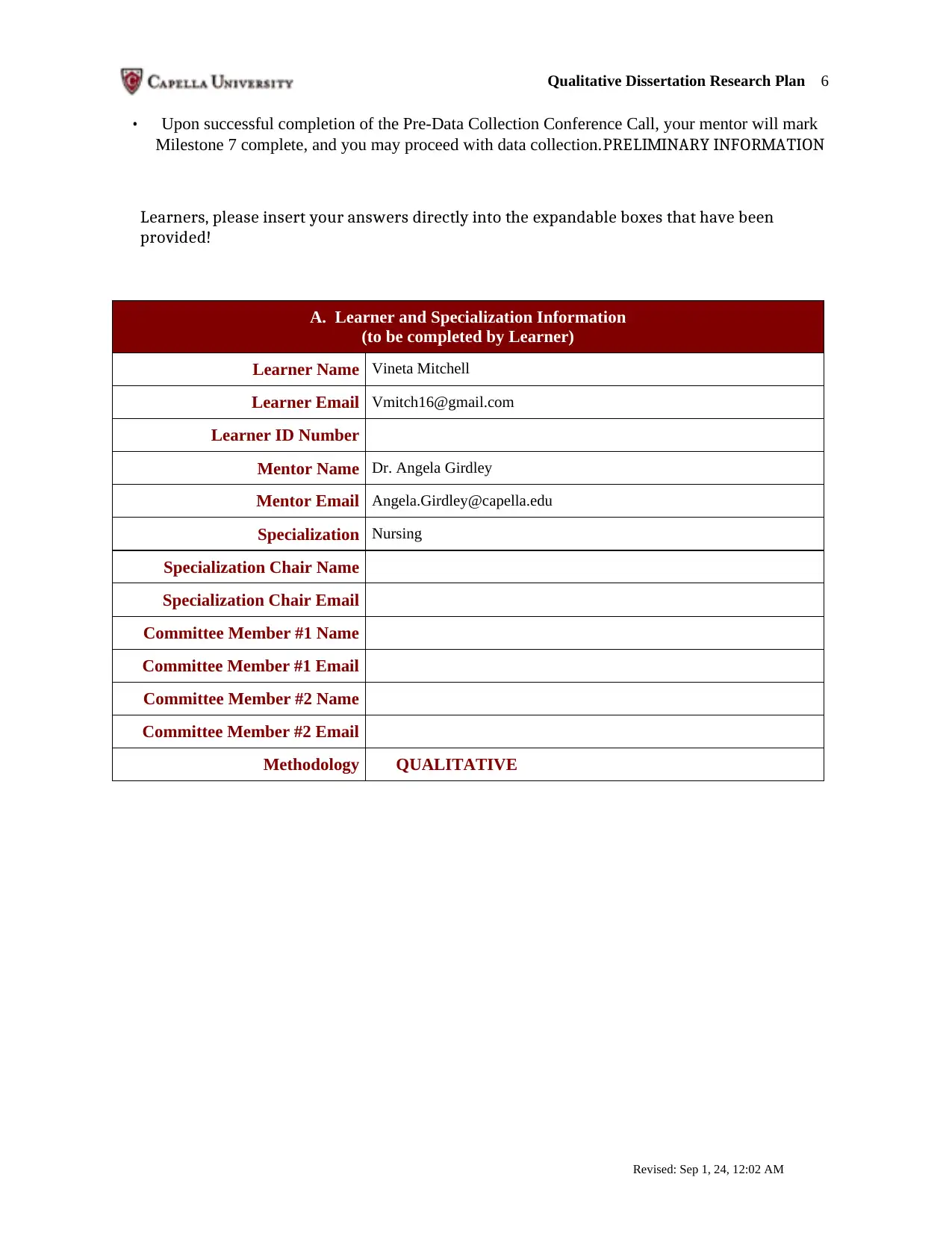
Qualitative Dissertation Research Plan 6
• Upon successful completion of the Pre-Data Collection Conference Call, your mentor will mark
Milestone 7 complete, and you may proceed with data collection.PRELIMINARY INFORMATION
Learners, please insert your answers directly into the expandable boxes that have been
provided!
A. Learner and Specialization Information
(to be completed by Learner)
Learner Name Vineta Mitchell
Learner Email Vmitch16@gmail.com
Learner ID Number
Mentor Name Dr. Angela Girdley
Mentor Email Angela.Girdley@capella.edu
Specialization Nursing
Specialization Chair Name
Specialization Chair Email
Committee Member #1 Name
Committee Member #1 Email
Committee Member #2 Name
Committee Member #2 Email
Methodology QUALITATIVE
Revised: Sep 1, 24, 12:02 AM
• Upon successful completion of the Pre-Data Collection Conference Call, your mentor will mark
Milestone 7 complete, and you may proceed with data collection.PRELIMINARY INFORMATION
Learners, please insert your answers directly into the expandable boxes that have been
provided!
A. Learner and Specialization Information
(to be completed by Learner)
Learner Name Vineta Mitchell
Learner Email Vmitch16@gmail.com
Learner ID Number
Mentor Name Dr. Angela Girdley
Mentor Email Angela.Girdley@capella.edu
Specialization Nursing
Specialization Chair Name
Specialization Chair Email
Committee Member #1 Name
Committee Member #1 Email
Committee Member #2 Name
Committee Member #2 Email
Methodology QUALITATIVE
Revised: Sep 1, 24, 12:02 AM
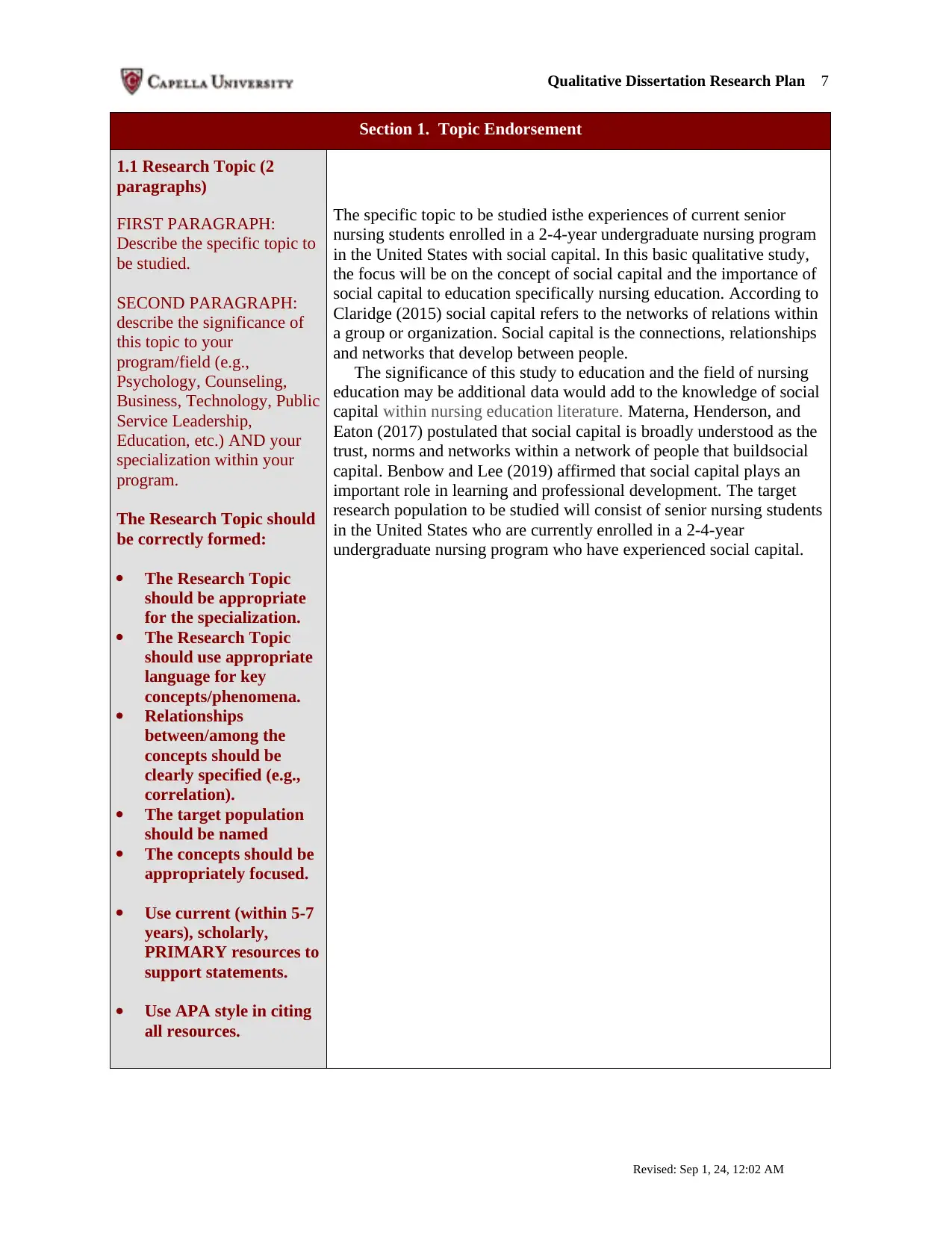
Qualitative Dissertation Research Plan 7
Section 1. Topic Endorsement
1.1 Research Topic (2
paragraphs)
FIRST PARAGRAPH:
Describe the specific topic to
be studied.
SECOND PARAGRAPH:
describe the significance of
this topic to your
program/field (e.g.,
Psychology, Counseling,
Business, Technology, Public
Service Leadership,
Education, etc.) AND your
specialization within your
program.
The Research Topic should
be correctly formed:
The Research Topic
should be appropriate
for the specialization.
The Research Topic
should use appropriate
language for key
concepts/phenomena.
Relationships
between/among the
concepts should be
clearly specified (e.g.,
correlation).
The target population
should be named
The concepts should be
appropriately focused.
Use current (within 5-7
years), scholarly,
PRIMARY resources to
support statements.
Use APA style in citing
all resources.
The specific topic to be studied isthe experiences of current senior
nursing students enrolled in a 2-4-year undergraduate nursing program
in the United States with social capital. In this basic qualitative study,
the focus will be on the concept of social capital and the importance of
social capital to education specifically nursing education. According to
Claridge (2015) social capital refers to the networks of relations within
a group or organization. Social capital is the connections, relationships
and networks that develop between people.
The significance of this study to education and the field of nursing
education may be additional data would add to the knowledge of social
capital within nursing education literature. Materna, Henderson, and
Eaton (2017) postulated that social capital is broadly understood as the
trust, norms and networks within a network of people that buildsocial
capital. Benbow and Lee (2019) affirmed that social capital plays an
important role in learning and professional development. The target
research population to be studied will consist of senior nursing students
in the United States who are currently enrolled in a 2-4-year
undergraduate nursing program who have experienced social capital.
Revised: Sep 1, 24, 12:02 AM
Section 1. Topic Endorsement
1.1 Research Topic (2
paragraphs)
FIRST PARAGRAPH:
Describe the specific topic to
be studied.
SECOND PARAGRAPH:
describe the significance of
this topic to your
program/field (e.g.,
Psychology, Counseling,
Business, Technology, Public
Service Leadership,
Education, etc.) AND your
specialization within your
program.
The Research Topic should
be correctly formed:
The Research Topic
should be appropriate
for the specialization.
The Research Topic
should use appropriate
language for key
concepts/phenomena.
Relationships
between/among the
concepts should be
clearly specified (e.g.,
correlation).
The target population
should be named
The concepts should be
appropriately focused.
Use current (within 5-7
years), scholarly,
PRIMARY resources to
support statements.
Use APA style in citing
all resources.
The specific topic to be studied isthe experiences of current senior
nursing students enrolled in a 2-4-year undergraduate nursing program
in the United States with social capital. In this basic qualitative study,
the focus will be on the concept of social capital and the importance of
social capital to education specifically nursing education. According to
Claridge (2015) social capital refers to the networks of relations within
a group or organization. Social capital is the connections, relationships
and networks that develop between people.
The significance of this study to education and the field of nursing
education may be additional data would add to the knowledge of social
capital within nursing education literature. Materna, Henderson, and
Eaton (2017) postulated that social capital is broadly understood as the
trust, norms and networks within a network of people that buildsocial
capital. Benbow and Lee (2019) affirmed that social capital plays an
important role in learning and professional development. The target
research population to be studied will consist of senior nursing students
in the United States who are currently enrolled in a 2-4-year
undergraduate nursing program who have experienced social capital.
Revised: Sep 1, 24, 12:02 AM
Paraphrase This Document
Need a fresh take? Get an instant paraphrase of this document with our AI Paraphraser
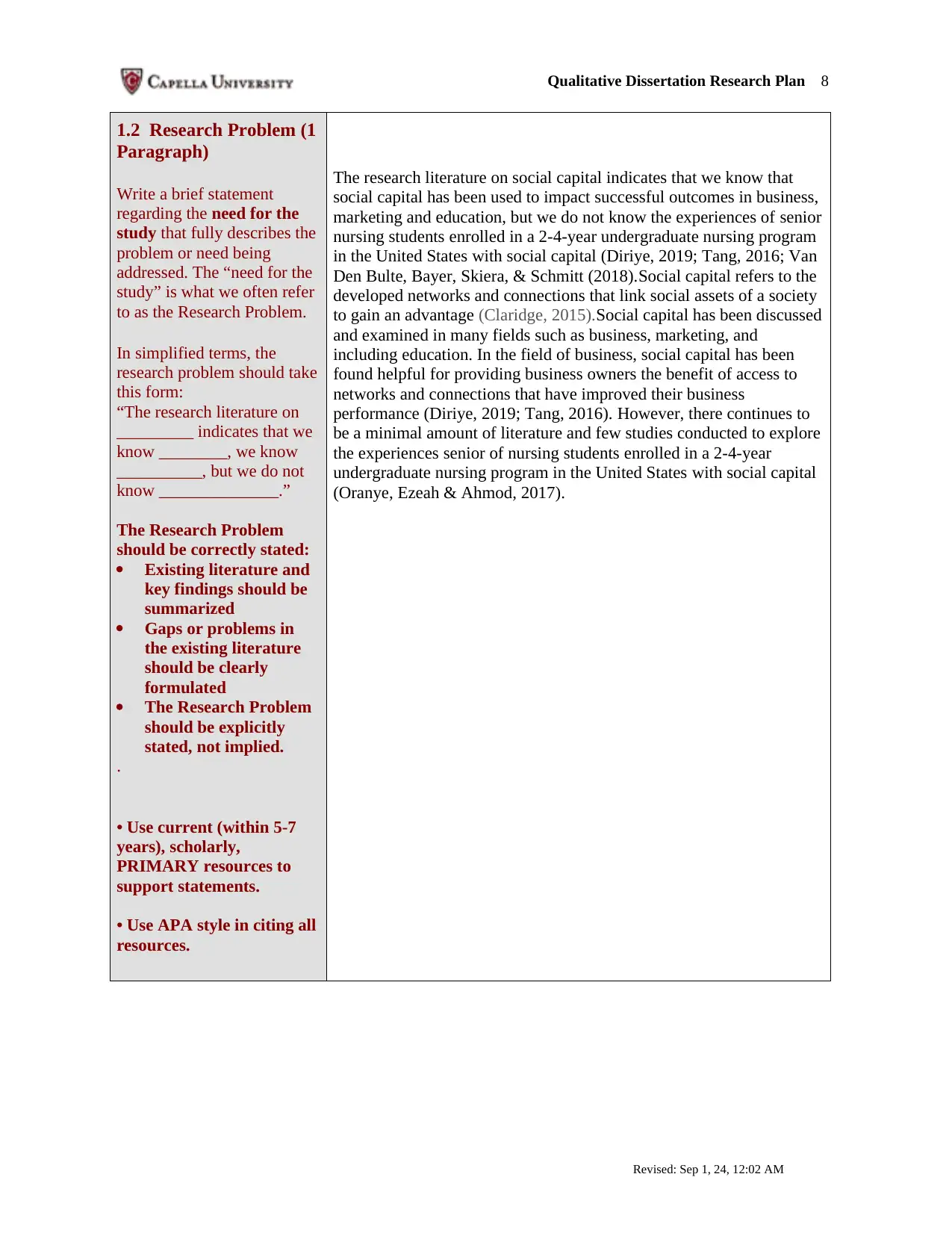
Qualitative Dissertation Research Plan 8
1.2 Research Problem (1
Paragraph)
Write a brief statement
regarding the need for the
study that fully describes the
problem or need being
addressed. The “need for the
study” is what we often refer
to as the Research Problem.
In simplified terms, the
research problem should take
this form:
“The research literature on
_________ indicates that we
know ________, we know
__________, but we do not
know ______________.”
The Research Problem
should be correctly stated:
Existing literature and
key findings should be
summarized
Gaps or problems in
the existing literature
should be clearly
formulated
The Research Problem
should be explicitly
stated, not implied.
.
• Use current (within 5-7
years), scholarly,
PRIMARY resources to
support statements.
• Use APA style in citing all
resources.
The research literature on social capital indicates that we know that
social capital has been used to impact successful outcomes in business,
marketing and education, but we do not know the experiences of senior
nursing students enrolled in a 2-4-year undergraduate nursing program
in the United States with social capital (Diriye, 2019; Tang, 2016; Van
Den Bulte, Bayer, Skiera, & Schmitt (2018).Social capital refers to the
developed networks and connections that link social assets of a society
to gain an advantage (Claridge, 2015).Social capital has been discussed
and examined in many fields such as business, marketing, and
including education. In the field of business, social capital has been
found helpful for providing business owners the benefit of access to
networks and connections that have improved their business
performance (Diriye, 2019; Tang, 2016). However, there continues to
be a minimal amount of literature and few studies conducted to explore
the experiences senior of nursing students enrolled in a 2-4-year
undergraduate nursing program in the United States with social capital
(Oranye, Ezeah & Ahmod, 2017).
Revised: Sep 1, 24, 12:02 AM
1.2 Research Problem (1
Paragraph)
Write a brief statement
regarding the need for the
study that fully describes the
problem or need being
addressed. The “need for the
study” is what we often refer
to as the Research Problem.
In simplified terms, the
research problem should take
this form:
“The research literature on
_________ indicates that we
know ________, we know
__________, but we do not
know ______________.”
The Research Problem
should be correctly stated:
Existing literature and
key findings should be
summarized
Gaps or problems in
the existing literature
should be clearly
formulated
The Research Problem
should be explicitly
stated, not implied.
.
• Use current (within 5-7
years), scholarly,
PRIMARY resources to
support statements.
• Use APA style in citing all
resources.
The research literature on social capital indicates that we know that
social capital has been used to impact successful outcomes in business,
marketing and education, but we do not know the experiences of senior
nursing students enrolled in a 2-4-year undergraduate nursing program
in the United States with social capital (Diriye, 2019; Tang, 2016; Van
Den Bulte, Bayer, Skiera, & Schmitt (2018).Social capital refers to the
developed networks and connections that link social assets of a society
to gain an advantage (Claridge, 2015).Social capital has been discussed
and examined in many fields such as business, marketing, and
including education. In the field of business, social capital has been
found helpful for providing business owners the benefit of access to
networks and connections that have improved their business
performance (Diriye, 2019; Tang, 2016). However, there continues to
be a minimal amount of literature and few studies conducted to explore
the experiences senior of nursing students enrolled in a 2-4-year
undergraduate nursing program in the United States with social capital
(Oranye, Ezeah & Ahmod, 2017).
Revised: Sep 1, 24, 12:02 AM
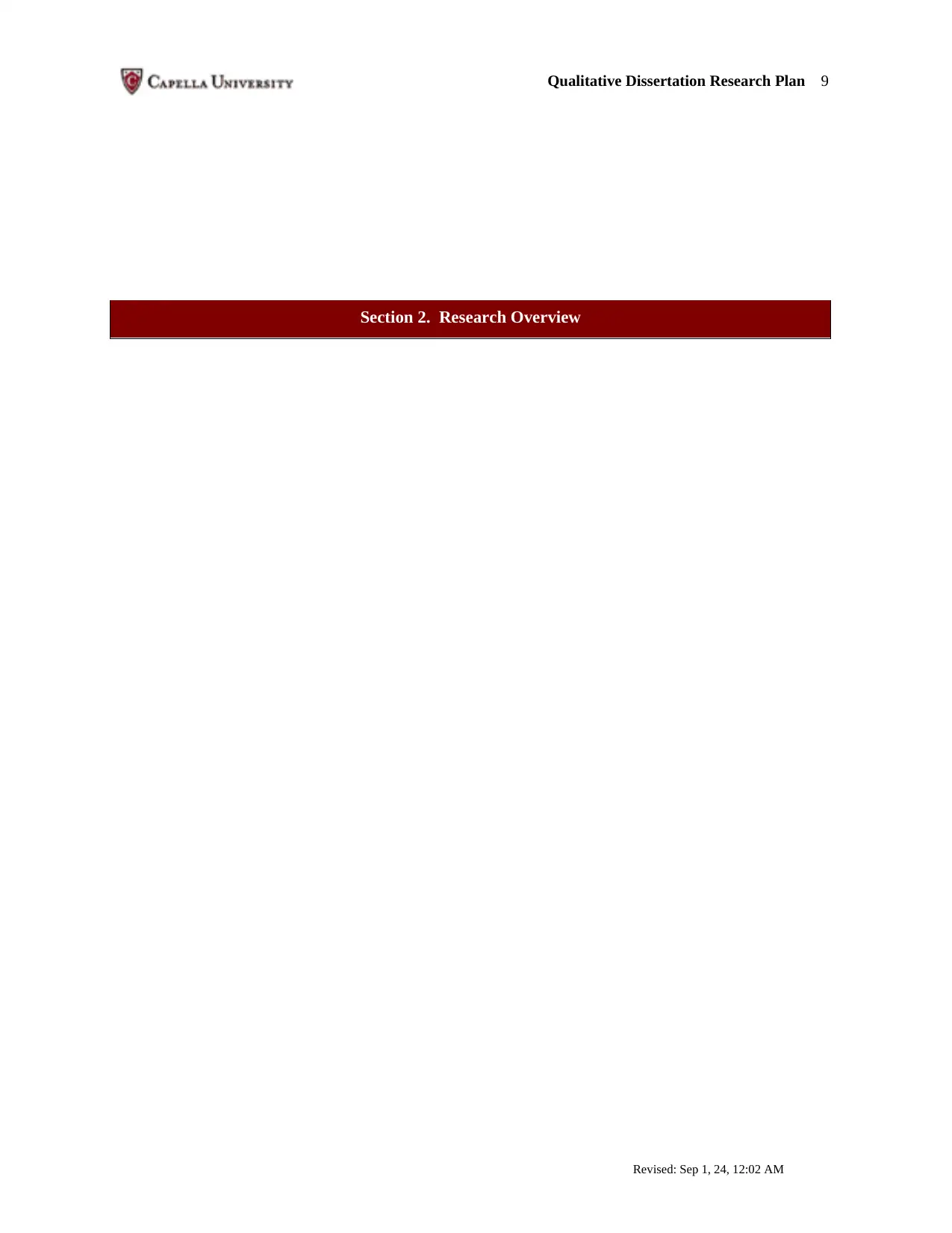
Qualitative Dissertation Research Plan 9
Section 2. Research Overview
Revised: Sep 1, 24, 12:02 AM
Section 2. Research Overview
Revised: Sep 1, 24, 12:02 AM
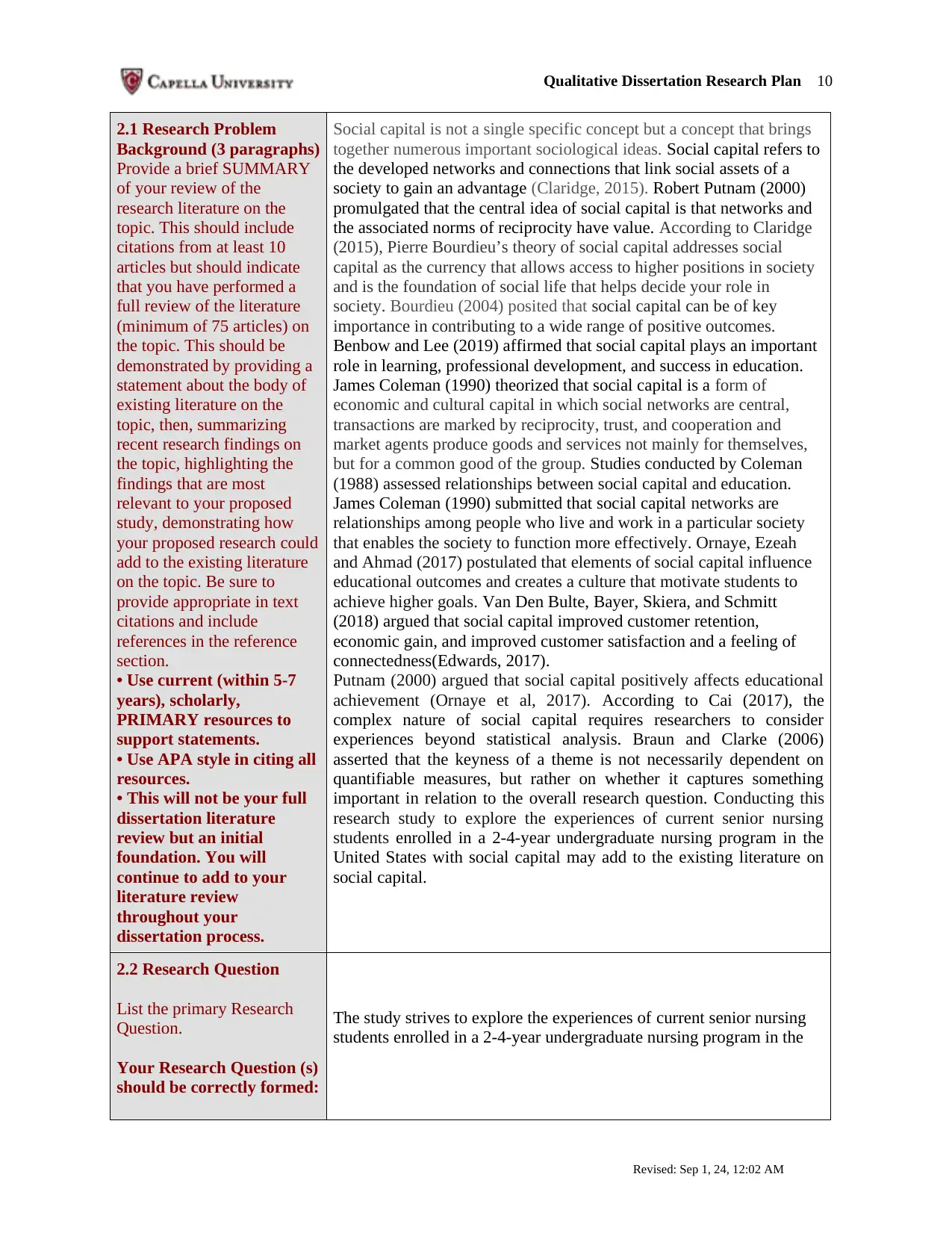
Qualitative Dissertation Research Plan 10
2.1 Research Problem
Background (3 paragraphs)
Provide a brief SUMMARY
of your review of the
research literature on the
topic. This should include
citations from at least 10
articles but should indicate
that you have performed a
full review of the literature
(minimum of 75 articles) on
the topic. This should be
demonstrated by providing a
statement about the body of
existing literature on the
topic, then, summarizing
recent research findings on
the topic, highlighting the
findings that are most
relevant to your proposed
study, demonstrating how
your proposed research could
add to the existing literature
on the topic. Be sure to
provide appropriate in text
citations and include
references in the reference
section.
• Use current (within 5-7
years), scholarly,
PRIMARY resources to
support statements.
• Use APA style in citing all
resources.
• This will not be your full
dissertation literature
review but an initial
foundation. You will
continue to add to your
literature review
throughout your
dissertation process.
Social capital is not a single specific concept but a concept that brings
together numerous important sociological ideas. Social capital refers to
the developed networks and connections that link social assets of a
society to gain an advantage (Claridge, 2015). Robert Putnam (2000)
promulgated that the central idea of social capital is that networks and
the associated norms of reciprocity have value. According to Claridge
(2015), Pierre Bourdieu’s theory of social capital addresses social
capital as the currency that allows access to higher positions in society
and is the foundation of social life that helps decide your role in
society. Bourdieu (2004) posited that social capital can be of key
importance in contributing to a wide range of positive outcomes.
Benbow and Lee (2019) affirmed that social capital plays an important
role in learning, professional development, and success in education.
James Coleman (1990) theorized that social capital is a form of
economic and cultural capital in which social networks are central,
transactions are marked by reciprocity, trust, and cooperation and
market agents produce goods and services not mainly for themselves,
but for a common good of the group. Studies conducted by Coleman
(1988) assessed relationships between social capital and education.
James Coleman (1990) submitted that social capital networks are
relationships among people who live and work in a particular society
that enables the society to function more effectively. Ornaye, Ezeah
and Ahmad (2017) postulated that elements of social capital influence
educational outcomes and creates a culture that motivate students to
achieve higher goals. Van Den Bulte, Bayer, Skiera, and Schmitt
(2018) argued that social capital improved customer retention,
economic gain, and improved customer satisfaction and a feeling of
connectedness(Edwards, 2017).
Putnam (2000) argued that social capital positively affects educational
achievement (Ornaye et al, 2017). According to Cai (2017), the
complex nature of social capital requires researchers to consider
experiences beyond statistical analysis. Braun and Clarke (2006)
asserted that the keyness of a theme is not necessarily dependent on
quantifiable measures, but rather on whether it captures something
important in relation to the overall research question. Conducting this
research study to explore the experiences of current senior nursing
students enrolled in a 2-4-year undergraduate nursing program in the
United States with social capital may add to the existing literature on
social capital.
2.2 Research Question
List the primary Research
Question.
Your Research Question (s)
should be correctly formed:
The study strives to explore the experiences of current senior nursing
students enrolled in a 2-4-year undergraduate nursing program in the
Revised: Sep 1, 24, 12:02 AM
2.1 Research Problem
Background (3 paragraphs)
Provide a brief SUMMARY
of your review of the
research literature on the
topic. This should include
citations from at least 10
articles but should indicate
that you have performed a
full review of the literature
(minimum of 75 articles) on
the topic. This should be
demonstrated by providing a
statement about the body of
existing literature on the
topic, then, summarizing
recent research findings on
the topic, highlighting the
findings that are most
relevant to your proposed
study, demonstrating how
your proposed research could
add to the existing literature
on the topic. Be sure to
provide appropriate in text
citations and include
references in the reference
section.
• Use current (within 5-7
years), scholarly,
PRIMARY resources to
support statements.
• Use APA style in citing all
resources.
• This will not be your full
dissertation literature
review but an initial
foundation. You will
continue to add to your
literature review
throughout your
dissertation process.
Social capital is not a single specific concept but a concept that brings
together numerous important sociological ideas. Social capital refers to
the developed networks and connections that link social assets of a
society to gain an advantage (Claridge, 2015). Robert Putnam (2000)
promulgated that the central idea of social capital is that networks and
the associated norms of reciprocity have value. According to Claridge
(2015), Pierre Bourdieu’s theory of social capital addresses social
capital as the currency that allows access to higher positions in society
and is the foundation of social life that helps decide your role in
society. Bourdieu (2004) posited that social capital can be of key
importance in contributing to a wide range of positive outcomes.
Benbow and Lee (2019) affirmed that social capital plays an important
role in learning, professional development, and success in education.
James Coleman (1990) theorized that social capital is a form of
economic and cultural capital in which social networks are central,
transactions are marked by reciprocity, trust, and cooperation and
market agents produce goods and services not mainly for themselves,
but for a common good of the group. Studies conducted by Coleman
(1988) assessed relationships between social capital and education.
James Coleman (1990) submitted that social capital networks are
relationships among people who live and work in a particular society
that enables the society to function more effectively. Ornaye, Ezeah
and Ahmad (2017) postulated that elements of social capital influence
educational outcomes and creates a culture that motivate students to
achieve higher goals. Van Den Bulte, Bayer, Skiera, and Schmitt
(2018) argued that social capital improved customer retention,
economic gain, and improved customer satisfaction and a feeling of
connectedness(Edwards, 2017).
Putnam (2000) argued that social capital positively affects educational
achievement (Ornaye et al, 2017). According to Cai (2017), the
complex nature of social capital requires researchers to consider
experiences beyond statistical analysis. Braun and Clarke (2006)
asserted that the keyness of a theme is not necessarily dependent on
quantifiable measures, but rather on whether it captures something
important in relation to the overall research question. Conducting this
research study to explore the experiences of current senior nursing
students enrolled in a 2-4-year undergraduate nursing program in the
United States with social capital may add to the existing literature on
social capital.
2.2 Research Question
List the primary Research
Question.
Your Research Question (s)
should be correctly formed:
The study strives to explore the experiences of current senior nursing
students enrolled in a 2-4-year undergraduate nursing program in the
Revised: Sep 1, 24, 12:02 AM
Secure Best Marks with AI Grader
Need help grading? Try our AI Grader for instant feedback on your assignments.
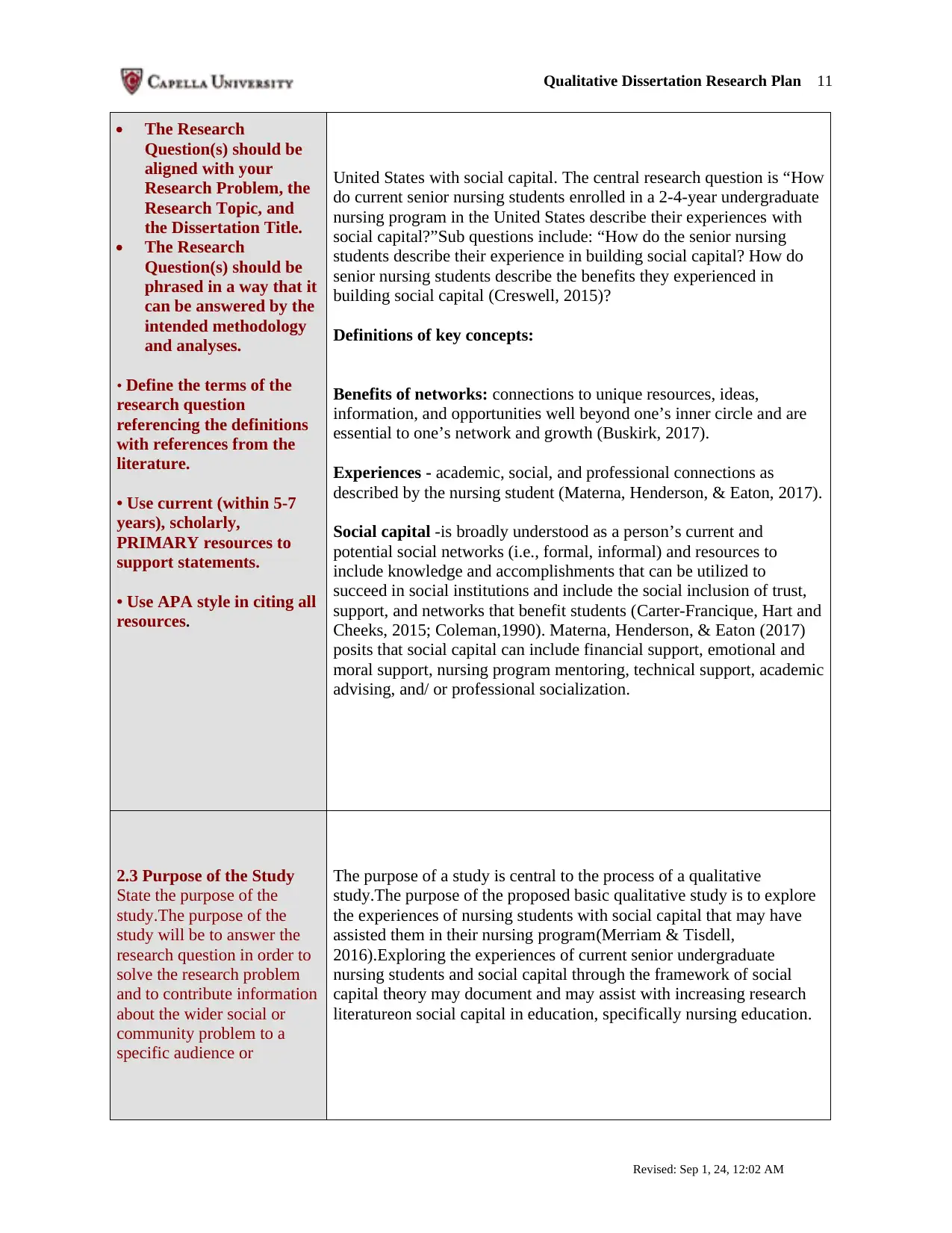
Qualitative Dissertation Research Plan 11
The Research
Question(s) should be
aligned with your
Research Problem, the
Research Topic, and
the Dissertation Title.
The Research
Question(s) should be
phrased in a way that it
can be answered by the
intended methodology
and analyses.
• Define the terms of the
research question
referencing the definitions
with references from the
literature.
• Use current (within 5-7
years), scholarly,
PRIMARY resources to
support statements.
• Use APA style in citing all
resources.
United States with social capital. The central research question is “How
do current senior nursing students enrolled in a 2-4-year undergraduate
nursing program in the United States describe their experiences with
social capital?”Sub questions include: “How do the senior nursing
students describe their experience in building social capital? How do
senior nursing students describe the benefits they experienced in
building social capital (Creswell, 2015)?
Definitions of key concepts:
Benefits of networks: connections to unique resources, ideas,
information, and opportunities well beyond one’s inner circle and are
essential to one’s network and growth (Buskirk, 2017).
Experiences - academic, social, and professional connections as
described by the nursing student (Materna, Henderson, & Eaton, 2017).
Social capital -is broadly understood as a person’s current and
potential social networks (i.e., formal, informal) and resources to
include knowledge and accomplishments that can be utilized to
succeed in social institutions and include the social inclusion of trust,
support, and networks that benefit students (Carter-Francique, Hart and
Cheeks, 2015; Coleman,1990). Materna, Henderson, & Eaton (2017)
posits that social capital can include financial support, emotional and
moral support, nursing program mentoring, technical support, academic
advising, and/ or professional socialization.
2.3 Purpose of the Study
State the purpose of the
study.The purpose of the
study will be to answer the
research question in order to
solve the research problem
and to contribute information
about the wider social or
community problem to a
specific audience or
The purpose of a study is central to the process of a qualitative
study.The purpose of the proposed basic qualitative study is to explore
the experiences of nursing students with social capital that may have
assisted them in their nursing program(Merriam & Tisdell,
2016).Exploring the experiences of current senior undergraduate
nursing students and social capital through the framework of social
capital theory may document and may assist with increasing research
literatureon social capital in education, specifically nursing education.
Revised: Sep 1, 24, 12:02 AM
The Research
Question(s) should be
aligned with your
Research Problem, the
Research Topic, and
the Dissertation Title.
The Research
Question(s) should be
phrased in a way that it
can be answered by the
intended methodology
and analyses.
• Define the terms of the
research question
referencing the definitions
with references from the
literature.
• Use current (within 5-7
years), scholarly,
PRIMARY resources to
support statements.
• Use APA style in citing all
resources.
United States with social capital. The central research question is “How
do current senior nursing students enrolled in a 2-4-year undergraduate
nursing program in the United States describe their experiences with
social capital?”Sub questions include: “How do the senior nursing
students describe their experience in building social capital? How do
senior nursing students describe the benefits they experienced in
building social capital (Creswell, 2015)?
Definitions of key concepts:
Benefits of networks: connections to unique resources, ideas,
information, and opportunities well beyond one’s inner circle and are
essential to one’s network and growth (Buskirk, 2017).
Experiences - academic, social, and professional connections as
described by the nursing student (Materna, Henderson, & Eaton, 2017).
Social capital -is broadly understood as a person’s current and
potential social networks (i.e., formal, informal) and resources to
include knowledge and accomplishments that can be utilized to
succeed in social institutions and include the social inclusion of trust,
support, and networks that benefit students (Carter-Francique, Hart and
Cheeks, 2015; Coleman,1990). Materna, Henderson, & Eaton (2017)
posits that social capital can include financial support, emotional and
moral support, nursing program mentoring, technical support, academic
advising, and/ or professional socialization.
2.3 Purpose of the Study
State the purpose of the
study.The purpose of the
study will be to answer the
research question in order to
solve the research problem
and to contribute information
about the wider social or
community problem to a
specific audience or
The purpose of a study is central to the process of a qualitative
study.The purpose of the proposed basic qualitative study is to explore
the experiences of nursing students with social capital that may have
assisted them in their nursing program(Merriam & Tisdell,
2016).Exploring the experiences of current senior undergraduate
nursing students and social capital through the framework of social
capital theory may document and may assist with increasing research
literatureon social capital in education, specifically nursing education.
Revised: Sep 1, 24, 12:02 AM
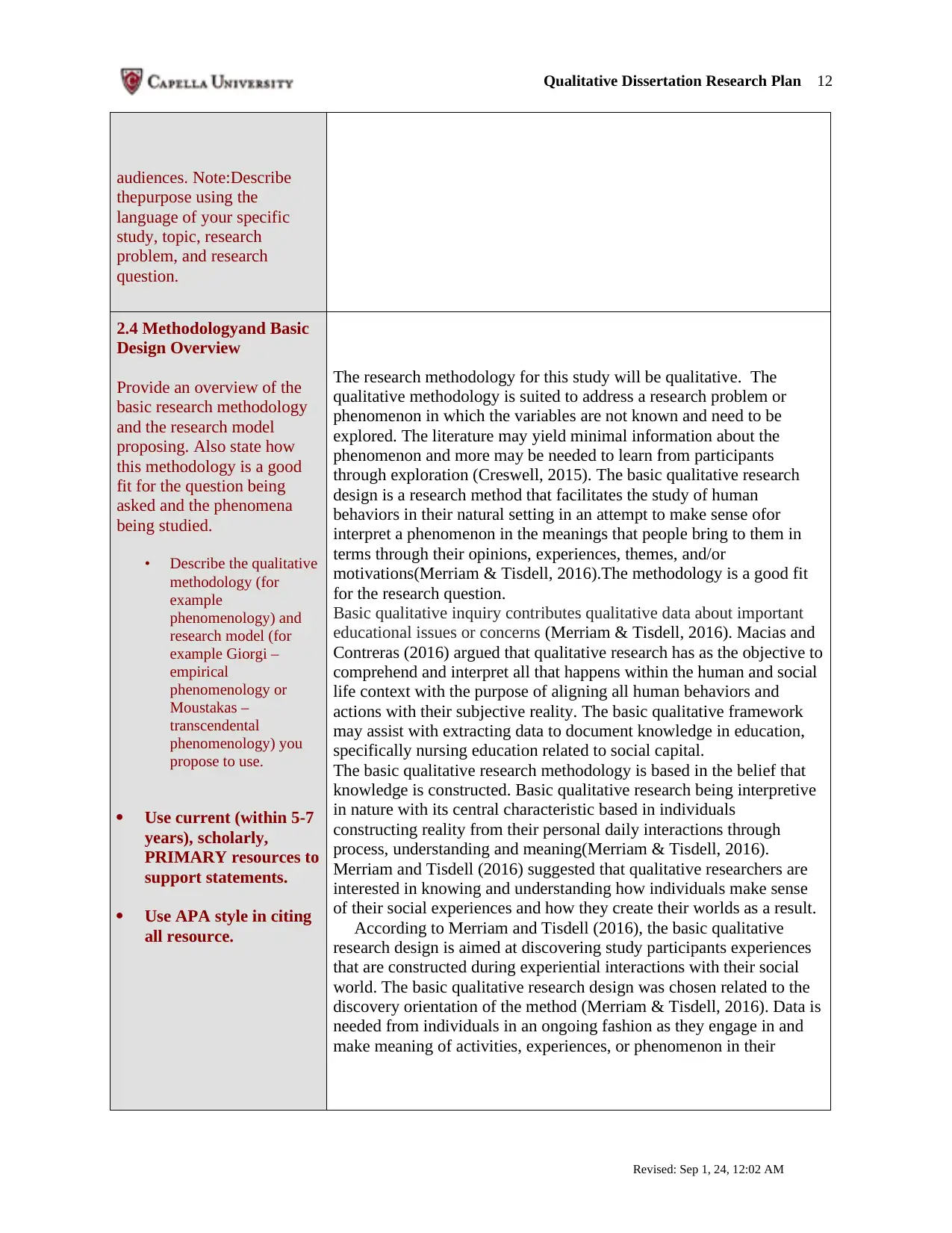
Qualitative Dissertation Research Plan 12
audiences. Note:Describe
thepurpose using the
language of your specific
study, topic, research
problem, and research
question.
2.4 Methodologyand Basic
Design Overview
Provide an overview of the
basic research methodology
and the research model
proposing. Also state how
this methodology is a good
fit for the question being
asked and the phenomena
being studied.
• Describe the qualitative
methodology (for
example
phenomenology) and
research model (for
example Giorgi –
empirical
phenomenology or
Moustakas –
transcendental
phenomenology) you
propose to use.
Use current (within 5-7
years), scholarly,
PRIMARY resources to
support statements.
Use APA style in citing
all resource.
The research methodology for this study will be qualitative. The
qualitative methodology is suited to address a research problem or
phenomenon in which the variables are not known and need to be
explored. The literature may yield minimal information about the
phenomenon and more may be needed to learn from participants
through exploration (Creswell, 2015). The basic qualitative research
design is a research method that facilitates the study of human
behaviors in their natural setting in an attempt to make sense ofor
interpret a phenomenon in the meanings that people bring to them in
terms through their opinions, experiences, themes, and/or
motivations(Merriam & Tisdell, 2016).The methodology is a good fit
for the research question.
Basic qualitative inquiry contributes qualitative data about important
educational issues or concerns (Merriam & Tisdell, 2016). Macias and
Contreras (2016) argued that qualitative research has as the objective to
comprehend and interpret all that happens within the human and social
life context with the purpose of aligning all human behaviors and
actions with their subjective reality. The basic qualitative framework
may assist with extracting data to document knowledge in education,
specifically nursing education related to social capital.
The basic qualitative research methodology is based in the belief that
knowledge is constructed. Basic qualitative research being interpretive
in nature with its central characteristic based in individuals
constructing reality from their personal daily interactions through
process, understanding and meaning(Merriam & Tisdell, 2016).
Merriam and Tisdell (2016) suggested that qualitative researchers are
interested in knowing and understanding how individuals make sense
of their social experiences and how they create their worlds as a result.
According to Merriam and Tisdell (2016), the basic qualitative
research design is aimed at discovering study participants experiences
that are constructed during experiential interactions with their social
world. The basic qualitative research design was chosen related to the
discovery orientation of the method (Merriam & Tisdell, 2016). Data is
needed from individuals in an ongoing fashion as they engage in and
make meaning of activities, experiences, or phenomenon in their
Revised: Sep 1, 24, 12:02 AM
audiences. Note:Describe
thepurpose using the
language of your specific
study, topic, research
problem, and research
question.
2.4 Methodologyand Basic
Design Overview
Provide an overview of the
basic research methodology
and the research model
proposing. Also state how
this methodology is a good
fit for the question being
asked and the phenomena
being studied.
• Describe the qualitative
methodology (for
example
phenomenology) and
research model (for
example Giorgi –
empirical
phenomenology or
Moustakas –
transcendental
phenomenology) you
propose to use.
Use current (within 5-7
years), scholarly,
PRIMARY resources to
support statements.
Use APA style in citing
all resource.
The research methodology for this study will be qualitative. The
qualitative methodology is suited to address a research problem or
phenomenon in which the variables are not known and need to be
explored. The literature may yield minimal information about the
phenomenon and more may be needed to learn from participants
through exploration (Creswell, 2015). The basic qualitative research
design is a research method that facilitates the study of human
behaviors in their natural setting in an attempt to make sense ofor
interpret a phenomenon in the meanings that people bring to them in
terms through their opinions, experiences, themes, and/or
motivations(Merriam & Tisdell, 2016).The methodology is a good fit
for the research question.
Basic qualitative inquiry contributes qualitative data about important
educational issues or concerns (Merriam & Tisdell, 2016). Macias and
Contreras (2016) argued that qualitative research has as the objective to
comprehend and interpret all that happens within the human and social
life context with the purpose of aligning all human behaviors and
actions with their subjective reality. The basic qualitative framework
may assist with extracting data to document knowledge in education,
specifically nursing education related to social capital.
The basic qualitative research methodology is based in the belief that
knowledge is constructed. Basic qualitative research being interpretive
in nature with its central characteristic based in individuals
constructing reality from their personal daily interactions through
process, understanding and meaning(Merriam & Tisdell, 2016).
Merriam and Tisdell (2016) suggested that qualitative researchers are
interested in knowing and understanding how individuals make sense
of their social experiences and how they create their worlds as a result.
According to Merriam and Tisdell (2016), the basic qualitative
research design is aimed at discovering study participants experiences
that are constructed during experiential interactions with their social
world. The basic qualitative research design was chosen related to the
discovery orientation of the method (Merriam & Tisdell, 2016). Data is
needed from individuals in an ongoing fashion as they engage in and
make meaning of activities, experiences, or phenomenon in their
Revised: Sep 1, 24, 12:02 AM
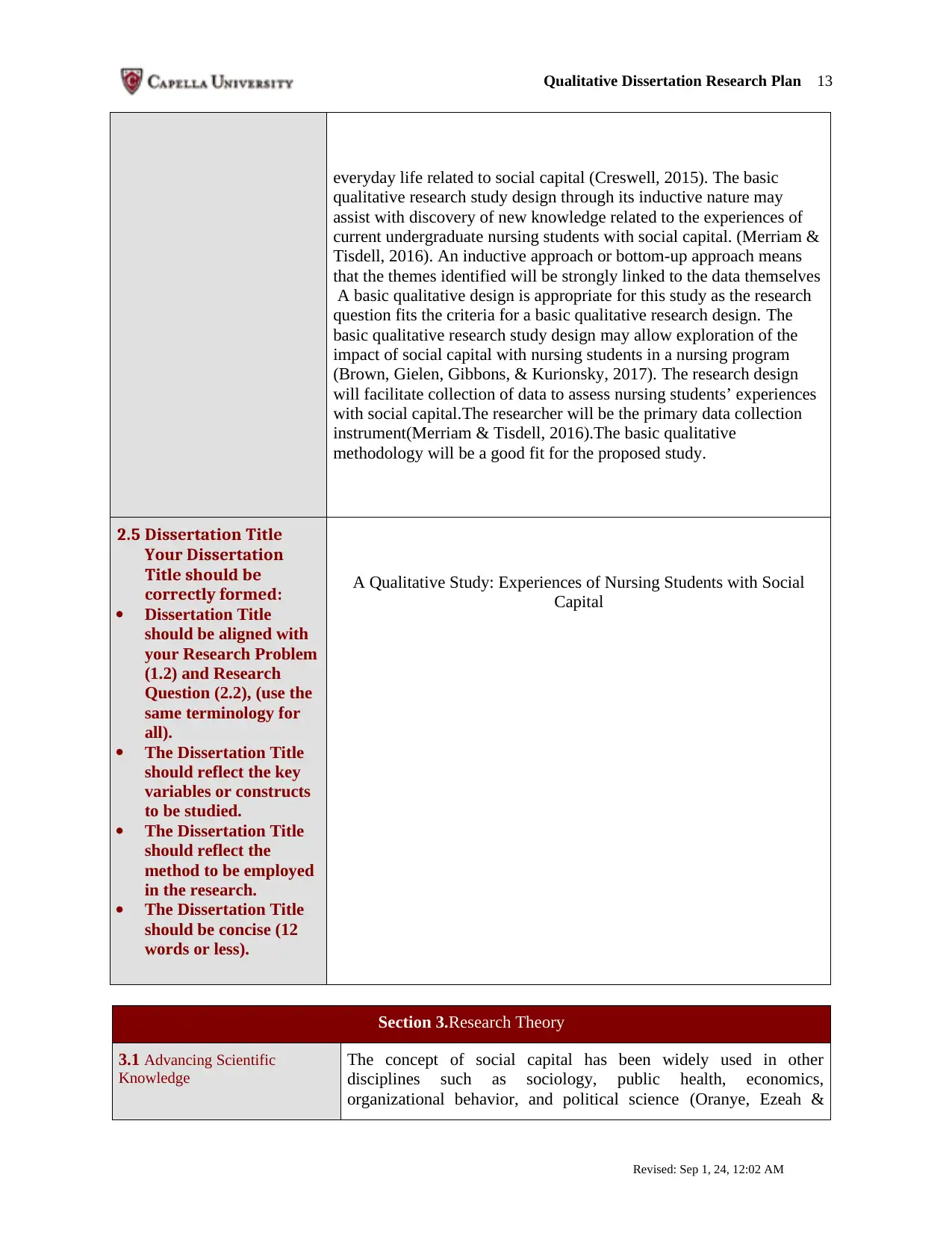
Qualitative Dissertation Research Plan 13
everyday life related to social capital (Creswell, 2015). The basic
qualitative research study design through its inductive nature may
assist with discovery of new knowledge related to the experiences of
current undergraduate nursing students with social capital. (Merriam &
Tisdell, 2016). An inductive approach or bottom-up approach means
that the themes identified will be strongly linked to the data themselves
A basic qualitative design is appropriate for this study as the research
question fits the criteria for a basic qualitative research design. The
basic qualitative research study design may allow exploration of the
impact of social capital with nursing students in a nursing program
(Brown, Gielen, Gibbons, & Kurionsky, 2017). The research design
will facilitate collection of data to assess nursing students’ experiences
with social capital.The researcher will be the primary data collection
instrument(Merriam & Tisdell, 2016).The basic qualitative
methodology will be a good fit for the proposed study.
2.5 Dissertation Title
Your Dissertation
Title should be
correctly formed:
Dissertation Title
should be aligned with
your Research Problem
(1.2) and Research
Question (2.2), (use the
same terminology for
all).
The Dissertation Title
should reflect the key
variables or constructs
to be studied.
The Dissertation Title
should reflect the
method to be employed
in the research.
The Dissertation Title
should be concise (12
words or less).
A Qualitative Study: Experiences of Nursing Students with Social
Capital
Section 3.Research Theory
3.1 Advancing Scientific
Knowledge
The concept of social capital has been widely used in other
disciplines such as sociology, public health, economics,
organizational behavior, and political science (Oranye, Ezeah &
Revised: Sep 1, 24, 12:02 AM
everyday life related to social capital (Creswell, 2015). The basic
qualitative research study design through its inductive nature may
assist with discovery of new knowledge related to the experiences of
current undergraduate nursing students with social capital. (Merriam &
Tisdell, 2016). An inductive approach or bottom-up approach means
that the themes identified will be strongly linked to the data themselves
A basic qualitative design is appropriate for this study as the research
question fits the criteria for a basic qualitative research design. The
basic qualitative research study design may allow exploration of the
impact of social capital with nursing students in a nursing program
(Brown, Gielen, Gibbons, & Kurionsky, 2017). The research design
will facilitate collection of data to assess nursing students’ experiences
with social capital.The researcher will be the primary data collection
instrument(Merriam & Tisdell, 2016).The basic qualitative
methodology will be a good fit for the proposed study.
2.5 Dissertation Title
Your Dissertation
Title should be
correctly formed:
Dissertation Title
should be aligned with
your Research Problem
(1.2) and Research
Question (2.2), (use the
same terminology for
all).
The Dissertation Title
should reflect the key
variables or constructs
to be studied.
The Dissertation Title
should reflect the
method to be employed
in the research.
The Dissertation Title
should be concise (12
words or less).
A Qualitative Study: Experiences of Nursing Students with Social
Capital
Section 3.Research Theory
3.1 Advancing Scientific
Knowledge
The concept of social capital has been widely used in other
disciplines such as sociology, public health, economics,
organizational behavior, and political science (Oranye, Ezeah &
Revised: Sep 1, 24, 12:02 AM
Paraphrase This Document
Need a fresh take? Get an instant paraphrase of this document with our AI Paraphraser
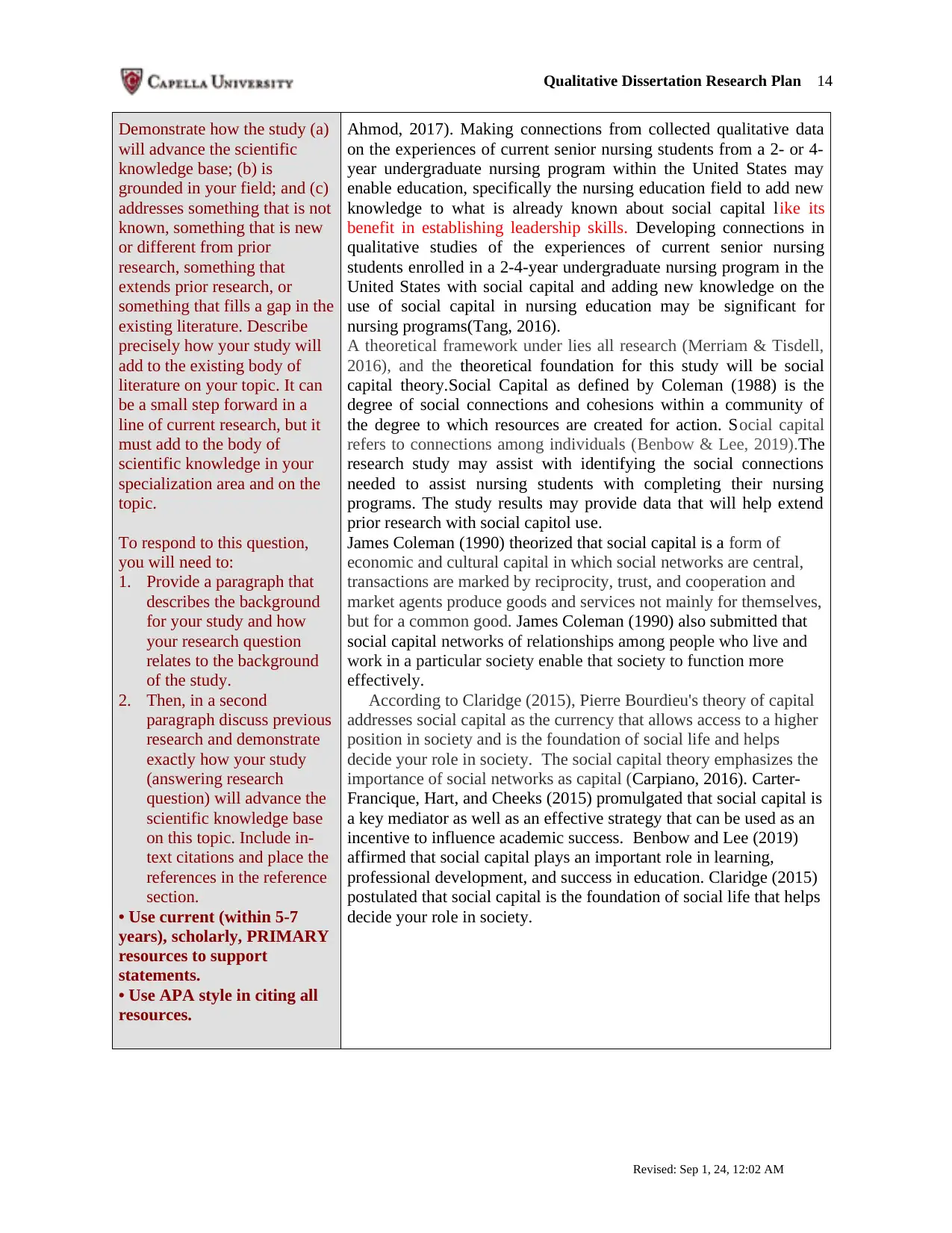
Qualitative Dissertation Research Plan 14
Demonstrate how the study (a)
will advance the scientific
knowledge base; (b) is
grounded in your field; and (c)
addresses something that is not
known, something that is new
or different from prior
research, something that
extends prior research, or
something that fills a gap in the
existing literature. Describe
precisely how your study will
add to the existing body of
literature on your topic. It can
be a small step forward in a
line of current research, but it
must add to the body of
scientific knowledge in your
specialization area and on the
topic.
To respond to this question,
you will need to:
1. Provide a paragraph that
describes the background
for your study and how
your research question
relates to the background
of the study.
2. Then, in a second
paragraph discuss previous
research and demonstrate
exactly how your study
(answering research
question) will advance the
scientific knowledge base
on this topic. Include in-
text citations and place the
references in the reference
section.
• Use current (within 5-7
years), scholarly, PRIMARY
resources to support
statements.
• Use APA style in citing all
resources.
Ahmod, 2017). Making connections from collected qualitative data
on the experiences of current senior nursing students from a 2- or 4-
year undergraduate nursing program within the United States may
enable education, specifically the nursing education field to add new
knowledge to what is already known about social capital like its
benefit in establishing leadership skills. Developing connections in
qualitative studies of the experiences of current senior nursing
students enrolled in a 2-4-year undergraduate nursing program in the
United States with social capital and adding new knowledge on the
use of social capital in nursing education may be significant for
nursing programs(Tang, 2016).
A theoretical framework under lies all research (Merriam & Tisdell,
2016), and the theoretical foundation for this study will be social
capital theory.Social Capital as defined by Coleman (1988) is the
degree of social connections and cohesions within a community of
the degree to which resources are created for action. Social capital
refers to connections among individuals (Benbow & Lee, 2019).The
research study may assist with identifying the social connections
needed to assist nursing students with completing their nursing
programs. The study results may provide data that will help extend
prior research with social capitol use.
James Coleman (1990) theorized that social capital is a form of
economic and cultural capital in which social networks are central,
transactions are marked by reciprocity, trust, and cooperation and
market agents produce goods and services not mainly for themselves,
but for a common good. James Coleman (1990) also submitted that
social capital networks of relationships among people who live and
work in a particular society enable that society to function more
effectively.
According to Claridge (2015), Pierre Bourdieu's theory of capital
addresses social capital as the currency that allows access to a higher
position in society and is the foundation of social life and helps
decide your role in society. The social capital theory emphasizes the
importance of social networks as capital (Carpiano, 2016). Carter-
Francique, Hart, and Cheeks (2015) promulgated that social capital is
a key mediator as well as an effective strategy that can be used as an
incentive to influence academic success. Benbow and Lee (2019)
affirmed that social capital plays an important role in learning,
professional development, and success in education. Claridge (2015)
postulated that social capital is the foundation of social life that helps
decide your role in society.
Revised: Sep 1, 24, 12:02 AM
Demonstrate how the study (a)
will advance the scientific
knowledge base; (b) is
grounded in your field; and (c)
addresses something that is not
known, something that is new
or different from prior
research, something that
extends prior research, or
something that fills a gap in the
existing literature. Describe
precisely how your study will
add to the existing body of
literature on your topic. It can
be a small step forward in a
line of current research, but it
must add to the body of
scientific knowledge in your
specialization area and on the
topic.
To respond to this question,
you will need to:
1. Provide a paragraph that
describes the background
for your study and how
your research question
relates to the background
of the study.
2. Then, in a second
paragraph discuss previous
research and demonstrate
exactly how your study
(answering research
question) will advance the
scientific knowledge base
on this topic. Include in-
text citations and place the
references in the reference
section.
• Use current (within 5-7
years), scholarly, PRIMARY
resources to support
statements.
• Use APA style in citing all
resources.
Ahmod, 2017). Making connections from collected qualitative data
on the experiences of current senior nursing students from a 2- or 4-
year undergraduate nursing program within the United States may
enable education, specifically the nursing education field to add new
knowledge to what is already known about social capital like its
benefit in establishing leadership skills. Developing connections in
qualitative studies of the experiences of current senior nursing
students enrolled in a 2-4-year undergraduate nursing program in the
United States with social capital and adding new knowledge on the
use of social capital in nursing education may be significant for
nursing programs(Tang, 2016).
A theoretical framework under lies all research (Merriam & Tisdell,
2016), and the theoretical foundation for this study will be social
capital theory.Social Capital as defined by Coleman (1988) is the
degree of social connections and cohesions within a community of
the degree to which resources are created for action. Social capital
refers to connections among individuals (Benbow & Lee, 2019).The
research study may assist with identifying the social connections
needed to assist nursing students with completing their nursing
programs. The study results may provide data that will help extend
prior research with social capitol use.
James Coleman (1990) theorized that social capital is a form of
economic and cultural capital in which social networks are central,
transactions are marked by reciprocity, trust, and cooperation and
market agents produce goods and services not mainly for themselves,
but for a common good. James Coleman (1990) also submitted that
social capital networks of relationships among people who live and
work in a particular society enable that society to function more
effectively.
According to Claridge (2015), Pierre Bourdieu's theory of capital
addresses social capital as the currency that allows access to a higher
position in society and is the foundation of social life and helps
decide your role in society. The social capital theory emphasizes the
importance of social networks as capital (Carpiano, 2016). Carter-
Francique, Hart, and Cheeks (2015) promulgated that social capital is
a key mediator as well as an effective strategy that can be used as an
incentive to influence academic success. Benbow and Lee (2019)
affirmed that social capital plays an important role in learning,
professional development, and success in education. Claridge (2015)
postulated that social capital is the foundation of social life that helps
decide your role in society.
Revised: Sep 1, 24, 12:02 AM
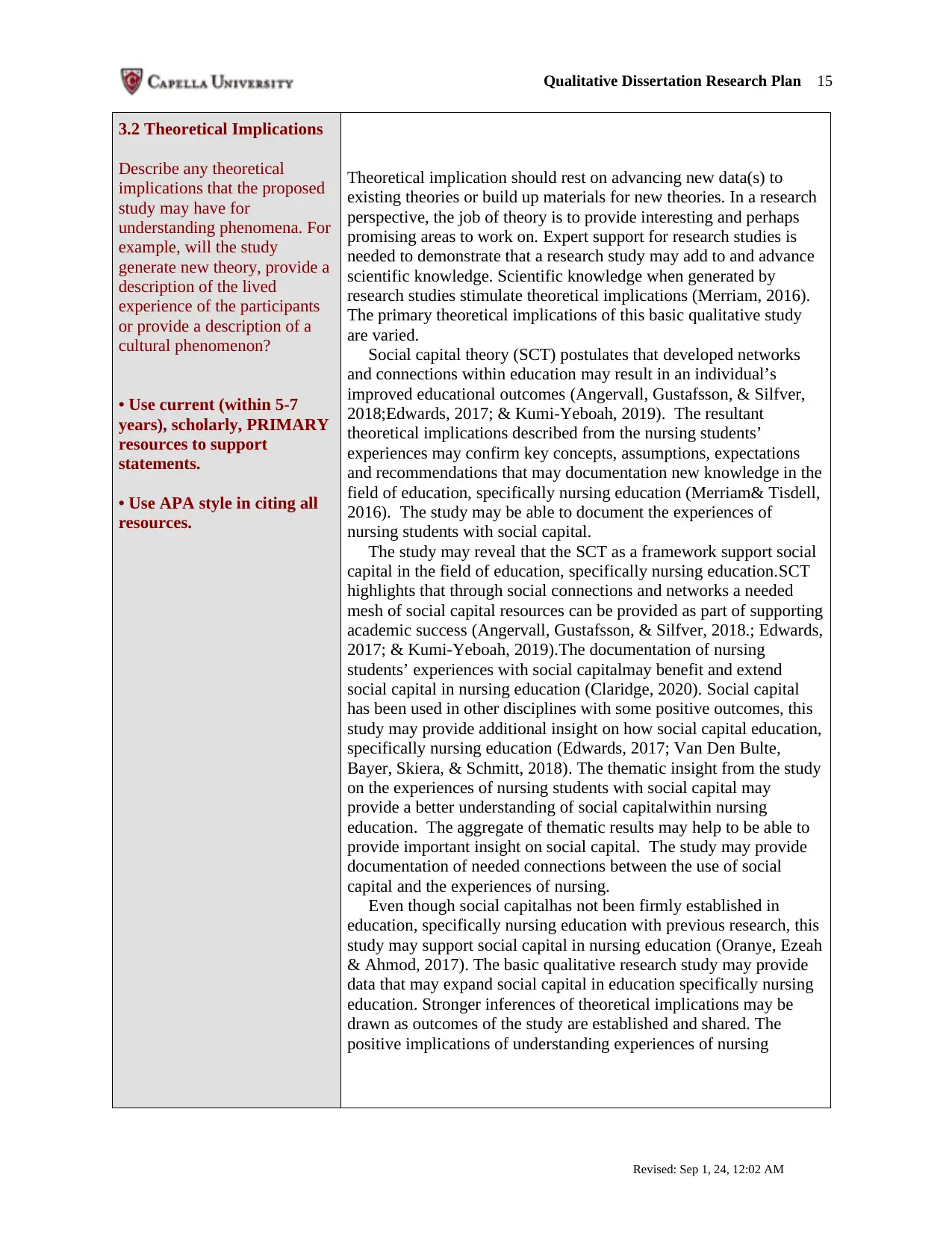
Qualitative Dissertation Research Plan 15
3.2 Theoretical Implications
Describe any theoretical
implications that the proposed
study may have for
understanding phenomena. For
example, will the study
generate new theory, provide a
description of the lived
experience of the participants
or provide a description of a
cultural phenomenon?
• Use current (within 5-7
years), scholarly, PRIMARY
resources to support
statements.
• Use APA style in citing all
resources.
Theoretical implication should rest on advancing new data(s) to
existing theories or build up materials for new theories. In a research
perspective, the job of theory is to provide interesting and perhaps
promising areas to work on. Expert support for research studies is
needed to demonstrate that a research study may add to and advance
scientific knowledge. Scientific knowledge when generated by
research studies stimulate theoretical implications (Merriam, 2016).
The primary theoretical implications of this basic qualitative study
are varied.
Social capital theory (SCT) postulates that developed networks
and connections within education may result in an individual’s
improved educational outcomes (Angervall, Gustafsson, & Silfver,
2018;Edwards, 2017; & Kumi-Yeboah, 2019). The resultant
theoretical implications described from the nursing students’
experiences may confirm key concepts, assumptions, expectations
and recommendations that may documentation new knowledge in the
field of education, specifically nursing education (Merriam& Tisdell,
2016). The study may be able to document the experiences of
nursing students with social capital.
The study may reveal that the SCT as a framework support social
capital in the field of education, specifically nursing education.SCT
highlights that through social connections and networks a needed
mesh of social capital resources can be provided as part of supporting
academic success (Angervall, Gustafsson, & Silfver, 2018.; Edwards,
2017; & Kumi-Yeboah, 2019).The documentation of nursing
students’ experiences with social capitalmay benefit and extend
social capital in nursing education (Claridge, 2020). Social capital
has been used in other disciplines with some positive outcomes, this
study may provide additional insight on how social capital education,
specifically nursing education (Edwards, 2017; Van Den Bulte,
Bayer, Skiera, & Schmitt, 2018). The thematic insight from the study
on the experiences of nursing students with social capital may
provide a better understanding of social capitalwithin nursing
education. The aggregate of thematic results may help to be able to
provide important insight on social capital. The study may provide
documentation of needed connections between the use of social
capital and the experiences of nursing.
Even though social capitalhas not been firmly established in
education, specifically nursing education with previous research, this
study may support social capital in nursing education (Oranye, Ezeah
& Ahmod, 2017). The basic qualitative research study may provide
data that may expand social capital in education specifically nursing
education. Stronger inferences of theoretical implications may be
drawn as outcomes of the study are established and shared. The
positive implications of understanding experiences of nursing
Revised: Sep 1, 24, 12:02 AM
3.2 Theoretical Implications
Describe any theoretical
implications that the proposed
study may have for
understanding phenomena. For
example, will the study
generate new theory, provide a
description of the lived
experience of the participants
or provide a description of a
cultural phenomenon?
• Use current (within 5-7
years), scholarly, PRIMARY
resources to support
statements.
• Use APA style in citing all
resources.
Theoretical implication should rest on advancing new data(s) to
existing theories or build up materials for new theories. In a research
perspective, the job of theory is to provide interesting and perhaps
promising areas to work on. Expert support for research studies is
needed to demonstrate that a research study may add to and advance
scientific knowledge. Scientific knowledge when generated by
research studies stimulate theoretical implications (Merriam, 2016).
The primary theoretical implications of this basic qualitative study
are varied.
Social capital theory (SCT) postulates that developed networks
and connections within education may result in an individual’s
improved educational outcomes (Angervall, Gustafsson, & Silfver,
2018;Edwards, 2017; & Kumi-Yeboah, 2019). The resultant
theoretical implications described from the nursing students’
experiences may confirm key concepts, assumptions, expectations
and recommendations that may documentation new knowledge in the
field of education, specifically nursing education (Merriam& Tisdell,
2016). The study may be able to document the experiences of
nursing students with social capital.
The study may reveal that the SCT as a framework support social
capital in the field of education, specifically nursing education.SCT
highlights that through social connections and networks a needed
mesh of social capital resources can be provided as part of supporting
academic success (Angervall, Gustafsson, & Silfver, 2018.; Edwards,
2017; & Kumi-Yeboah, 2019).The documentation of nursing
students’ experiences with social capitalmay benefit and extend
social capital in nursing education (Claridge, 2020). Social capital
has been used in other disciplines with some positive outcomes, this
study may provide additional insight on how social capital education,
specifically nursing education (Edwards, 2017; Van Den Bulte,
Bayer, Skiera, & Schmitt, 2018). The thematic insight from the study
on the experiences of nursing students with social capital may
provide a better understanding of social capitalwithin nursing
education. The aggregate of thematic results may help to be able to
provide important insight on social capital. The study may provide
documentation of needed connections between the use of social
capital and the experiences of nursing.
Even though social capitalhas not been firmly established in
education, specifically nursing education with previous research, this
study may support social capital in nursing education (Oranye, Ezeah
& Ahmod, 2017). The basic qualitative research study may provide
data that may expand social capital in education specifically nursing
education. Stronger inferences of theoretical implications may be
drawn as outcomes of the study are established and shared. The
positive implications of understanding experiences of nursing
Revised: Sep 1, 24, 12:02 AM
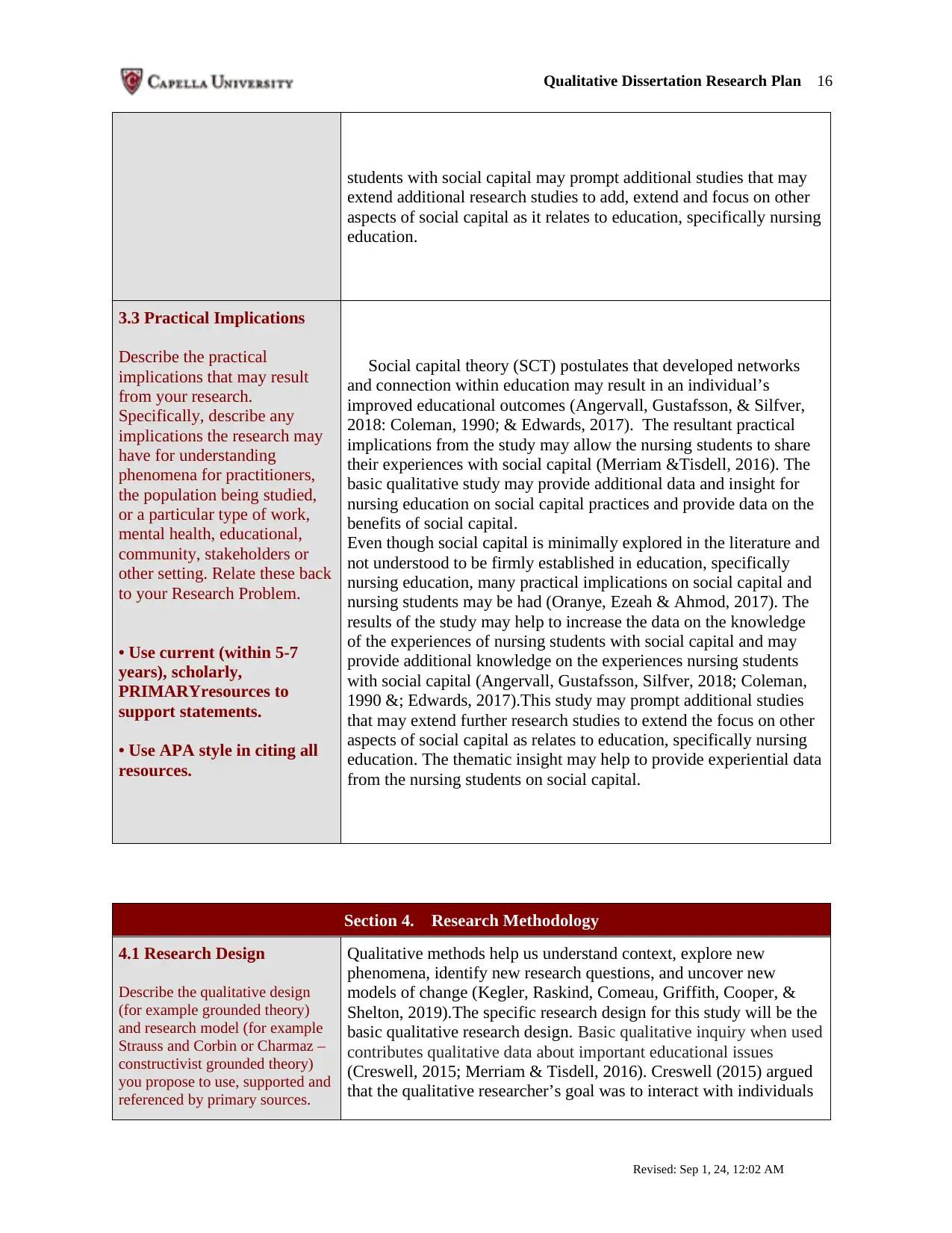
Qualitative Dissertation Research Plan 16
students with social capital may prompt additional studies that may
extend additional research studies to add, extend and focus on other
aspects of social capital as it relates to education, specifically nursing
education.
3.3 Practical Implications
Describe the practical
implications that may result
from your research.
Specifically, describe any
implications the research may
have for understanding
phenomena for practitioners,
the population being studied,
or a particular type of work,
mental health, educational,
community, stakeholders or
other setting. Relate these back
to your Research Problem.
• Use current (within 5-7
years), scholarly,
PRIMARYresources to
support statements.
• Use APA style in citing all
resources.
Social capital theory (SCT) postulates that developed networks
and connection within education may result in an individual’s
improved educational outcomes (Angervall, Gustafsson, & Silfver,
2018: Coleman, 1990; & Edwards, 2017). The resultant practical
implications from the study may allow the nursing students to share
their experiences with social capital (Merriam &Tisdell, 2016). The
basic qualitative study may provide additional data and insight for
nursing education on social capital practices and provide data on the
benefits of social capital.
Even though social capital is minimally explored in the literature and
not understood to be firmly established in education, specifically
nursing education, many practical implications on social capital and
nursing students may be had (Oranye, Ezeah & Ahmod, 2017). The
results of the study may help to increase the data on the knowledge
of the experiences of nursing students with social capital and may
provide additional knowledge on the experiences nursing students
with social capital (Angervall, Gustafsson, Silfver, 2018; Coleman,
1990 &; Edwards, 2017).This study may prompt additional studies
that may extend further research studies to extend the focus on other
aspects of social capital as relates to education, specifically nursing
education. The thematic insight may help to provide experiential data
from the nursing students on social capital.
Section 4. Research Methodology
4.1 Research Design
Describe the qualitative design
(for example grounded theory)
and research model (for example
Strauss and Corbin or Charmaz –
constructivist grounded theory)
you propose to use, supported and
referenced by primary sources.
Qualitative methods help us understand context, explore new
phenomena, identify new research questions, and uncover new
models of change (Kegler, Raskind, Comeau, Griffith, Cooper, &
Shelton, 2019).The specific research design for this study will be the
basic qualitative research design. Basic qualitative inquiry when used
contributes qualitative data about important educational issues
(Creswell, 2015; Merriam & Tisdell, 2016). Creswell (2015) argued
that the qualitative researcher’s goal was to interact with individuals
Revised: Sep 1, 24, 12:02 AM
students with social capital may prompt additional studies that may
extend additional research studies to add, extend and focus on other
aspects of social capital as it relates to education, specifically nursing
education.
3.3 Practical Implications
Describe the practical
implications that may result
from your research.
Specifically, describe any
implications the research may
have for understanding
phenomena for practitioners,
the population being studied,
or a particular type of work,
mental health, educational,
community, stakeholders or
other setting. Relate these back
to your Research Problem.
• Use current (within 5-7
years), scholarly,
PRIMARYresources to
support statements.
• Use APA style in citing all
resources.
Social capital theory (SCT) postulates that developed networks
and connection within education may result in an individual’s
improved educational outcomes (Angervall, Gustafsson, & Silfver,
2018: Coleman, 1990; & Edwards, 2017). The resultant practical
implications from the study may allow the nursing students to share
their experiences with social capital (Merriam &Tisdell, 2016). The
basic qualitative study may provide additional data and insight for
nursing education on social capital practices and provide data on the
benefits of social capital.
Even though social capital is minimally explored in the literature and
not understood to be firmly established in education, specifically
nursing education, many practical implications on social capital and
nursing students may be had (Oranye, Ezeah & Ahmod, 2017). The
results of the study may help to increase the data on the knowledge
of the experiences of nursing students with social capital and may
provide additional knowledge on the experiences nursing students
with social capital (Angervall, Gustafsson, Silfver, 2018; Coleman,
1990 &; Edwards, 2017).This study may prompt additional studies
that may extend further research studies to extend the focus on other
aspects of social capital as relates to education, specifically nursing
education. The thematic insight may help to provide experiential data
from the nursing students on social capital.
Section 4. Research Methodology
4.1 Research Design
Describe the qualitative design
(for example grounded theory)
and research model (for example
Strauss and Corbin or Charmaz –
constructivist grounded theory)
you propose to use, supported and
referenced by primary sources.
Qualitative methods help us understand context, explore new
phenomena, identify new research questions, and uncover new
models of change (Kegler, Raskind, Comeau, Griffith, Cooper, &
Shelton, 2019).The specific research design for this study will be the
basic qualitative research design. Basic qualitative inquiry when used
contributes qualitative data about important educational issues
(Creswell, 2015; Merriam & Tisdell, 2016). Creswell (2015) argued
that the qualitative researcher’s goal was to interact with individuals
Revised: Sep 1, 24, 12:02 AM
Secure Best Marks with AI Grader
Need help grading? Try our AI Grader for instant feedback on your assignments.
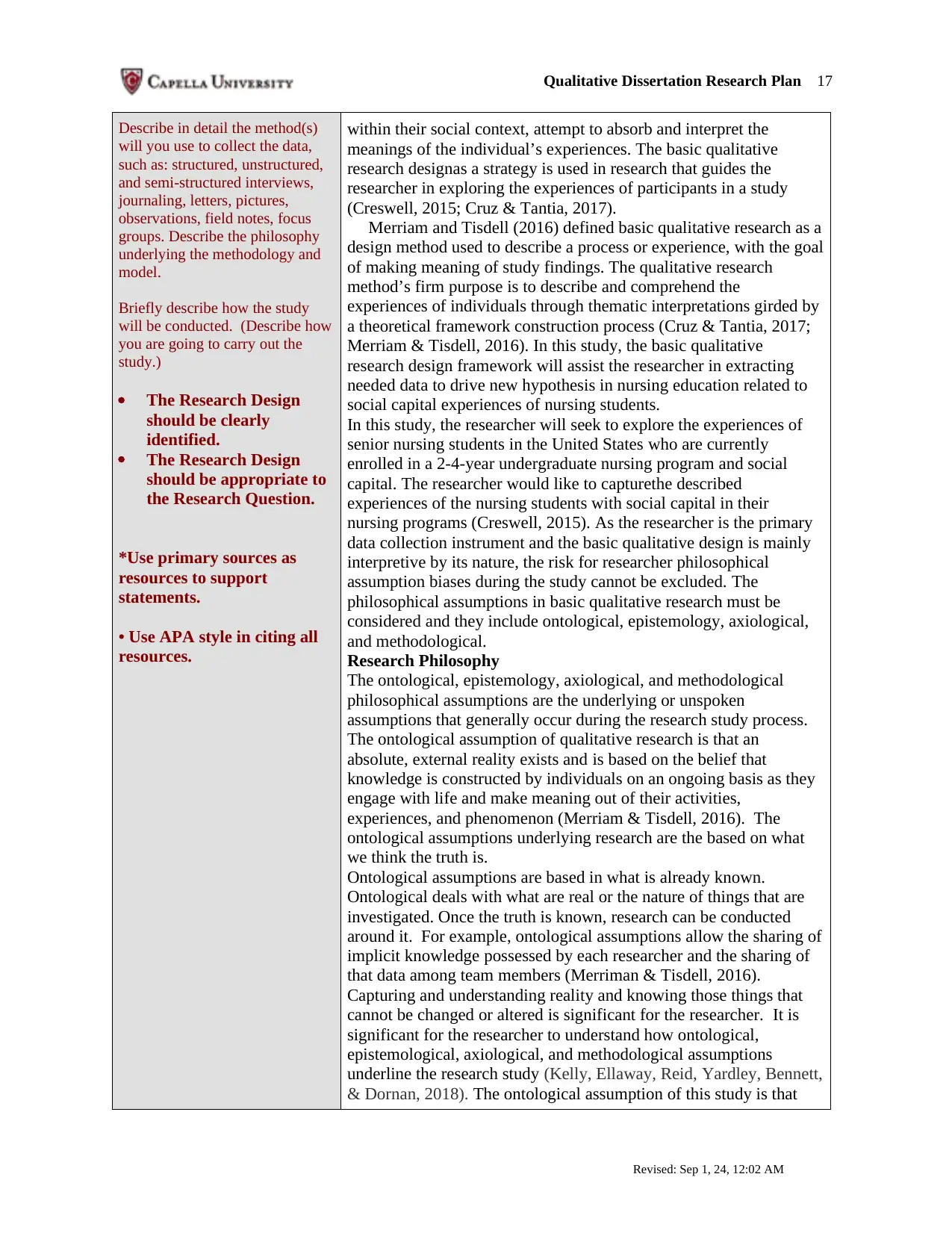
Qualitative Dissertation Research Plan 17
Describe in detail the method(s)
will you use to collect the data,
such as: structured, unstructured,
and semi-structured interviews,
journaling, letters, pictures,
observations, field notes, focus
groups. Describe the philosophy
underlying the methodology and
model.
Briefly describe how the study
will be conducted. (Describe how
you are going to carry out the
study.)
The Research Design
should be clearly
identified.
The Research Design
should be appropriate to
the Research Question.
*Use primary sources as
resources to support
statements.
• Use APA style in citing all
resources.
within their social context, attempt to absorb and interpret the
meanings of the individual’s experiences. The basic qualitative
research designas a strategy is used in research that guides the
researcher in exploring the experiences of participants in a study
(Creswell, 2015; Cruz & Tantia, 2017).
Merriam and Tisdell (2016) defined basic qualitative research as a
design method used to describe a process or experience, with the goal
of making meaning of study findings. The qualitative research
method’s firm purpose is to describe and comprehend the
experiences of individuals through thematic interpretations girded by
a theoretical framework construction process (Cruz & Tantia, 2017;
Merriam & Tisdell, 2016). In this study, the basic qualitative
research design framework will assist the researcher in extracting
needed data to drive new hypothesis in nursing education related to
social capital experiences of nursing students.
In this study, the researcher will seek to explore the experiences of
senior nursing students in the United States who are currently
enrolled in a 2-4-year undergraduate nursing program and social
capital. The researcher would like to capturethe described
experiences of the nursing students with social capital in their
nursing programs (Creswell, 2015). As the researcher is the primary
data collection instrument and the basic qualitative design is mainly
interpretive by its nature, the risk for researcher philosophical
assumption biases during the study cannot be excluded. The
philosophical assumptions in basic qualitative research must be
considered and they include ontological, epistemology, axiological,
and methodological.
Research Philosophy
The ontological, epistemology, axiological, and methodological
philosophical assumptions are the underlying or unspoken
assumptions that generally occur during the research study process.
The ontological assumption of qualitative research is that an
absolute, external reality exists and is based on the belief that
knowledge is constructed by individuals on an ongoing basis as they
engage with life and make meaning out of their activities,
experiences, and phenomenon (Merriam & Tisdell, 2016). The
ontological assumptions underlying research are the based on what
we think the truth is.
Ontological assumptions are based in what is already known.
Ontological deals with what are real or the nature of things that are
investigated. Once the truth is known, research can be conducted
around it. For example, ontological assumptions allow the sharing of
implicit knowledge possessed by each researcher and the sharing of
that data among team members (Merriman & Tisdell, 2016).
Capturing and understanding reality and knowing those things that
cannot be changed or altered is significant for the researcher. It is
significant for the researcher to understand how ontological,
epistemological, axiological, and methodological assumptions
underline the research study (Kelly, Ellaway, Reid, Yardley, Bennett,
& Dornan, 2018). The ontological assumption of this study is that
Revised: Sep 1, 24, 12:02 AM
Describe in detail the method(s)
will you use to collect the data,
such as: structured, unstructured,
and semi-structured interviews,
journaling, letters, pictures,
observations, field notes, focus
groups. Describe the philosophy
underlying the methodology and
model.
Briefly describe how the study
will be conducted. (Describe how
you are going to carry out the
study.)
The Research Design
should be clearly
identified.
The Research Design
should be appropriate to
the Research Question.
*Use primary sources as
resources to support
statements.
• Use APA style in citing all
resources.
within their social context, attempt to absorb and interpret the
meanings of the individual’s experiences. The basic qualitative
research designas a strategy is used in research that guides the
researcher in exploring the experiences of participants in a study
(Creswell, 2015; Cruz & Tantia, 2017).
Merriam and Tisdell (2016) defined basic qualitative research as a
design method used to describe a process or experience, with the goal
of making meaning of study findings. The qualitative research
method’s firm purpose is to describe and comprehend the
experiences of individuals through thematic interpretations girded by
a theoretical framework construction process (Cruz & Tantia, 2017;
Merriam & Tisdell, 2016). In this study, the basic qualitative
research design framework will assist the researcher in extracting
needed data to drive new hypothesis in nursing education related to
social capital experiences of nursing students.
In this study, the researcher will seek to explore the experiences of
senior nursing students in the United States who are currently
enrolled in a 2-4-year undergraduate nursing program and social
capital. The researcher would like to capturethe described
experiences of the nursing students with social capital in their
nursing programs (Creswell, 2015). As the researcher is the primary
data collection instrument and the basic qualitative design is mainly
interpretive by its nature, the risk for researcher philosophical
assumption biases during the study cannot be excluded. The
philosophical assumptions in basic qualitative research must be
considered and they include ontological, epistemology, axiological,
and methodological.
Research Philosophy
The ontological, epistemology, axiological, and methodological
philosophical assumptions are the underlying or unspoken
assumptions that generally occur during the research study process.
The ontological assumption of qualitative research is that an
absolute, external reality exists and is based on the belief that
knowledge is constructed by individuals on an ongoing basis as they
engage with life and make meaning out of their activities,
experiences, and phenomenon (Merriam & Tisdell, 2016). The
ontological assumptions underlying research are the based on what
we think the truth is.
Ontological assumptions are based in what is already known.
Ontological deals with what are real or the nature of things that are
investigated. Once the truth is known, research can be conducted
around it. For example, ontological assumptions allow the sharing of
implicit knowledge possessed by each researcher and the sharing of
that data among team members (Merriman & Tisdell, 2016).
Capturing and understanding reality and knowing those things that
cannot be changed or altered is significant for the researcher. It is
significant for the researcher to understand how ontological,
epistemological, axiological, and methodological assumptions
underline the research study (Kelly, Ellaway, Reid, Yardley, Bennett,
& Dornan, 2018). The ontological assumption of this study is that
Revised: Sep 1, 24, 12:02 AM
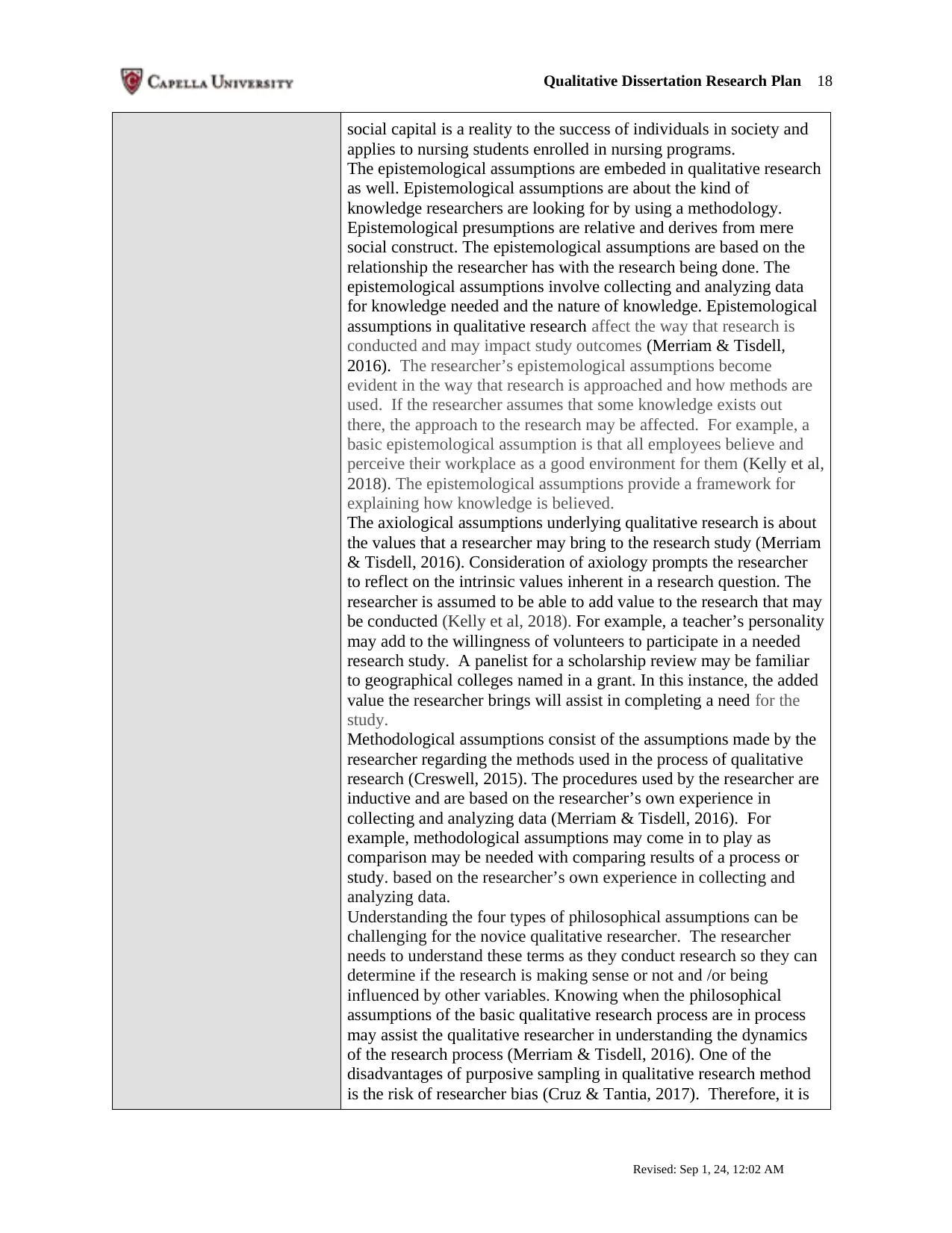
Qualitative Dissertation Research Plan 18
social capital is a reality to the success of individuals in society and
applies to nursing students enrolled in nursing programs.
The epistemological assumptions are embeded in qualitative research
as well. Epistemological assumptions are about the kind of
knowledge researchers are looking for by using a methodology.
Epistemological presumptions are relative and derives from mere
social construct. The epistemological assumptions are based on the
relationship the researcher has with the research being done. The
epistemological assumptions involve collecting and analyzing data
for knowledge needed and the nature of knowledge. Epistemological
assumptions in qualitative research affect the way that research is
conducted and may impact study outcomes (Merriam & Tisdell,
2016). The researcher’s epistemological assumptions become
evident in the way that research is approached and how methods are
used. If the researcher assumes that some knowledge exists out
there, the approach to the research may be affected. For example, a
basic epistemological assumption is that all employees believe and
perceive their workplace as a good environment for them (Kelly et al,
2018). The epistemological assumptions provide a framework for
explaining how knowledge is believed.
The axiological assumptions underlying qualitative research is about
the values that a researcher may bring to the research study (Merriam
& Tisdell, 2016). Consideration of axiology prompts the researcher
to reflect on the intrinsic values inherent in a research question. The
researcher is assumed to be able to add value to the research that may
be conducted (Kelly et al, 2018). For example, a teacher’s personality
may add to the willingness of volunteers to participate in a needed
research study. A panelist for a scholarship review may be familiar
to geographical colleges named in a grant. In this instance, the added
value the researcher brings will assist in completing a need for the
study.
Methodological assumptions consist of the assumptions made by the
researcher regarding the methods used in the process of qualitative
research (Creswell, 2015). The procedures used by the researcher are
inductive and are based on the researcher’s own experience in
collecting and analyzing data (Merriam & Tisdell, 2016). For
example, methodological assumptions may come in to play as
comparison may be needed with comparing results of a process or
study. based on the researcher’s own experience in collecting and
analyzing data.
Understanding the four types of philosophical assumptions can be
challenging for the novice qualitative researcher. The researcher
needs to understand these terms as they conduct research so they can
determine if the research is making sense or not and /or being
influenced by other variables. Knowing when the philosophical
assumptions of the basic qualitative research process are in process
may assist the qualitative researcher in understanding the dynamics
of the research process (Merriam & Tisdell, 2016). One of the
disadvantages of purposive sampling in qualitative research method
is the risk of researcher bias (Cruz & Tantia, 2017). Therefore, it is
Revised: Sep 1, 24, 12:02 AM
social capital is a reality to the success of individuals in society and
applies to nursing students enrolled in nursing programs.
The epistemological assumptions are embeded in qualitative research
as well. Epistemological assumptions are about the kind of
knowledge researchers are looking for by using a methodology.
Epistemological presumptions are relative and derives from mere
social construct. The epistemological assumptions are based on the
relationship the researcher has with the research being done. The
epistemological assumptions involve collecting and analyzing data
for knowledge needed and the nature of knowledge. Epistemological
assumptions in qualitative research affect the way that research is
conducted and may impact study outcomes (Merriam & Tisdell,
2016). The researcher’s epistemological assumptions become
evident in the way that research is approached and how methods are
used. If the researcher assumes that some knowledge exists out
there, the approach to the research may be affected. For example, a
basic epistemological assumption is that all employees believe and
perceive their workplace as a good environment for them (Kelly et al,
2018). The epistemological assumptions provide a framework for
explaining how knowledge is believed.
The axiological assumptions underlying qualitative research is about
the values that a researcher may bring to the research study (Merriam
& Tisdell, 2016). Consideration of axiology prompts the researcher
to reflect on the intrinsic values inherent in a research question. The
researcher is assumed to be able to add value to the research that may
be conducted (Kelly et al, 2018). For example, a teacher’s personality
may add to the willingness of volunteers to participate in a needed
research study. A panelist for a scholarship review may be familiar
to geographical colleges named in a grant. In this instance, the added
value the researcher brings will assist in completing a need for the
study.
Methodological assumptions consist of the assumptions made by the
researcher regarding the methods used in the process of qualitative
research (Creswell, 2015). The procedures used by the researcher are
inductive and are based on the researcher’s own experience in
collecting and analyzing data (Merriam & Tisdell, 2016). For
example, methodological assumptions may come in to play as
comparison may be needed with comparing results of a process or
study. based on the researcher’s own experience in collecting and
analyzing data.
Understanding the four types of philosophical assumptions can be
challenging for the novice qualitative researcher. The researcher
needs to understand these terms as they conduct research so they can
determine if the research is making sense or not and /or being
influenced by other variables. Knowing when the philosophical
assumptions of the basic qualitative research process are in process
may assist the qualitative researcher in understanding the dynamics
of the research process (Merriam & Tisdell, 2016). One of the
disadvantages of purposive sampling in qualitative research method
is the risk of researcher bias (Cruz & Tantia, 2017). Therefore, it is
Revised: Sep 1, 24, 12:02 AM
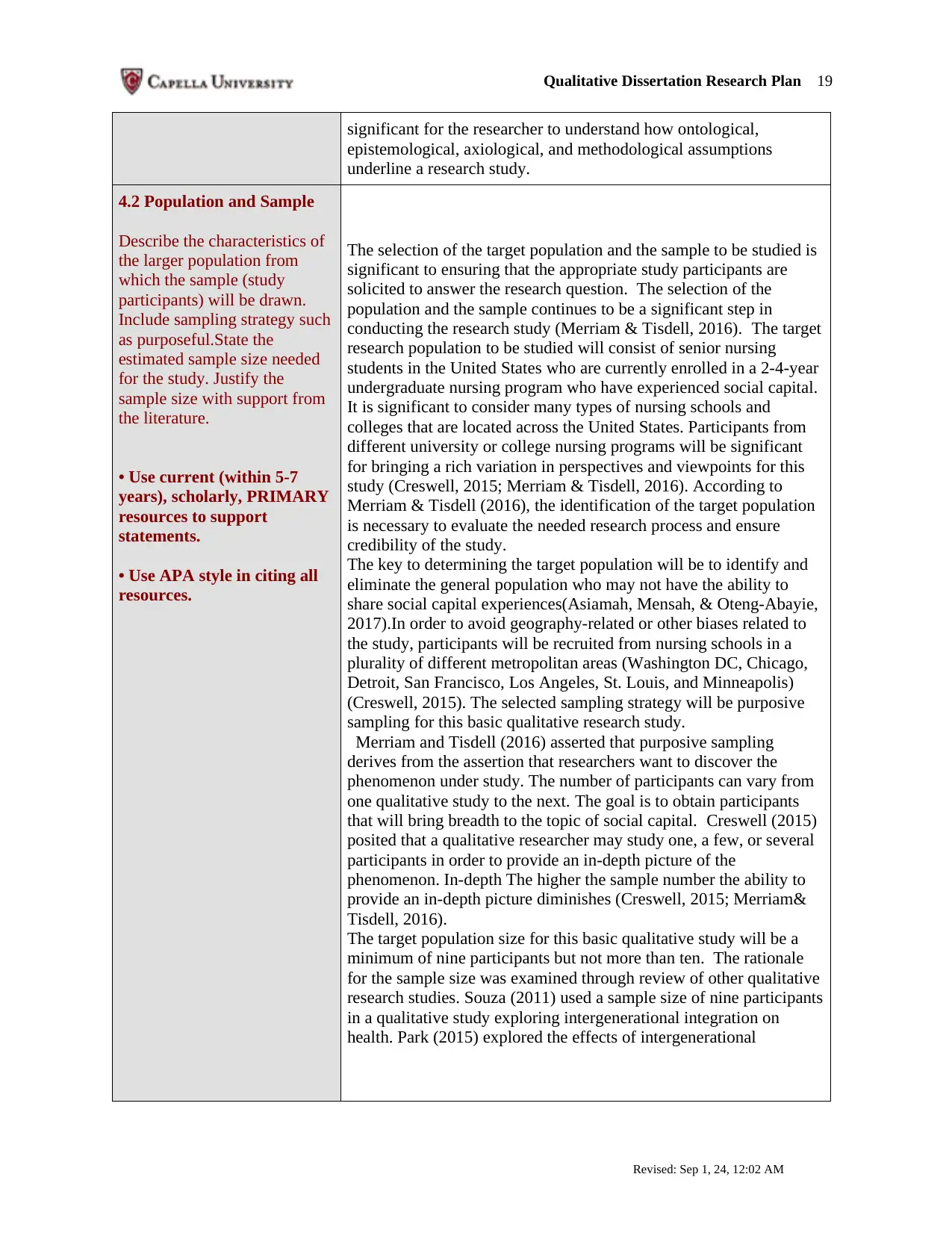
Qualitative Dissertation Research Plan 19
significant for the researcher to understand how ontological,
epistemological, axiological, and methodological assumptions
underline a research study.
4.2 Population and Sample
Describe the characteristics of
the larger population from
which the sample (study
participants) will be drawn.
Include sampling strategy such
as purposeful.State the
estimated sample size needed
for the study. Justify the
sample size with support from
the literature.
• Use current (within 5-7
years), scholarly, PRIMARY
resources to support
statements.
• Use APA style in citing all
resources.
The selection of the target population and the sample to be studied is
significant to ensuring that the appropriate study participants are
solicited to answer the research question. The selection of the
population and the sample continues to be a significant step in
conducting the research study (Merriam & Tisdell, 2016). The target
research population to be studied will consist of senior nursing
students in the United States who are currently enrolled in a 2-4-year
undergraduate nursing program who have experienced social capital.
It is significant to consider many types of nursing schools and
colleges that are located across the United States. Participants from
different university or college nursing programs will be significant
for bringing a rich variation in perspectives and viewpoints for this
study (Creswell, 2015; Merriam & Tisdell, 2016). According to
Merriam & Tisdell (2016), the identification of the target population
is necessary to evaluate the needed research process and ensure
credibility of the study.
The key to determining the target population will be to identify and
eliminate the general population who may not have the ability to
share social capital experiences(Asiamah, Mensah, & Oteng-Abayie,
2017).In order to avoid geography-related or other biases related to
the study, participants will be recruited from nursing schools in a
plurality of different metropolitan areas (Washington DC, Chicago,
Detroit, San Francisco, Los Angeles, St. Louis, and Minneapolis)
(Creswell, 2015). The selected sampling strategy will be purposive
sampling for this basic qualitative research study.
Merriam and Tisdell (2016) asserted that purposive sampling
derives from the assertion that researchers want to discover the
phenomenon under study. The number of participants can vary from
one qualitative study to the next. The goal is to obtain participants
that will bring breadth to the topic of social capital. Creswell (2015)
posited that a qualitative researcher may study one, a few, or several
participants in order to provide an in-depth picture of the
phenomenon. In-depth The higher the sample number the ability to
provide an in-depth picture diminishes (Creswell, 2015; Merriam&
Tisdell, 2016).
The target population size for this basic qualitative study will be a
minimum of nine participants but not more than ten. The rationale
for the sample size was examined through review of other qualitative
research studies. Souza (2011) used a sample size of nine participants
in a qualitative study exploring intergenerational integration on
health. Park (2015) explored the effects of intergenerational
Revised: Sep 1, 24, 12:02 AM
significant for the researcher to understand how ontological,
epistemological, axiological, and methodological assumptions
underline a research study.
4.2 Population and Sample
Describe the characteristics of
the larger population from
which the sample (study
participants) will be drawn.
Include sampling strategy such
as purposeful.State the
estimated sample size needed
for the study. Justify the
sample size with support from
the literature.
• Use current (within 5-7
years), scholarly, PRIMARY
resources to support
statements.
• Use APA style in citing all
resources.
The selection of the target population and the sample to be studied is
significant to ensuring that the appropriate study participants are
solicited to answer the research question. The selection of the
population and the sample continues to be a significant step in
conducting the research study (Merriam & Tisdell, 2016). The target
research population to be studied will consist of senior nursing
students in the United States who are currently enrolled in a 2-4-year
undergraduate nursing program who have experienced social capital.
It is significant to consider many types of nursing schools and
colleges that are located across the United States. Participants from
different university or college nursing programs will be significant
for bringing a rich variation in perspectives and viewpoints for this
study (Creswell, 2015; Merriam & Tisdell, 2016). According to
Merriam & Tisdell (2016), the identification of the target population
is necessary to evaluate the needed research process and ensure
credibility of the study.
The key to determining the target population will be to identify and
eliminate the general population who may not have the ability to
share social capital experiences(Asiamah, Mensah, & Oteng-Abayie,
2017).In order to avoid geography-related or other biases related to
the study, participants will be recruited from nursing schools in a
plurality of different metropolitan areas (Washington DC, Chicago,
Detroit, San Francisco, Los Angeles, St. Louis, and Minneapolis)
(Creswell, 2015). The selected sampling strategy will be purposive
sampling for this basic qualitative research study.
Merriam and Tisdell (2016) asserted that purposive sampling
derives from the assertion that researchers want to discover the
phenomenon under study. The number of participants can vary from
one qualitative study to the next. The goal is to obtain participants
that will bring breadth to the topic of social capital. Creswell (2015)
posited that a qualitative researcher may study one, a few, or several
participants in order to provide an in-depth picture of the
phenomenon. In-depth The higher the sample number the ability to
provide an in-depth picture diminishes (Creswell, 2015; Merriam&
Tisdell, 2016).
The target population size for this basic qualitative study will be a
minimum of nine participants but not more than ten. The rationale
for the sample size was examined through review of other qualitative
research studies. Souza (2011) used a sample size of nine participants
in a qualitative study exploring intergenerational integration on
health. Park (2015) explored the effects of intergenerational
Revised: Sep 1, 24, 12:02 AM
Paraphrase This Document
Need a fresh take? Get an instant paraphrase of this document with our AI Paraphraser
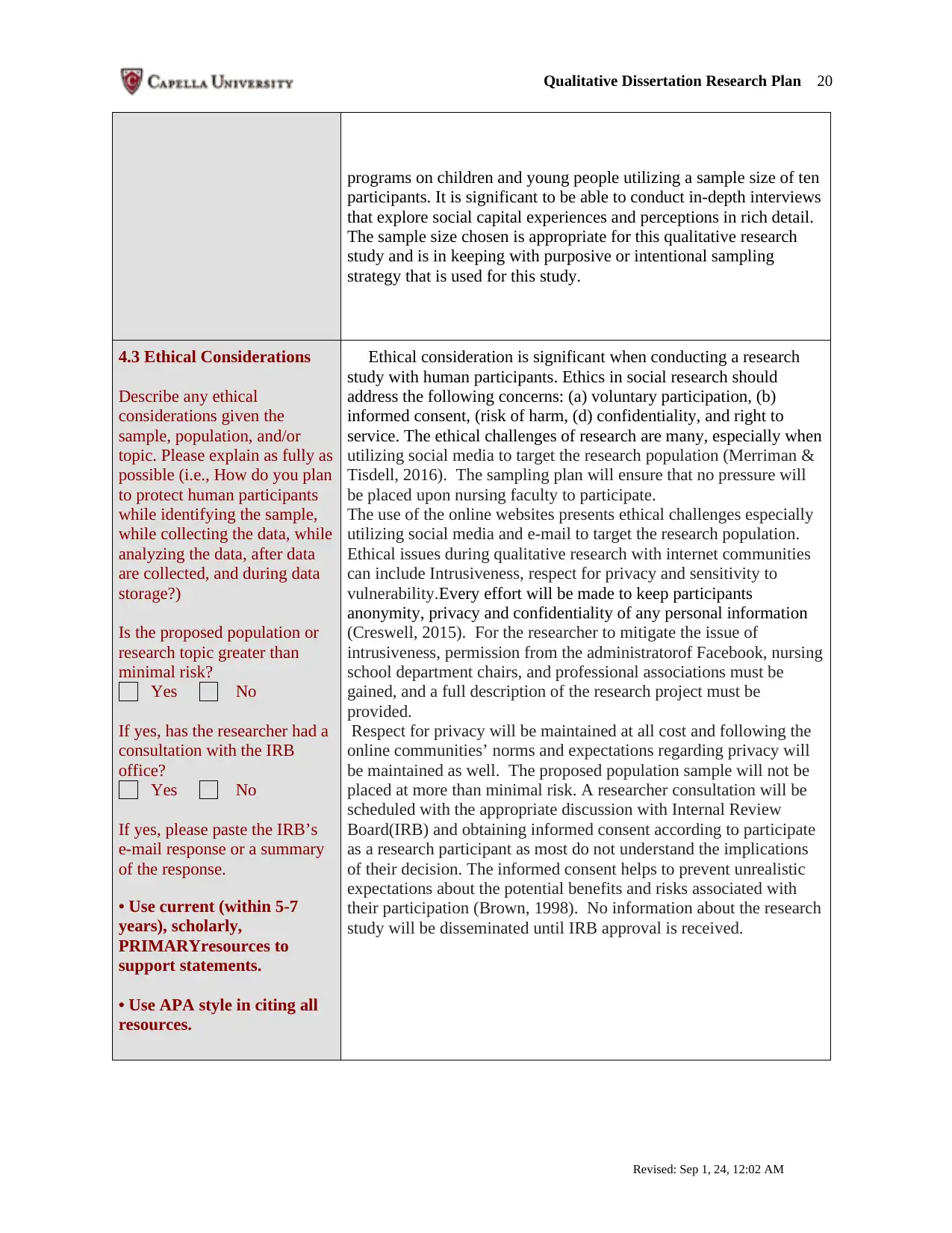
Qualitative Dissertation Research Plan 20
programs on children and young people utilizing a sample size of ten
participants. It is significant to be able to conduct in-depth interviews
that explore social capital experiences and perceptions in rich detail.
The sample size chosen is appropriate for this qualitative research
study and is in keeping with purposive or intentional sampling
strategy that is used for this study.
4.3 Ethical Considerations
Describe any ethical
considerations given the
sample, population, and/or
topic. Please explain as fully as
possible (i.e., How do you plan
to protect human participants
while identifying the sample,
while collecting the data, while
analyzing the data, after data
are collected, and during data
storage?)
Is the proposed population or
research topic greater than
minimal risk?
Yes No
If yes, has the researcher had a
consultation with the IRB
office?
Yes No
If yes, please paste the IRB’s
e-mail response or a summary
of the response.
• Use current (within 5-7
years), scholarly,
PRIMARYresources to
support statements.
• Use APA style in citing all
resources.
Ethical consideration is significant when conducting a research
study with human participants. Ethics in social research should
address the following concerns: (a) voluntary participation, (b)
informed consent, (risk of harm, (d) confidentiality, and right to
service. The ethical challenges of research are many, especially when
utilizing social media to target the research population (Merriman &
Tisdell, 2016). The sampling plan will ensure that no pressure will
be placed upon nursing faculty to participate.
The use of the online websites presents ethical challenges especially
utilizing social media and e-mail to target the research population.
Ethical issues during qualitative research with internet communities
can include Intrusiveness, respect for privacy and sensitivity to
vulnerability.Every effort will be made to keep participants
anonymity, privacy and confidentiality of any personal information
(Creswell, 2015). For the researcher to mitigate the issue of
intrusiveness, permission from the administratorof Facebook, nursing
school department chairs, and professional associations must be
gained, and a full description of the research project must be
provided.
Respect for privacy will be maintained at all cost and following the
online communities’ norms and expectations regarding privacy will
be maintained as well. The proposed population sample will not be
placed at more than minimal risk. A researcher consultation will be
scheduled with the appropriate discussion with Internal Review
Board(IRB) and obtaining informed consent according to participate
as a research participant as most do not understand the implications
of their decision. The informed consent helps to prevent unrealistic
expectations about the potential benefits and risks associated with
their participation (Brown, 1998). No information about the research
study will be disseminated until IRB approval is received.
Revised: Sep 1, 24, 12:02 AM
programs on children and young people utilizing a sample size of ten
participants. It is significant to be able to conduct in-depth interviews
that explore social capital experiences and perceptions in rich detail.
The sample size chosen is appropriate for this qualitative research
study and is in keeping with purposive or intentional sampling
strategy that is used for this study.
4.3 Ethical Considerations
Describe any ethical
considerations given the
sample, population, and/or
topic. Please explain as fully as
possible (i.e., How do you plan
to protect human participants
while identifying the sample,
while collecting the data, while
analyzing the data, after data
are collected, and during data
storage?)
Is the proposed population or
research topic greater than
minimal risk?
Yes No
If yes, has the researcher had a
consultation with the IRB
office?
Yes No
If yes, please paste the IRB’s
e-mail response or a summary
of the response.
• Use current (within 5-7
years), scholarly,
PRIMARYresources to
support statements.
• Use APA style in citing all
resources.
Ethical consideration is significant when conducting a research
study with human participants. Ethics in social research should
address the following concerns: (a) voluntary participation, (b)
informed consent, (risk of harm, (d) confidentiality, and right to
service. The ethical challenges of research are many, especially when
utilizing social media to target the research population (Merriman &
Tisdell, 2016). The sampling plan will ensure that no pressure will
be placed upon nursing faculty to participate.
The use of the online websites presents ethical challenges especially
utilizing social media and e-mail to target the research population.
Ethical issues during qualitative research with internet communities
can include Intrusiveness, respect for privacy and sensitivity to
vulnerability.Every effort will be made to keep participants
anonymity, privacy and confidentiality of any personal information
(Creswell, 2015). For the researcher to mitigate the issue of
intrusiveness, permission from the administratorof Facebook, nursing
school department chairs, and professional associations must be
gained, and a full description of the research project must be
provided.
Respect for privacy will be maintained at all cost and following the
online communities’ norms and expectations regarding privacy will
be maintained as well. The proposed population sample will not be
placed at more than minimal risk. A researcher consultation will be
scheduled with the appropriate discussion with Internal Review
Board(IRB) and obtaining informed consent according to participate
as a research participant as most do not understand the implications
of their decision. The informed consent helps to prevent unrealistic
expectations about the potential benefits and risks associated with
their participation (Brown, 1998). No information about the research
study will be disseminated until IRB approval is received.
Revised: Sep 1, 24, 12:02 AM
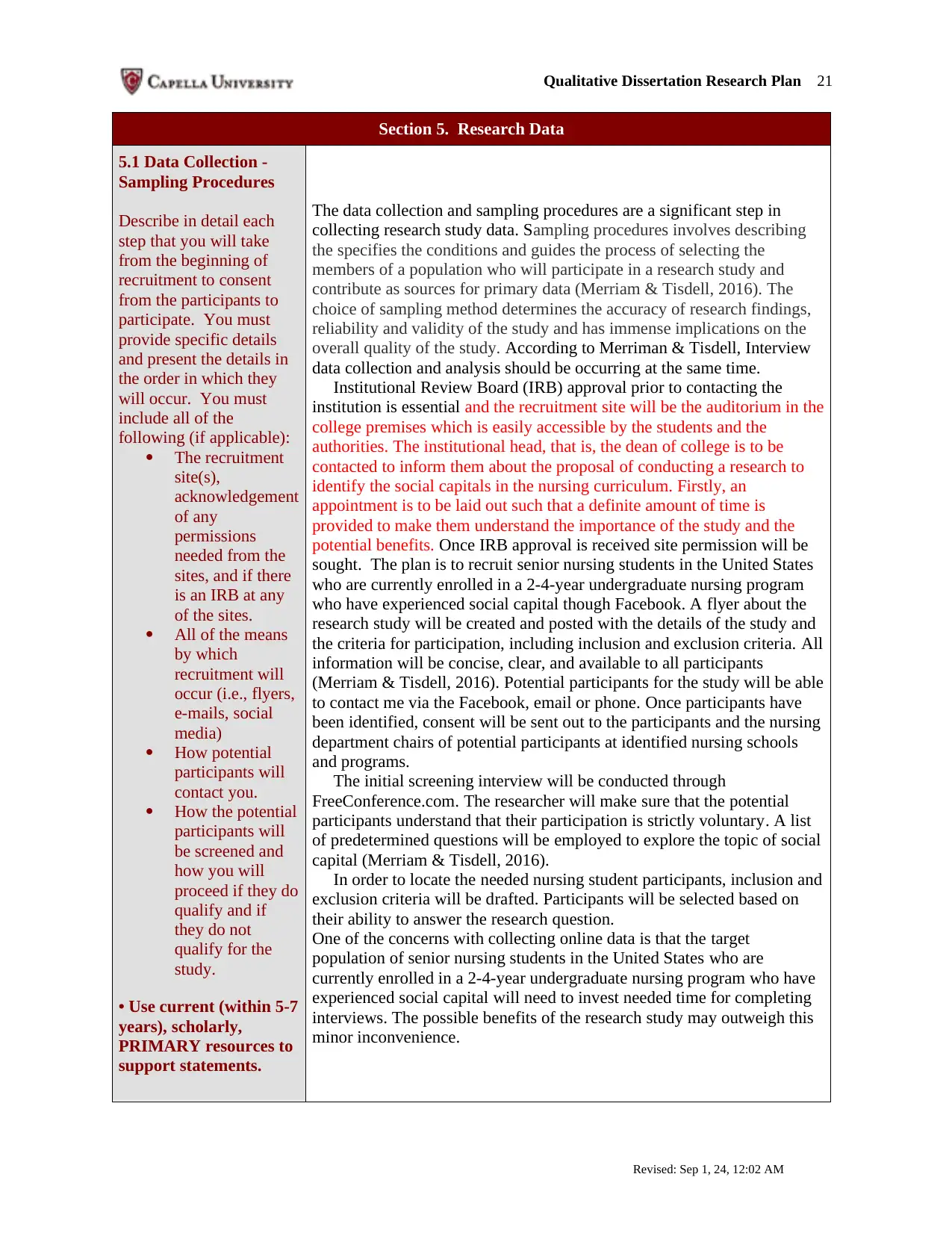
Qualitative Dissertation Research Plan 21
Section 5. Research Data
5.1 Data Collection -
Sampling Procedures
Describe in detail each
step that you will take
from the beginning of
recruitment to consent
from the participants to
participate. You must
provide specific details
and present the details in
the order in which they
will occur. You must
include all of the
following (if applicable):
The recruitment
site(s),
acknowledgement
of any
permissions
needed from the
sites, and if there
is an IRB at any
of the sites.
All of the means
by which
recruitment will
occur (i.e., flyers,
e-mails, social
media)
How potential
participants will
contact you.
How the potential
participants will
be screened and
how you will
proceed if they do
qualify and if
they do not
qualify for the
study.
• Use current (within 5-7
years), scholarly,
PRIMARY resources to
support statements.
The data collection and sampling procedures are a significant step in
collecting research study data. Sampling procedures involves describing
the specifies the conditions and guides the process of selecting the
members of a population who will participate in a research study and
contribute as sources for primary data (Merriam & Tisdell, 2016). The
choice of sampling method determines the accuracy of research findings,
reliability and validity of the study and has immense implications on the
overall quality of the study. According to Merriman & Tisdell, Interview
data collection and analysis should be occurring at the same time.
Institutional Review Board (IRB) approval prior to contacting the
institution is essential and the recruitment site will be the auditorium in the
college premises which is easily accessible by the students and the
authorities. The institutional head, that is, the dean of college is to be
contacted to inform them about the proposal of conducting a research to
identify the social capitals in the nursing curriculum. Firstly, an
appointment is to be laid out such that a definite amount of time is
provided to make them understand the importance of the study and the
potential benefits. Once IRB approval is received site permission will be
sought. The plan is to recruit senior nursing students in the United States
who are currently enrolled in a 2-4-year undergraduate nursing program
who have experienced social capital though Facebook. A flyer about the
research study will be created and posted with the details of the study and
the criteria for participation, including inclusion and exclusion criteria. All
information will be concise, clear, and available to all participants
(Merriam & Tisdell, 2016). Potential participants for the study will be able
to contact me via the Facebook, email or phone. Once participants have
been identified, consent will be sent out to the participants and the nursing
department chairs of potential participants at identified nursing schools
and programs.
The initial screening interview will be conducted through
FreeConference.com. The researcher will make sure that the potential
participants understand that their participation is strictly voluntary. A list
of predetermined questions will be employed to explore the topic of social
capital (Merriam & Tisdell, 2016).
In order to locate the needed nursing student participants, inclusion and
exclusion criteria will be drafted. Participants will be selected based on
their ability to answer the research question.
One of the concerns with collecting online data is that the target
population of senior nursing students in the United States who are
currently enrolled in a 2-4-year undergraduate nursing program who have
experienced social capital will need to invest needed time for completing
interviews. The possible benefits of the research study may outweigh this
minor inconvenience.
Revised: Sep 1, 24, 12:02 AM
Section 5. Research Data
5.1 Data Collection -
Sampling Procedures
Describe in detail each
step that you will take
from the beginning of
recruitment to consent
from the participants to
participate. You must
provide specific details
and present the details in
the order in which they
will occur. You must
include all of the
following (if applicable):
The recruitment
site(s),
acknowledgement
of any
permissions
needed from the
sites, and if there
is an IRB at any
of the sites.
All of the means
by which
recruitment will
occur (i.e., flyers,
e-mails, social
media)
How potential
participants will
contact you.
How the potential
participants will
be screened and
how you will
proceed if they do
qualify and if
they do not
qualify for the
study.
• Use current (within 5-7
years), scholarly,
PRIMARY resources to
support statements.
The data collection and sampling procedures are a significant step in
collecting research study data. Sampling procedures involves describing
the specifies the conditions and guides the process of selecting the
members of a population who will participate in a research study and
contribute as sources for primary data (Merriam & Tisdell, 2016). The
choice of sampling method determines the accuracy of research findings,
reliability and validity of the study and has immense implications on the
overall quality of the study. According to Merriman & Tisdell, Interview
data collection and analysis should be occurring at the same time.
Institutional Review Board (IRB) approval prior to contacting the
institution is essential and the recruitment site will be the auditorium in the
college premises which is easily accessible by the students and the
authorities. The institutional head, that is, the dean of college is to be
contacted to inform them about the proposal of conducting a research to
identify the social capitals in the nursing curriculum. Firstly, an
appointment is to be laid out such that a definite amount of time is
provided to make them understand the importance of the study and the
potential benefits. Once IRB approval is received site permission will be
sought. The plan is to recruit senior nursing students in the United States
who are currently enrolled in a 2-4-year undergraduate nursing program
who have experienced social capital though Facebook. A flyer about the
research study will be created and posted with the details of the study and
the criteria for participation, including inclusion and exclusion criteria. All
information will be concise, clear, and available to all participants
(Merriam & Tisdell, 2016). Potential participants for the study will be able
to contact me via the Facebook, email or phone. Once participants have
been identified, consent will be sent out to the participants and the nursing
department chairs of potential participants at identified nursing schools
and programs.
The initial screening interview will be conducted through
FreeConference.com. The researcher will make sure that the potential
participants understand that their participation is strictly voluntary. A list
of predetermined questions will be employed to explore the topic of social
capital (Merriam & Tisdell, 2016).
In order to locate the needed nursing student participants, inclusion and
exclusion criteria will be drafted. Participants will be selected based on
their ability to answer the research question.
One of the concerns with collecting online data is that the target
population of senior nursing students in the United States who are
currently enrolled in a 2-4-year undergraduate nursing program who have
experienced social capital will need to invest needed time for completing
interviews. The possible benefits of the research study may outweigh this
minor inconvenience.
Revised: Sep 1, 24, 12:02 AM
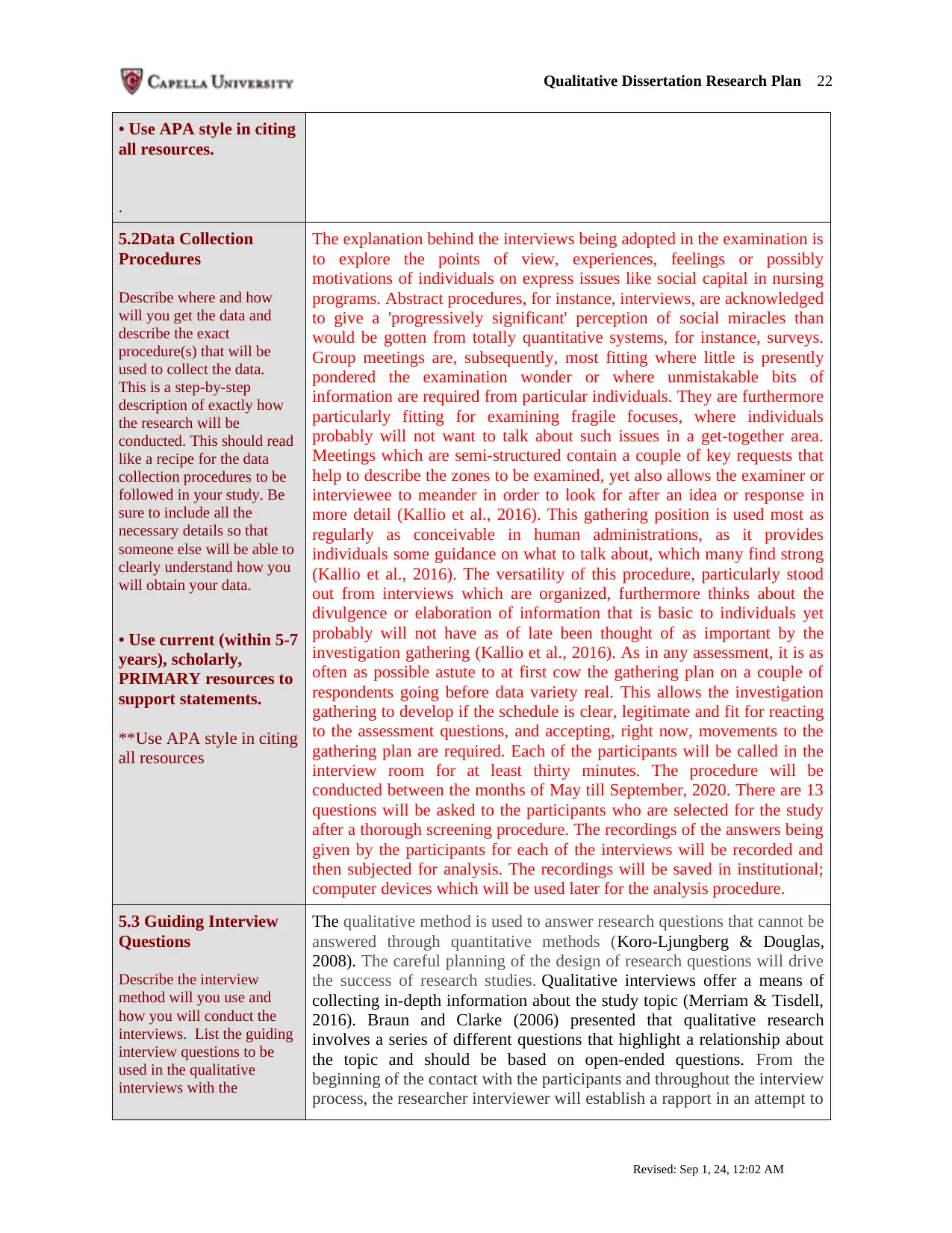
Qualitative Dissertation Research Plan 22
• Use APA style in citing
all resources.
.
5.2Data Collection
Procedures
Describe where and how
will you get the data and
describe the exact
procedure(s) that will be
used to collect the data.
This is a step-by-step
description of exactly how
the research will be
conducted. This should read
like a recipe for the data
collection procedures to be
followed in your study. Be
sure to include all the
necessary details so that
someone else will be able to
clearly understand how you
will obtain your data.
• Use current (within 5-7
years), scholarly,
PRIMARY resources to
support statements.
**Use APA style in citing
all resources
The explanation behind the interviews being adopted in the examination is
to explore the points of view, experiences, feelings or possibly
motivations of individuals on express issues like social capital in nursing
programs. Abstract procedures, for instance, interviews, are acknowledged
to give a 'progressively significant' perception of social miracles than
would be gotten from totally quantitative systems, for instance, surveys.
Group meetings are, subsequently, most fitting where little is presently
pondered the examination wonder or where unmistakable bits of
information are required from particular individuals. They are furthermore
particularly fitting for examining fragile focuses, where individuals
probably will not want to talk about such issues in a get-together area.
Meetings which are semi-structured contain a couple of key requests that
help to describe the zones to be examined, yet also allows the examiner or
interviewee to meander in order to look for after an idea or response in
more detail (Kallio et al., 2016). This gathering position is used most as
regularly as conceivable in human administrations, as it provides
individuals some guidance on what to talk about, which many find strong
(Kallio et al., 2016). The versatility of this procedure, particularly stood
out from interviews which are organized, furthermore thinks about the
divulgence or elaboration of information that is basic to individuals yet
probably will not have as of late been thought of as important by the
investigation gathering (Kallio et al., 2016). As in any assessment, it is as
often as possible astute to at first cow the gathering plan on a couple of
respondents going before data variety real. This allows the investigation
gathering to develop if the schedule is clear, legitimate and fit for reacting
to the assessment questions, and accepting, right now, movements to the
gathering plan are required. Each of the participants will be called in the
interview room for at least thirty minutes. The procedure will be
conducted between the months of May till September, 2020. There are 13
questions will be asked to the participants who are selected for the study
after a thorough screening procedure. The recordings of the answers being
given by the participants for each of the interviews will be recorded and
then subjected for analysis. The recordings will be saved in institutional;
computer devices which will be used later for the analysis procedure.
5.3 Guiding Interview
Questions
Describe the interview
method will you use and
how you will conduct the
interviews. List the guiding
interview questions to be
used in the qualitative
interviews with the
The qualitative method is used to answer research questions that cannot be
answered through quantitative methods (Koro-Ljungberg & Douglas,
2008). The careful planning of the design of research questions will drive
the success of research studies. Qualitative interviews offer a means of
collecting in-depth information about the study topic (Merriam & Tisdell,
2016). Braun and Clarke (2006) presented that qualitative research
involves a series of different questions that highlight a relationship about
the topic and should be based on open-ended questions. From the
beginning of the contact with the participants and throughout the interview
process, the researcher interviewer will establish a rapport in an attempt to
Revised: Sep 1, 24, 12:02 AM
• Use APA style in citing
all resources.
.
5.2Data Collection
Procedures
Describe where and how
will you get the data and
describe the exact
procedure(s) that will be
used to collect the data.
This is a step-by-step
description of exactly how
the research will be
conducted. This should read
like a recipe for the data
collection procedures to be
followed in your study. Be
sure to include all the
necessary details so that
someone else will be able to
clearly understand how you
will obtain your data.
• Use current (within 5-7
years), scholarly,
PRIMARY resources to
support statements.
**Use APA style in citing
all resources
The explanation behind the interviews being adopted in the examination is
to explore the points of view, experiences, feelings or possibly
motivations of individuals on express issues like social capital in nursing
programs. Abstract procedures, for instance, interviews, are acknowledged
to give a 'progressively significant' perception of social miracles than
would be gotten from totally quantitative systems, for instance, surveys.
Group meetings are, subsequently, most fitting where little is presently
pondered the examination wonder or where unmistakable bits of
information are required from particular individuals. They are furthermore
particularly fitting for examining fragile focuses, where individuals
probably will not want to talk about such issues in a get-together area.
Meetings which are semi-structured contain a couple of key requests that
help to describe the zones to be examined, yet also allows the examiner or
interviewee to meander in order to look for after an idea or response in
more detail (Kallio et al., 2016). This gathering position is used most as
regularly as conceivable in human administrations, as it provides
individuals some guidance on what to talk about, which many find strong
(Kallio et al., 2016). The versatility of this procedure, particularly stood
out from interviews which are organized, furthermore thinks about the
divulgence or elaboration of information that is basic to individuals yet
probably will not have as of late been thought of as important by the
investigation gathering (Kallio et al., 2016). As in any assessment, it is as
often as possible astute to at first cow the gathering plan on a couple of
respondents going before data variety real. This allows the investigation
gathering to develop if the schedule is clear, legitimate and fit for reacting
to the assessment questions, and accepting, right now, movements to the
gathering plan are required. Each of the participants will be called in the
interview room for at least thirty minutes. The procedure will be
conducted between the months of May till September, 2020. There are 13
questions will be asked to the participants who are selected for the study
after a thorough screening procedure. The recordings of the answers being
given by the participants for each of the interviews will be recorded and
then subjected for analysis. The recordings will be saved in institutional;
computer devices which will be used later for the analysis procedure.
5.3 Guiding Interview
Questions
Describe the interview
method will you use and
how you will conduct the
interviews. List the guiding
interview questions to be
used in the qualitative
interviews with the
The qualitative method is used to answer research questions that cannot be
answered through quantitative methods (Koro-Ljungberg & Douglas,
2008). The careful planning of the design of research questions will drive
the success of research studies. Qualitative interviews offer a means of
collecting in-depth information about the study topic (Merriam & Tisdell,
2016). Braun and Clarke (2006) presented that qualitative research
involves a series of different questions that highlight a relationship about
the topic and should be based on open-ended questions. From the
beginning of the contact with the participants and throughout the interview
process, the researcher interviewer will establish a rapport in an attempt to
Revised: Sep 1, 24, 12:02 AM
Secure Best Marks with AI Grader
Need help grading? Try our AI Grader for instant feedback on your assignments.
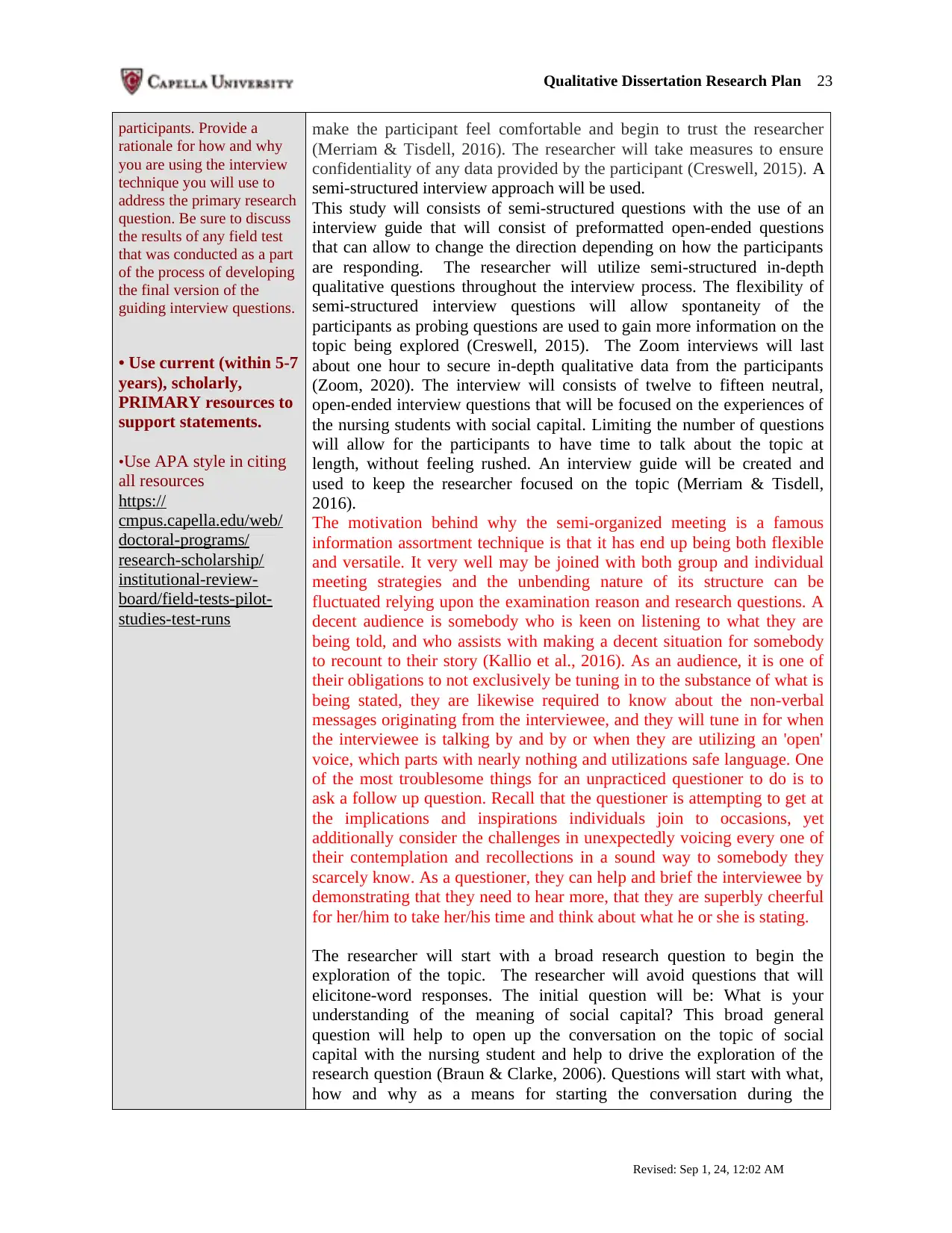
Qualitative Dissertation Research Plan 23
participants. Provide a
rationale for how and why
you are using the interview
technique you will use to
address the primary research
question. Be sure to discuss
the results of any field test
that was conducted as a part
of the process of developing
the final version of the
guiding interview questions.
• Use current (within 5-7
years), scholarly,
PRIMARY resources to
support statements.
•Use APA style in citing
all resources
https://
cmpus.capella.edu/web/
doctoral-programs/
research-scholarship/
institutional-review-
board/field-tests-pilot-
studies-test-runs
make the participant feel comfortable and begin to trust the researcher
(Merriam & Tisdell, 2016). The researcher will take measures to ensure
confidentiality of any data provided by the participant (Creswell, 2015). A
semi-structured interview approach will be used.
This study will consists of semi-structured questions with the use of an
interview guide that will consist of preformatted open-ended questions
that can allow to change the direction depending on how the participants
are responding. The researcher will utilize semi-structured in-depth
qualitative questions throughout the interview process. The flexibility of
semi-structured interview questions will allow spontaneity of the
participants as probing questions are used to gain more information on the
topic being explored (Creswell, 2015). The Zoom interviews will last
about one hour to secure in-depth qualitative data from the participants
(Zoom, 2020). The interview will consists of twelve to fifteen neutral,
open-ended interview questions that will be focused on the experiences of
the nursing students with social capital. Limiting the number of questions
will allow for the participants to have time to talk about the topic at
length, without feeling rushed. An interview guide will be created and
used to keep the researcher focused on the topic (Merriam & Tisdell,
2016).
The motivation behind why the semi-organized meeting is a famous
information assortment technique is that it has end up being both flexible
and versatile. It very well may be joined with both group and individual
meeting strategies and the unbending nature of its structure can be
fluctuated relying upon the examination reason and research questions. A
decent audience is somebody who is keen on listening to what they are
being told, and who assists with making a decent situation for somebody
to recount to their story (Kallio et al., 2016). As an audience, it is one of
their obligations to not exclusively be tuning in to the substance of what is
being stated, they are likewise required to know about the non-verbal
messages originating from the interviewee, and they will tune in for when
the interviewee is talking by and by or when they are utilizing an 'open'
voice, which parts with nearly nothing and utilizations safe language. One
of the most troublesome things for an unpracticed questioner to do is to
ask a follow up question. Recall that the questioner is attempting to get at
the implications and inspirations individuals join to occasions, yet
additionally consider the challenges in unexpectedly voicing every one of
their contemplation and recollections in a sound way to somebody they
scarcely know. As a questioner, they can help and brief the interviewee by
demonstrating that they need to hear more, that they are superbly cheerful
for her/him to take her/his time and think about what he or she is stating.
The researcher will start with a broad research question to begin the
exploration of the topic. The researcher will avoid questions that will
elicitone-word responses. The initial question will be: What is your
understanding of the meaning of social capital? This broad general
question will help to open up the conversation on the topic of social
capital with the nursing student and help to drive the exploration of the
research question (Braun & Clarke, 2006). Questions will start with what,
how and why as a means for starting the conversation during the
Revised: Sep 1, 24, 12:02 AM
participants. Provide a
rationale for how and why
you are using the interview
technique you will use to
address the primary research
question. Be sure to discuss
the results of any field test
that was conducted as a part
of the process of developing
the final version of the
guiding interview questions.
• Use current (within 5-7
years), scholarly,
PRIMARY resources to
support statements.
•Use APA style in citing
all resources
https://
cmpus.capella.edu/web/
doctoral-programs/
research-scholarship/
institutional-review-
board/field-tests-pilot-
studies-test-runs
make the participant feel comfortable and begin to trust the researcher
(Merriam & Tisdell, 2016). The researcher will take measures to ensure
confidentiality of any data provided by the participant (Creswell, 2015). A
semi-structured interview approach will be used.
This study will consists of semi-structured questions with the use of an
interview guide that will consist of preformatted open-ended questions
that can allow to change the direction depending on how the participants
are responding. The researcher will utilize semi-structured in-depth
qualitative questions throughout the interview process. The flexibility of
semi-structured interview questions will allow spontaneity of the
participants as probing questions are used to gain more information on the
topic being explored (Creswell, 2015). The Zoom interviews will last
about one hour to secure in-depth qualitative data from the participants
(Zoom, 2020). The interview will consists of twelve to fifteen neutral,
open-ended interview questions that will be focused on the experiences of
the nursing students with social capital. Limiting the number of questions
will allow for the participants to have time to talk about the topic at
length, without feeling rushed. An interview guide will be created and
used to keep the researcher focused on the topic (Merriam & Tisdell,
2016).
The motivation behind why the semi-organized meeting is a famous
information assortment technique is that it has end up being both flexible
and versatile. It very well may be joined with both group and individual
meeting strategies and the unbending nature of its structure can be
fluctuated relying upon the examination reason and research questions. A
decent audience is somebody who is keen on listening to what they are
being told, and who assists with making a decent situation for somebody
to recount to their story (Kallio et al., 2016). As an audience, it is one of
their obligations to not exclusively be tuning in to the substance of what is
being stated, they are likewise required to know about the non-verbal
messages originating from the interviewee, and they will tune in for when
the interviewee is talking by and by or when they are utilizing an 'open'
voice, which parts with nearly nothing and utilizations safe language. One
of the most troublesome things for an unpracticed questioner to do is to
ask a follow up question. Recall that the questioner is attempting to get at
the implications and inspirations individuals join to occasions, yet
additionally consider the challenges in unexpectedly voicing every one of
their contemplation and recollections in a sound way to somebody they
scarcely know. As a questioner, they can help and brief the interviewee by
demonstrating that they need to hear more, that they are superbly cheerful
for her/him to take her/his time and think about what he or she is stating.
The researcher will start with a broad research question to begin the
exploration of the topic. The researcher will avoid questions that will
elicitone-word responses. The initial question will be: What is your
understanding of the meaning of social capital? This broad general
question will help to open up the conversation on the topic of social
capital with the nursing student and help to drive the exploration of the
research question (Braun & Clarke, 2006). Questions will start with what,
how and why as a means for starting the conversation during the
Revised: Sep 1, 24, 12:02 AM
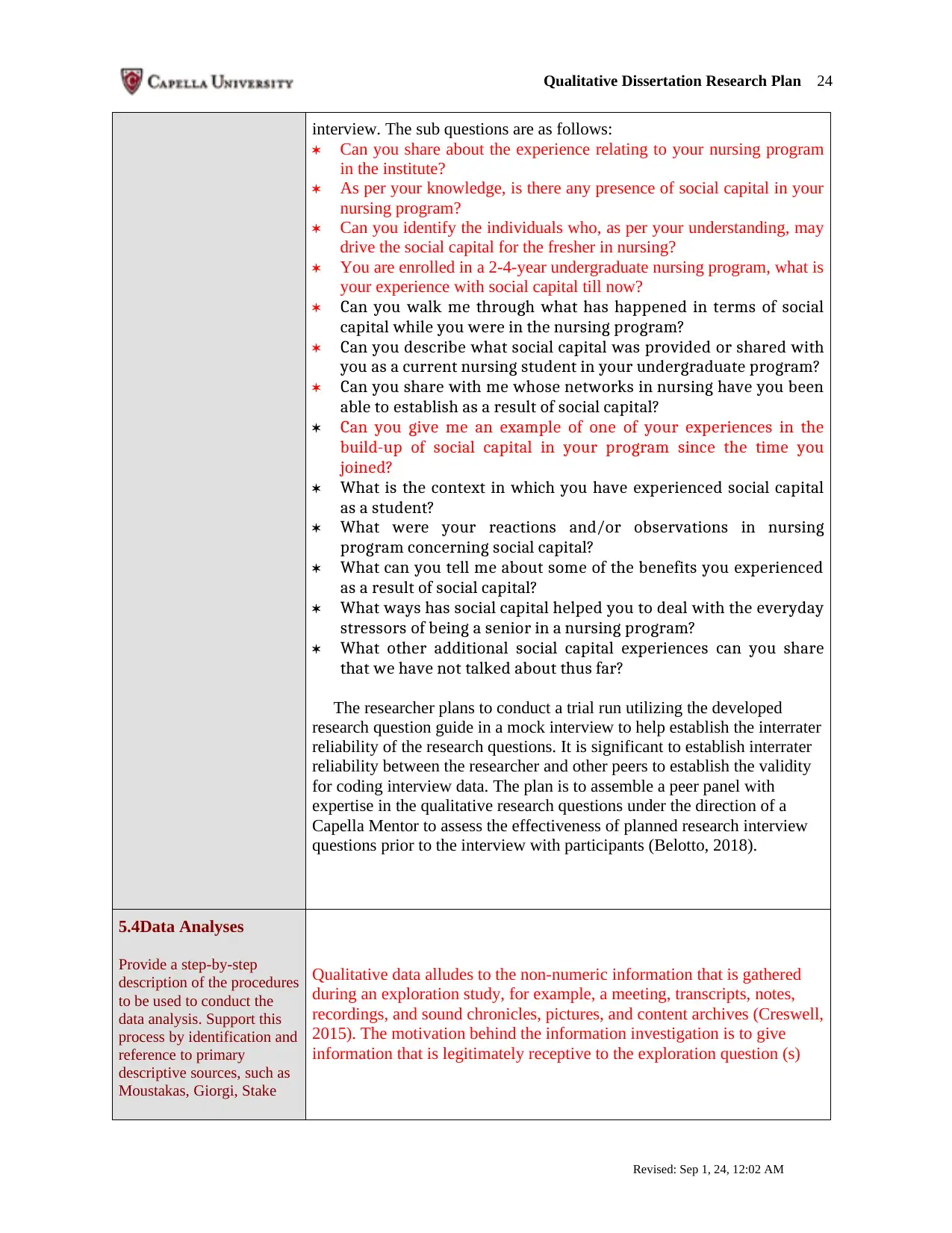
Qualitative Dissertation Research Plan 24
interview. The sub questions are as follows:
Can you share about the experience relating to your nursing program
in the institute?
As per your knowledge, is there any presence of social capital in your
nursing program?
Can you identify the individuals who, as per your understanding, may
drive the social capital for the fresher in nursing?
You are enrolled in a 2-4-year undergraduate nursing program, what is
your experience with social capital till now?
Can you walk me through what has happened in terms of social
capital while you were in the nursing program?
Can you describe what social capital was provided or shared with
you as a current nursing student in your undergraduate program?
Can you share with me whose networks in nursing have you been
able to establish as a result of social capital?
Can you give me an example of one of your experiences in the
build-up of social capital in your program since the time you
joined?
What is the context in which you have experienced social capital
as a student?
What were your reactions and/or observations in nursing
program concerning social capital?
What can you tell me about some of the benefits you experienced
as a result of social capital?
What ways has social capital helped you to deal with the everyday
stressors of being a senior in a nursing program?
What other additional social capital experiences can you share
that we have not talked about thus far?
The researcher plans to conduct a trial run utilizing the developed
research question guide in a mock interview to help establish the interrater
reliability of the research questions. It is significant to establish interrater
reliability between the researcher and other peers to establish the validity
for coding interview data. The plan is to assemble a peer panel with
expertise in the qualitative research questions under the direction of a
Capella Mentor to assess the effectiveness of planned research interview
questions prior to the interview with participants (Belotto, 2018).
5.4Data Analyses
Provide a step-by-step
description of the procedures
to be used to conduct the
data analysis. Support this
process by identification and
reference to primary
descriptive sources, such as
Moustakas, Giorgi, Stake
Qualitative data alludes to the non-numeric information that is gathered
during an exploration study, for example, a meeting, transcripts, notes,
recordings, and sound chronicles, pictures, and content archives (Creswell,
2015). The motivation behind the information investigation is to give
information that is legitimately receptive to the exploration question (s)
Revised: Sep 1, 24, 12:02 AM
interview. The sub questions are as follows:
Can you share about the experience relating to your nursing program
in the institute?
As per your knowledge, is there any presence of social capital in your
nursing program?
Can you identify the individuals who, as per your understanding, may
drive the social capital for the fresher in nursing?
You are enrolled in a 2-4-year undergraduate nursing program, what is
your experience with social capital till now?
Can you walk me through what has happened in terms of social
capital while you were in the nursing program?
Can you describe what social capital was provided or shared with
you as a current nursing student in your undergraduate program?
Can you share with me whose networks in nursing have you been
able to establish as a result of social capital?
Can you give me an example of one of your experiences in the
build-up of social capital in your program since the time you
joined?
What is the context in which you have experienced social capital
as a student?
What were your reactions and/or observations in nursing
program concerning social capital?
What can you tell me about some of the benefits you experienced
as a result of social capital?
What ways has social capital helped you to deal with the everyday
stressors of being a senior in a nursing program?
What other additional social capital experiences can you share
that we have not talked about thus far?
The researcher plans to conduct a trial run utilizing the developed
research question guide in a mock interview to help establish the interrater
reliability of the research questions. It is significant to establish interrater
reliability between the researcher and other peers to establish the validity
for coding interview data. The plan is to assemble a peer panel with
expertise in the qualitative research questions under the direction of a
Capella Mentor to assess the effectiveness of planned research interview
questions prior to the interview with participants (Belotto, 2018).
5.4Data Analyses
Provide a step-by-step
description of the procedures
to be used to conduct the
data analysis. Support this
process by identification and
reference to primary
descriptive sources, such as
Moustakas, Giorgi, Stake
Qualitative data alludes to the non-numeric information that is gathered
during an exploration study, for example, a meeting, transcripts, notes,
recordings, and sound chronicles, pictures, and content archives (Creswell,
2015). The motivation behind the information investigation is to give
information that is legitimately receptive to the exploration question (s)
Revised: Sep 1, 24, 12:02 AM
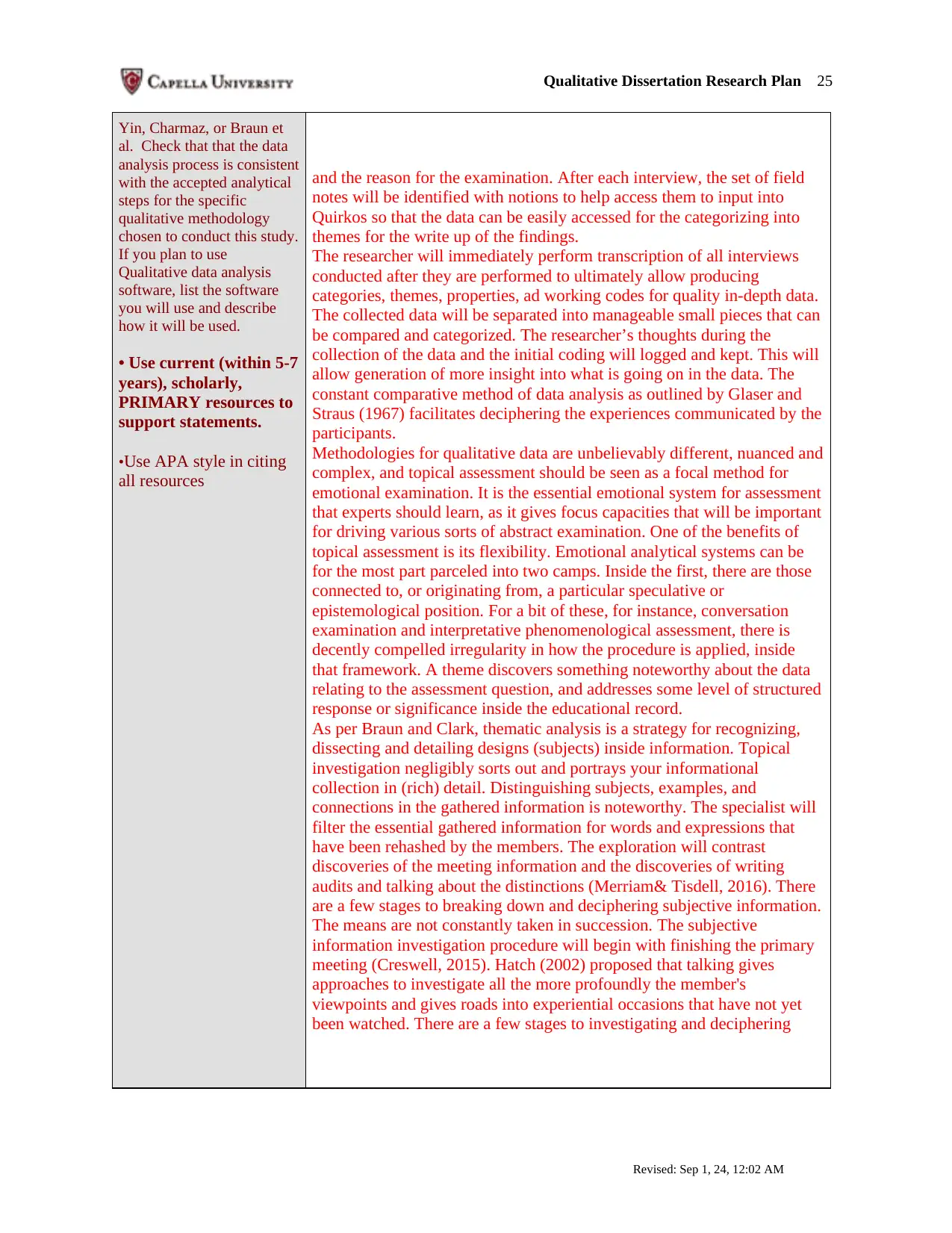
Qualitative Dissertation Research Plan 25
Yin, Charmaz, or Braun et
al. Check that that the data
analysis process is consistent
with the accepted analytical
steps for the specific
qualitative methodology
chosen to conduct this study.
If you plan to use
Qualitative data analysis
software, list the software
you will use and describe
how it will be used.
• Use current (within 5-7
years), scholarly,
PRIMARY resources to
support statements.
•Use APA style in citing
all resources
and the reason for the examination. After each interview, the set of field
notes will be identified with notions to help access them to input into
Quirkos so that the data can be easily accessed for the categorizing into
themes for the write up of the findings.
The researcher will immediately perform transcription of all interviews
conducted after they are performed to ultimately allow producing
categories, themes, properties, ad working codes for quality in-depth data.
The collected data will be separated into manageable small pieces that can
be compared and categorized. The researcher’s thoughts during the
collection of the data and the initial coding will logged and kept. This will
allow generation of more insight into what is going on in the data. The
constant comparative method of data analysis as outlined by Glaser and
Straus (1967) facilitates deciphering the experiences communicated by the
participants.
Methodologies for qualitative data are unbelievably different, nuanced and
complex, and topical assessment should be seen as a focal method for
emotional examination. It is the essential emotional system for assessment
that experts should learn, as it gives focus capacities that will be important
for driving various sorts of abstract examination. One of the benefits of
topical assessment is its flexibility. Emotional analytical systems can be
for the most part parceled into two camps. Inside the first, there are those
connected to, or originating from, a particular speculative or
epistemological position. For a bit of these, for instance, conversation
examination and interpretative phenomenological assessment, there is
decently compelled irregularity in how the procedure is applied, inside
that framework. A theme discovers something noteworthy about the data
relating to the assessment question, and addresses some level of structured
response or significance inside the educational record.
As per Braun and Clark, thematic analysis is a strategy for recognizing,
dissecting and detailing designs (subjects) inside information. Topical
investigation negligibly sorts out and portrays your informational
collection in (rich) detail. Distinguishing subjects, examples, and
connections in the gathered information is noteworthy. The specialist will
filter the essential gathered information for words and expressions that
have been rehashed by the members. The exploration will contrast
discoveries of the meeting information and the discoveries of writing
audits and talking about the distinctions (Merriam& Tisdell, 2016). There
are a few stages to breaking down and deciphering subjective information.
The means are not constantly taken in succession. The subjective
information investigation procedure will begin with finishing the primary
meeting (Creswell, 2015). Hatch (2002) proposed that talking gives
approaches to investigate all the more profoundly the member's
viewpoints and gives roads into experiential occasions that have not yet
been watched. There are a few stages to investigating and deciphering
Revised: Sep 1, 24, 12:02 AM
Yin, Charmaz, or Braun et
al. Check that that the data
analysis process is consistent
with the accepted analytical
steps for the specific
qualitative methodology
chosen to conduct this study.
If you plan to use
Qualitative data analysis
software, list the software
you will use and describe
how it will be used.
• Use current (within 5-7
years), scholarly,
PRIMARY resources to
support statements.
•Use APA style in citing
all resources
and the reason for the examination. After each interview, the set of field
notes will be identified with notions to help access them to input into
Quirkos so that the data can be easily accessed for the categorizing into
themes for the write up of the findings.
The researcher will immediately perform transcription of all interviews
conducted after they are performed to ultimately allow producing
categories, themes, properties, ad working codes for quality in-depth data.
The collected data will be separated into manageable small pieces that can
be compared and categorized. The researcher’s thoughts during the
collection of the data and the initial coding will logged and kept. This will
allow generation of more insight into what is going on in the data. The
constant comparative method of data analysis as outlined by Glaser and
Straus (1967) facilitates deciphering the experiences communicated by the
participants.
Methodologies for qualitative data are unbelievably different, nuanced and
complex, and topical assessment should be seen as a focal method for
emotional examination. It is the essential emotional system for assessment
that experts should learn, as it gives focus capacities that will be important
for driving various sorts of abstract examination. One of the benefits of
topical assessment is its flexibility. Emotional analytical systems can be
for the most part parceled into two camps. Inside the first, there are those
connected to, or originating from, a particular speculative or
epistemological position. For a bit of these, for instance, conversation
examination and interpretative phenomenological assessment, there is
decently compelled irregularity in how the procedure is applied, inside
that framework. A theme discovers something noteworthy about the data
relating to the assessment question, and addresses some level of structured
response or significance inside the educational record.
As per Braun and Clark, thematic analysis is a strategy for recognizing,
dissecting and detailing designs (subjects) inside information. Topical
investigation negligibly sorts out and portrays your informational
collection in (rich) detail. Distinguishing subjects, examples, and
connections in the gathered information is noteworthy. The specialist will
filter the essential gathered information for words and expressions that
have been rehashed by the members. The exploration will contrast
discoveries of the meeting information and the discoveries of writing
audits and talking about the distinctions (Merriam& Tisdell, 2016). There
are a few stages to breaking down and deciphering subjective information.
The means are not constantly taken in succession. The subjective
information investigation procedure will begin with finishing the primary
meeting (Creswell, 2015). Hatch (2002) proposed that talking gives
approaches to investigate all the more profoundly the member's
viewpoints and gives roads into experiential occasions that have not yet
been watched. There are a few stages to investigating and deciphering
Revised: Sep 1, 24, 12:02 AM
Paraphrase This Document
Need a fresh take? Get an instant paraphrase of this document with our AI Paraphraser
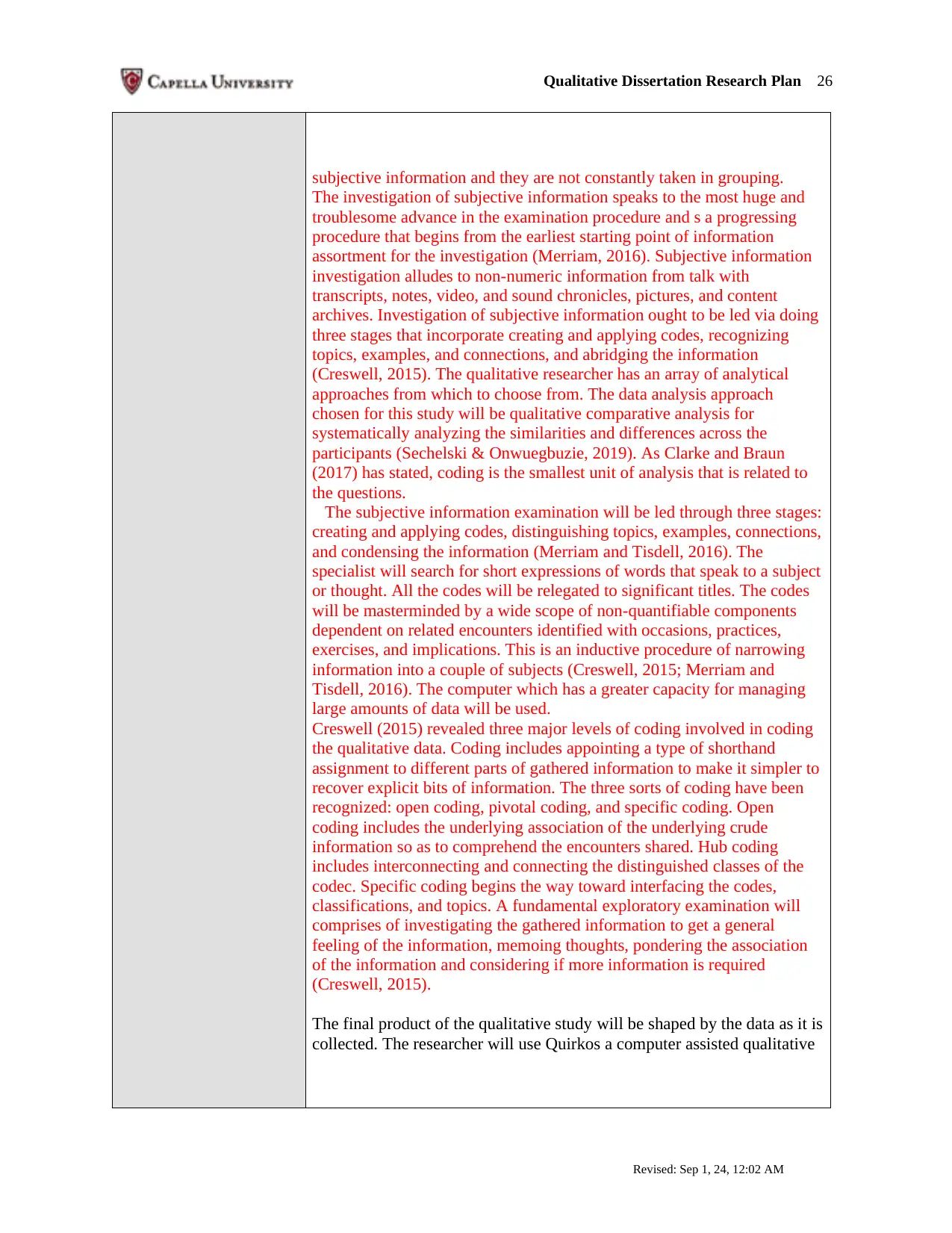
Qualitative Dissertation Research Plan 26
subjective information and they are not constantly taken in grouping.
The investigation of subjective information speaks to the most huge and
troublesome advance in the examination procedure and s a progressing
procedure that begins from the earliest starting point of information
assortment for the investigation (Merriam, 2016). Subjective information
investigation alludes to non-numeric information from talk with
transcripts, notes, video, and sound chronicles, pictures, and content
archives. Investigation of subjective information ought to be led via doing
three stages that incorporate creating and applying codes, recognizing
topics, examples, and connections, and abridging the information
(Creswell, 2015). The qualitative researcher has an array of analytical
approaches from which to choose from. The data analysis approach
chosen for this study will be qualitative comparative analysis for
systematically analyzing the similarities and differences across the
participants (Sechelski & Onwuegbuzie, 2019). As Clarke and Braun
(2017) has stated, coding is the smallest unit of analysis that is related to
the questions.
The subjective information examination will be led through three stages:
creating and applying codes, distinguishing topics, examples, connections,
and condensing the information (Merriam and Tisdell, 2016). The
specialist will search for short expressions of words that speak to a subject
or thought. All the codes will be relegated to significant titles. The codes
will be masterminded by a wide scope of non-quantifiable components
dependent on related encounters identified with occasions, practices,
exercises, and implications. This is an inductive procedure of narrowing
information into a couple of subjects (Creswell, 2015; Merriam and
Tisdell, 2016). The computer which has a greater capacity for managing
large amounts of data will be used.
Creswell (2015) revealed three major levels of coding involved in coding
the qualitative data. Coding includes appointing a type of shorthand
assignment to different parts of gathered information to make it simpler to
recover explicit bits of information. The three sorts of coding have been
recognized: open coding, pivotal coding, and specific coding. Open
coding includes the underlying association of the underlying crude
information so as to comprehend the encounters shared. Hub coding
includes interconnecting and connecting the distinguished classes of the
codec. Specific coding begins the way toward interfacing the codes,
classifications, and topics. A fundamental exploratory examination will
comprises of investigating the gathered information to get a general
feeling of the information, memoing thoughts, pondering the association
of the information and considering if more information is required
(Creswell, 2015).
The final product of the qualitative study will be shaped by the data as it is
collected. The researcher will use Quirkos a computer assisted qualitative
Revised: Sep 1, 24, 12:02 AM
subjective information and they are not constantly taken in grouping.
The investigation of subjective information speaks to the most huge and
troublesome advance in the examination procedure and s a progressing
procedure that begins from the earliest starting point of information
assortment for the investigation (Merriam, 2016). Subjective information
investigation alludes to non-numeric information from talk with
transcripts, notes, video, and sound chronicles, pictures, and content
archives. Investigation of subjective information ought to be led via doing
three stages that incorporate creating and applying codes, recognizing
topics, examples, and connections, and abridging the information
(Creswell, 2015). The qualitative researcher has an array of analytical
approaches from which to choose from. The data analysis approach
chosen for this study will be qualitative comparative analysis for
systematically analyzing the similarities and differences across the
participants (Sechelski & Onwuegbuzie, 2019). As Clarke and Braun
(2017) has stated, coding is the smallest unit of analysis that is related to
the questions.
The subjective information examination will be led through three stages:
creating and applying codes, distinguishing topics, examples, connections,
and condensing the information (Merriam and Tisdell, 2016). The
specialist will search for short expressions of words that speak to a subject
or thought. All the codes will be relegated to significant titles. The codes
will be masterminded by a wide scope of non-quantifiable components
dependent on related encounters identified with occasions, practices,
exercises, and implications. This is an inductive procedure of narrowing
information into a couple of subjects (Creswell, 2015; Merriam and
Tisdell, 2016). The computer which has a greater capacity for managing
large amounts of data will be used.
Creswell (2015) revealed three major levels of coding involved in coding
the qualitative data. Coding includes appointing a type of shorthand
assignment to different parts of gathered information to make it simpler to
recover explicit bits of information. The three sorts of coding have been
recognized: open coding, pivotal coding, and specific coding. Open
coding includes the underlying association of the underlying crude
information so as to comprehend the encounters shared. Hub coding
includes interconnecting and connecting the distinguished classes of the
codec. Specific coding begins the way toward interfacing the codes,
classifications, and topics. A fundamental exploratory examination will
comprises of investigating the gathered information to get a general
feeling of the information, memoing thoughts, pondering the association
of the information and considering if more information is required
(Creswell, 2015).
The final product of the qualitative study will be shaped by the data as it is
collected. The researcher will use Quirkos a computer assisted qualitative
Revised: Sep 1, 24, 12:02 AM
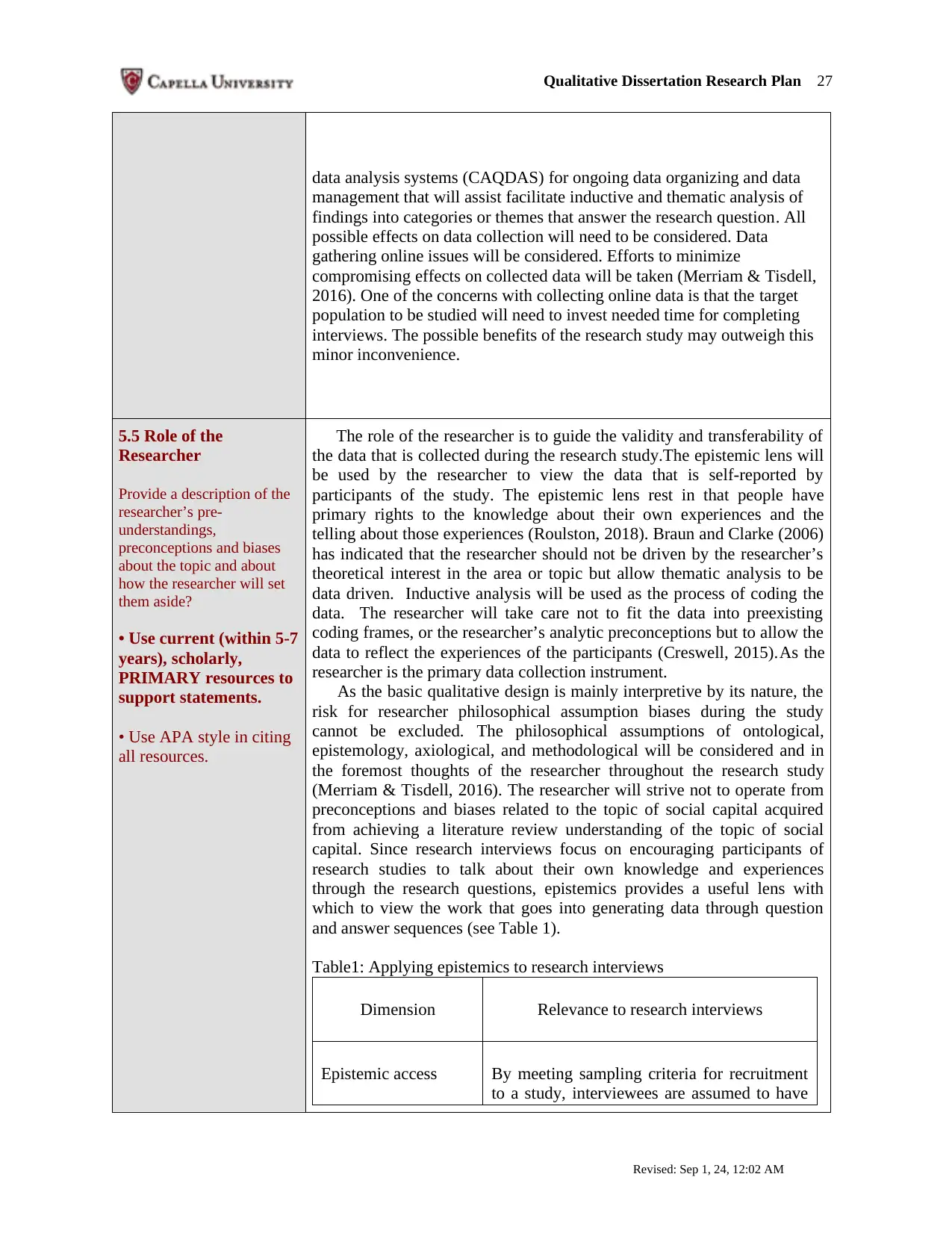
Qualitative Dissertation Research Plan 27
data analysis systems (CAQDAS) for ongoing data organizing and data
management that will assist facilitate inductive and thematic analysis of
findings into categories or themes that answer the research question. All
possible effects on data collection will need to be considered. Data
gathering online issues will be considered. Efforts to minimize
compromising effects on collected data will be taken (Merriam & Tisdell,
2016). One of the concerns with collecting online data is that the target
population to be studied will need to invest needed time for completing
interviews. The possible benefits of the research study may outweigh this
minor inconvenience.
5.5 Role of the
Researcher
Provide a description of the
researcher’s pre-
understandings,
preconceptions and biases
about the topic and about
how the researcher will set
them aside?
• Use current (within 5-7
years), scholarly,
PRIMARY resources to
support statements.
• Use APA style in citing
all resources.
The role of the researcher is to guide the validity and transferability of
the data that is collected during the research study.The epistemic lens will
be used by the researcher to view the data that is self-reported by
participants of the study. The epistemic lens rest in that people have
primary rights to the knowledge about their own experiences and the
telling about those experiences (Roulston, 2018). Braun and Clarke (2006)
has indicated that the researcher should not be driven by the researcher’s
theoretical interest in the area or topic but allow thematic analysis to be
data driven. Inductive analysis will be used as the process of coding the
data. The researcher will take care not to fit the data into preexisting
coding frames, or the researcher’s analytic preconceptions but to allow the
data to reflect the experiences of the participants (Creswell, 2015).As the
researcher is the primary data collection instrument.
As the basic qualitative design is mainly interpretive by its nature, the
risk for researcher philosophical assumption biases during the study
cannot be excluded. The philosophical assumptions of ontological,
epistemology, axiological, and methodological will be considered and in
the foremost thoughts of the researcher throughout the research study
(Merriam & Tisdell, 2016). The researcher will strive not to operate from
preconceptions and biases related to the topic of social capital acquired
from achieving a literature review understanding of the topic of social
capital. Since research interviews focus on encouraging participants of
research studies to talk about their own knowledge and experiences
through the research questions, epistemics provides a useful lens with
which to view the work that goes into generating data through question
and answer sequences (see Table 1).
Table1: Applying epistemics to research interviews
Dimension Relevance to research interviews
Epistemic access By meeting sampling criteria for recruitment
to a study, interviewees are assumed to have
Revised: Sep 1, 24, 12:02 AM
data analysis systems (CAQDAS) for ongoing data organizing and data
management that will assist facilitate inductive and thematic analysis of
findings into categories or themes that answer the research question. All
possible effects on data collection will need to be considered. Data
gathering online issues will be considered. Efforts to minimize
compromising effects on collected data will be taken (Merriam & Tisdell,
2016). One of the concerns with collecting online data is that the target
population to be studied will need to invest needed time for completing
interviews. The possible benefits of the research study may outweigh this
minor inconvenience.
5.5 Role of the
Researcher
Provide a description of the
researcher’s pre-
understandings,
preconceptions and biases
about the topic and about
how the researcher will set
them aside?
• Use current (within 5-7
years), scholarly,
PRIMARY resources to
support statements.
• Use APA style in citing
all resources.
The role of the researcher is to guide the validity and transferability of
the data that is collected during the research study.The epistemic lens will
be used by the researcher to view the data that is self-reported by
participants of the study. The epistemic lens rest in that people have
primary rights to the knowledge about their own experiences and the
telling about those experiences (Roulston, 2018). Braun and Clarke (2006)
has indicated that the researcher should not be driven by the researcher’s
theoretical interest in the area or topic but allow thematic analysis to be
data driven. Inductive analysis will be used as the process of coding the
data. The researcher will take care not to fit the data into preexisting
coding frames, or the researcher’s analytic preconceptions but to allow the
data to reflect the experiences of the participants (Creswell, 2015).As the
researcher is the primary data collection instrument.
As the basic qualitative design is mainly interpretive by its nature, the
risk for researcher philosophical assumption biases during the study
cannot be excluded. The philosophical assumptions of ontological,
epistemology, axiological, and methodological will be considered and in
the foremost thoughts of the researcher throughout the research study
(Merriam & Tisdell, 2016). The researcher will strive not to operate from
preconceptions and biases related to the topic of social capital acquired
from achieving a literature review understanding of the topic of social
capital. Since research interviews focus on encouraging participants of
research studies to talk about their own knowledge and experiences
through the research questions, epistemics provides a useful lens with
which to view the work that goes into generating data through question
and answer sequences (see Table 1).
Table1: Applying epistemics to research interviews
Dimension Relevance to research interviews
Epistemic access By meeting sampling criteria for recruitment
to a study, interviewees are assumed to have
Revised: Sep 1, 24, 12:02 AM
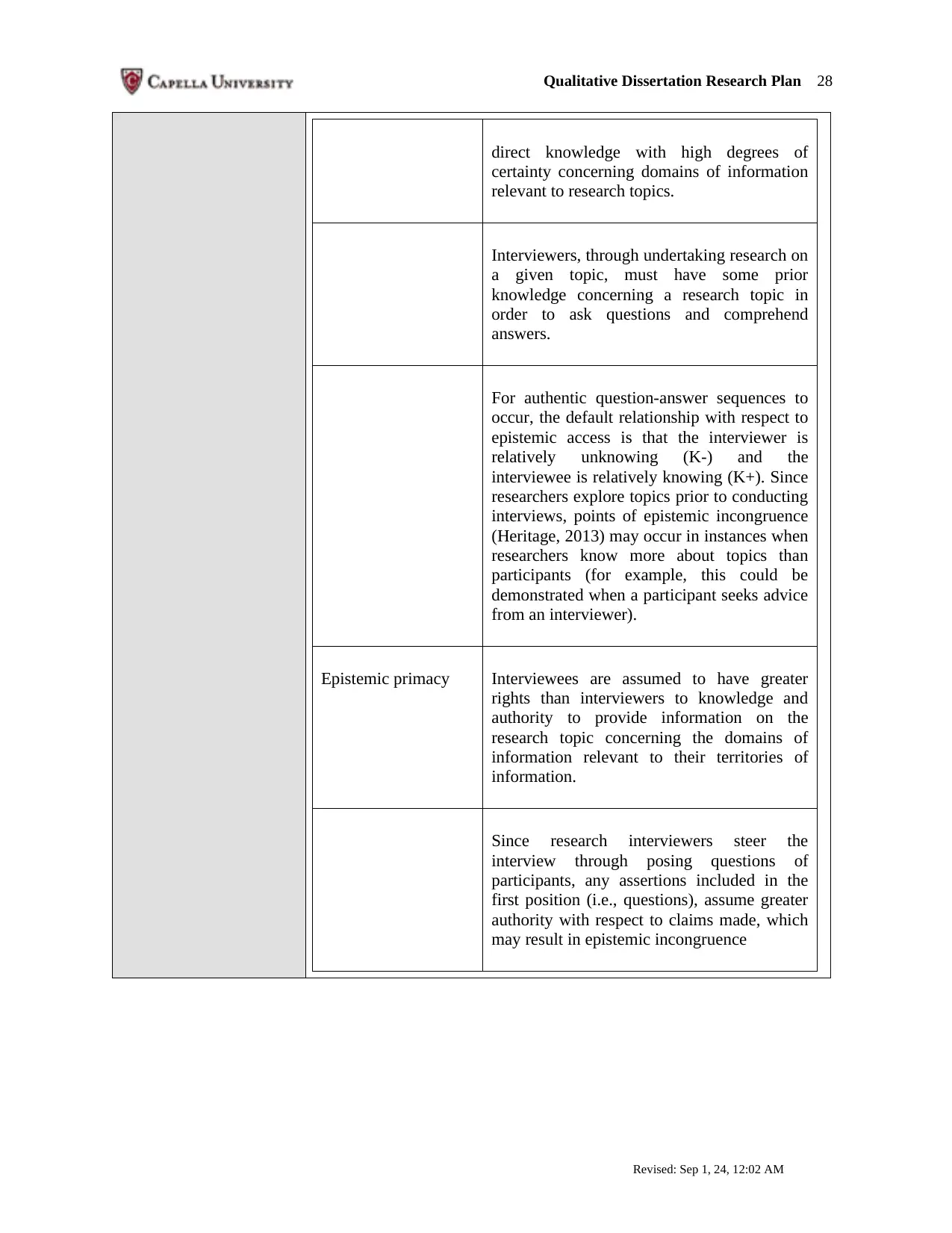
Qualitative Dissertation Research Plan 28
direct knowledge with high degrees of
certainty concerning domains of information
relevant to research topics.
Interviewers, through undertaking research on
a given topic, must have some prior
knowledge concerning a research topic in
order to ask questions and comprehend
answers.
For authentic question-answer sequences to
occur, the default relationship with respect to
epistemic access is that the interviewer is
relatively unknowing (K-) and the
interviewee is relatively knowing (K+). Since
researchers explore topics prior to conducting
interviews, points of epistemic incongruence
(Heritage, 2013) may occur in instances when
researchers know more about topics than
participants (for example, this could be
demonstrated when a participant seeks advice
from an interviewer).
Epistemic primacy Interviewees are assumed to have greater
rights than interviewers to knowledge and
authority to provide information on the
research topic concerning the domains of
information relevant to their territories of
information.
Since research interviewers steer the
interview through posing questions of
participants, any assertions included in the
first position (i.e., questions), assume greater
authority with respect to claims made, which
may result in epistemic incongruence
Revised: Sep 1, 24, 12:02 AM
direct knowledge with high degrees of
certainty concerning domains of information
relevant to research topics.
Interviewers, through undertaking research on
a given topic, must have some prior
knowledge concerning a research topic in
order to ask questions and comprehend
answers.
For authentic question-answer sequences to
occur, the default relationship with respect to
epistemic access is that the interviewer is
relatively unknowing (K-) and the
interviewee is relatively knowing (K+). Since
researchers explore topics prior to conducting
interviews, points of epistemic incongruence
(Heritage, 2013) may occur in instances when
researchers know more about topics than
participants (for example, this could be
demonstrated when a participant seeks advice
from an interviewer).
Epistemic primacy Interviewees are assumed to have greater
rights than interviewers to knowledge and
authority to provide information on the
research topic concerning the domains of
information relevant to their territories of
information.
Since research interviewers steer the
interview through posing questions of
participants, any assertions included in the
first position (i.e., questions), assume greater
authority with respect to claims made, which
may result in epistemic incongruence
Revised: Sep 1, 24, 12:02 AM
Secure Best Marks with AI Grader
Need help grading? Try our AI Grader for instant feedback on your assignments.
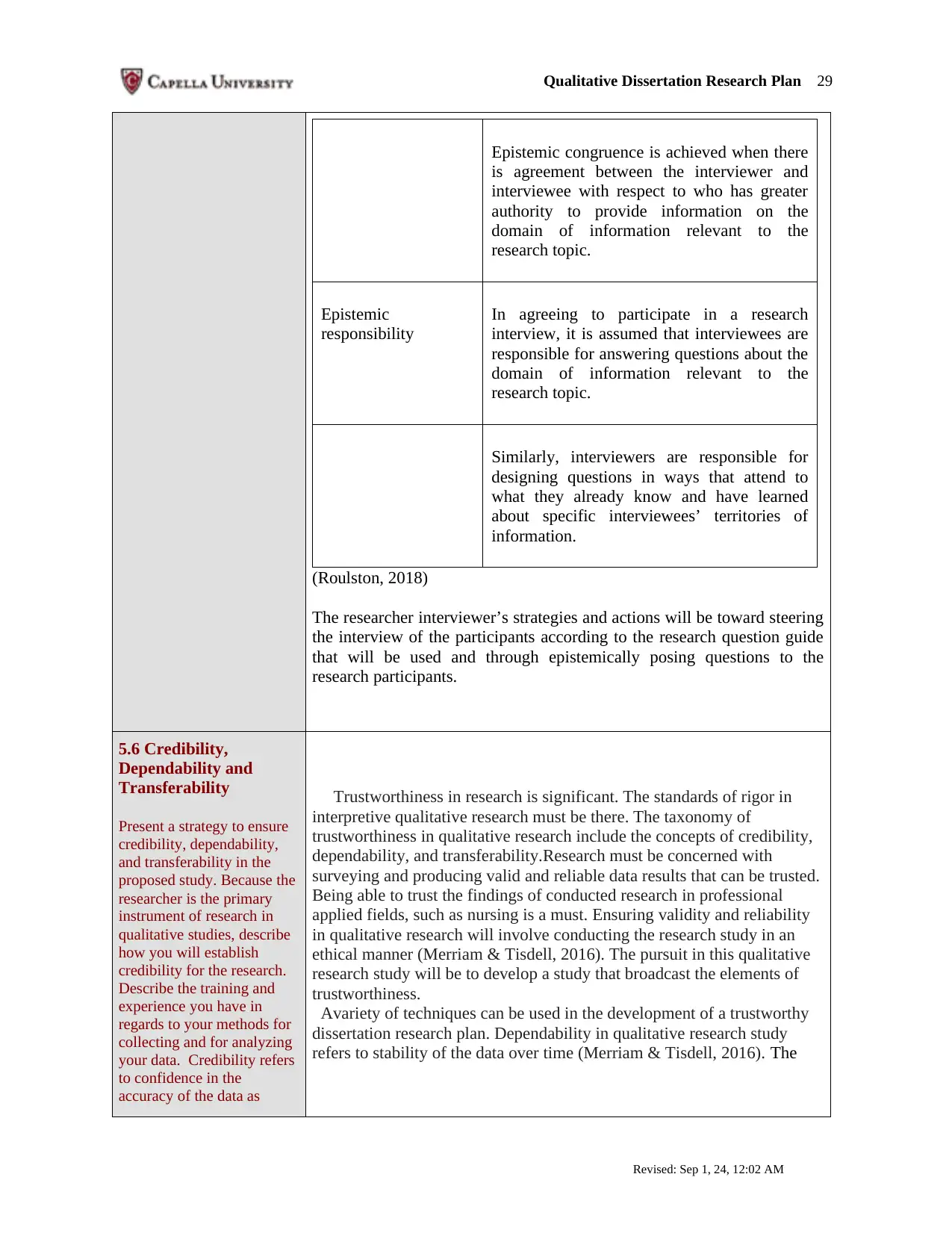
Qualitative Dissertation Research Plan 29
Epistemic congruence is achieved when there
is agreement between the interviewer and
interviewee with respect to who has greater
authority to provide information on the
domain of information relevant to the
research topic.
Epistemic
responsibility
In agreeing to participate in a research
interview, it is assumed that interviewees are
responsible for answering questions about the
domain of information relevant to the
research topic.
Similarly, interviewers are responsible for
designing questions in ways that attend to
what they already know and have learned
about specific interviewees’ territories of
information.
(Roulston, 2018)
The researcher interviewer’s strategies and actions will be toward steering
the interview of the participants according to the research question guide
that will be used and through epistemically posing questions to the
research participants.
5.6 Credibility,
Dependability and
Transferability
Present a strategy to ensure
credibility, dependability,
and transferability in the
proposed study. Because the
researcher is the primary
instrument of research in
qualitative studies, describe
how you will establish
credibility for the research.
Describe the training and
experience you have in
regards to your methods for
collecting and for analyzing
your data. Credibility refers
to confidence in the
accuracy of the data as
Trustworthiness in research is significant. The standards of rigor in
interpretive qualitative research must be there. The taxonomy of
trustworthiness in qualitative research include the concepts of credibility,
dependability, and transferability.Research must be concerned with
surveying and producing valid and reliable data results that can be trusted.
Being able to trust the findings of conducted research in professional
applied fields, such as nursing is a must. Ensuring validity and reliability
in qualitative research will involve conducting the research study in an
ethical manner (Merriam & Tisdell, 2016). The pursuit in this qualitative
research study will be to develop a study that broadcast the elements of
trustworthiness.
Avariety of techniques can be used in the development of a trustworthy
dissertation research plan. Dependability in qualitative research study
refers to stability of the data over time (Merriam & Tisdell, 2016). The
Revised: Sep 1, 24, 12:02 AM
Epistemic congruence is achieved when there
is agreement between the interviewer and
interviewee with respect to who has greater
authority to provide information on the
domain of information relevant to the
research topic.
Epistemic
responsibility
In agreeing to participate in a research
interview, it is assumed that interviewees are
responsible for answering questions about the
domain of information relevant to the
research topic.
Similarly, interviewers are responsible for
designing questions in ways that attend to
what they already know and have learned
about specific interviewees’ territories of
information.
(Roulston, 2018)
The researcher interviewer’s strategies and actions will be toward steering
the interview of the participants according to the research question guide
that will be used and through epistemically posing questions to the
research participants.
5.6 Credibility,
Dependability and
Transferability
Present a strategy to ensure
credibility, dependability,
and transferability in the
proposed study. Because the
researcher is the primary
instrument of research in
qualitative studies, describe
how you will establish
credibility for the research.
Describe the training and
experience you have in
regards to your methods for
collecting and for analyzing
your data. Credibility refers
to confidence in the
accuracy of the data as
Trustworthiness in research is significant. The standards of rigor in
interpretive qualitative research must be there. The taxonomy of
trustworthiness in qualitative research include the concepts of credibility,
dependability, and transferability.Research must be concerned with
surveying and producing valid and reliable data results that can be trusted.
Being able to trust the findings of conducted research in professional
applied fields, such as nursing is a must. Ensuring validity and reliability
in qualitative research will involve conducting the research study in an
ethical manner (Merriam & Tisdell, 2016). The pursuit in this qualitative
research study will be to develop a study that broadcast the elements of
trustworthiness.
Avariety of techniques can be used in the development of a trustworthy
dissertation research plan. Dependability in qualitative research study
refers to stability of the data over time (Merriam & Tisdell, 2016). The
Revised: Sep 1, 24, 12:02 AM
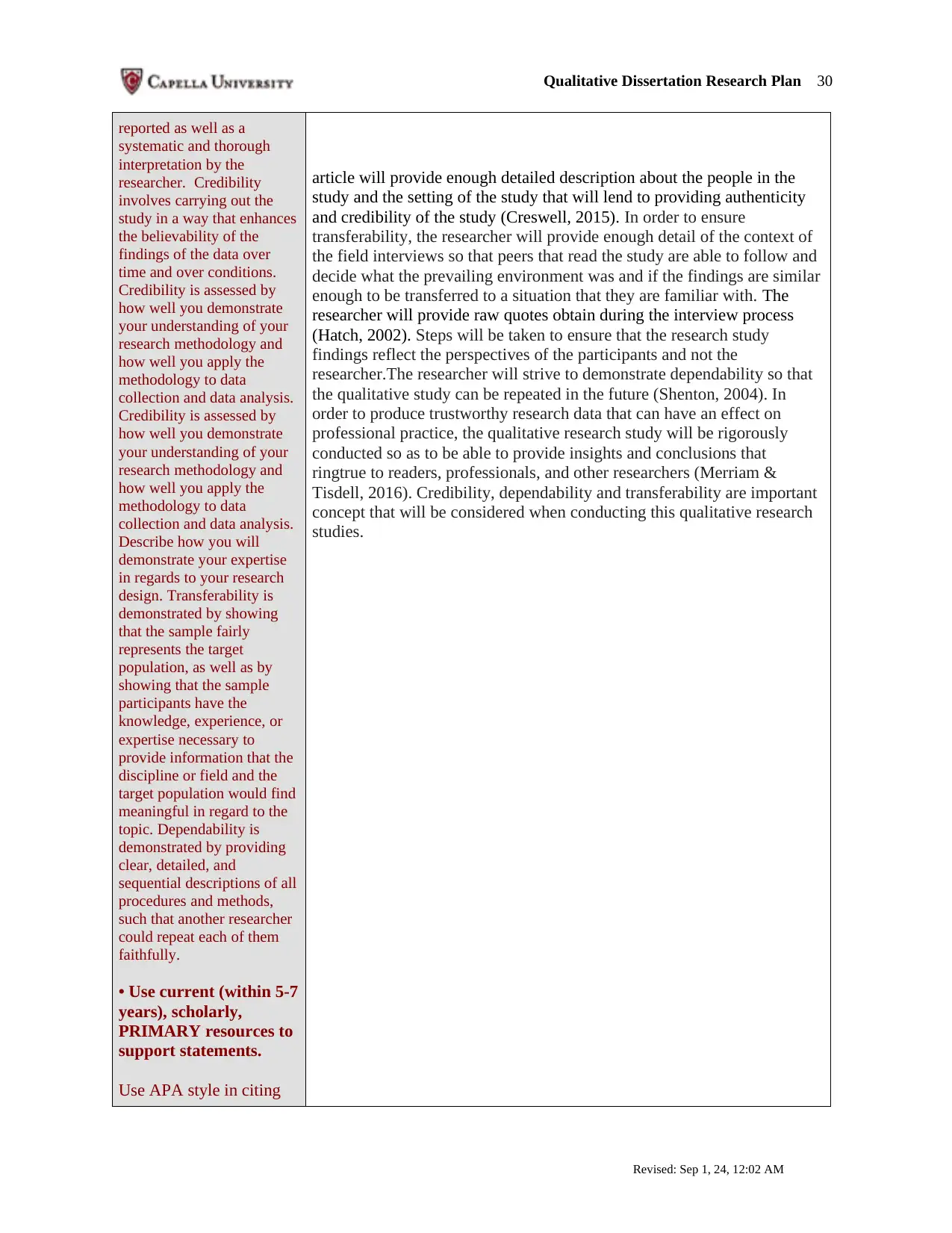
Qualitative Dissertation Research Plan 30
reported as well as a
systematic and thorough
interpretation by the
researcher. Credibility
involves carrying out the
study in a way that enhances
the believability of the
findings of the data over
time and over conditions.
Credibility is assessed by
how well you demonstrate
your understanding of your
research methodology and
how well you apply the
methodology to data
collection and data analysis.
Credibility is assessed by
how well you demonstrate
your understanding of your
research methodology and
how well you apply the
methodology to data
collection and data analysis.
Describe how you will
demonstrate your expertise
in regards to your research
design. Transferability is
demonstrated by showing
that the sample fairly
represents the target
population, as well as by
showing that the sample
participants have the
knowledge, experience, or
expertise necessary to
provide information that the
discipline or field and the
target population would find
meaningful in regard to the
topic. Dependability is
demonstrated by providing
clear, detailed, and
sequential descriptions of all
procedures and methods,
such that another researcher
could repeat each of them
faithfully.
• Use current (within 5-7
years), scholarly,
PRIMARY resources to
support statements.
Use APA style in citing
article will provide enough detailed description about the people in the
study and the setting of the study that will lend to providing authenticity
and credibility of the study (Creswell, 2015). In order to ensure
transferability, the researcher will provide enough detail of the context of
the field interviews so that peers that read the study are able to follow and
decide what the prevailing environment was and if the findings are similar
enough to be transferred to a situation that they are familiar with. The
researcher will provide raw quotes obtain during the interview process
(Hatch, 2002). Steps will be taken to ensure that the research study
findings reflect the perspectives of the participants and not the
researcher.The researcher will strive to demonstrate dependability so that
the qualitative study can be repeated in the future (Shenton, 2004). In
order to produce trustworthy research data that can have an effect on
professional practice, the qualitative research study will be rigorously
conducted so as to be able to provide insights and conclusions that
ringtrue to readers, professionals, and other researchers (Merriam &
Tisdell, 2016). Credibility, dependability and transferability are important
concept that will be considered when conducting this qualitative research
studies.
Revised: Sep 1, 24, 12:02 AM
reported as well as a
systematic and thorough
interpretation by the
researcher. Credibility
involves carrying out the
study in a way that enhances
the believability of the
findings of the data over
time and over conditions.
Credibility is assessed by
how well you demonstrate
your understanding of your
research methodology and
how well you apply the
methodology to data
collection and data analysis.
Credibility is assessed by
how well you demonstrate
your understanding of your
research methodology and
how well you apply the
methodology to data
collection and data analysis.
Describe how you will
demonstrate your expertise
in regards to your research
design. Transferability is
demonstrated by showing
that the sample fairly
represents the target
population, as well as by
showing that the sample
participants have the
knowledge, experience, or
expertise necessary to
provide information that the
discipline or field and the
target population would find
meaningful in regard to the
topic. Dependability is
demonstrated by providing
clear, detailed, and
sequential descriptions of all
procedures and methods,
such that another researcher
could repeat each of them
faithfully.
• Use current (within 5-7
years), scholarly,
PRIMARY resources to
support statements.
Use APA style in citing
article will provide enough detailed description about the people in the
study and the setting of the study that will lend to providing authenticity
and credibility of the study (Creswell, 2015). In order to ensure
transferability, the researcher will provide enough detail of the context of
the field interviews so that peers that read the study are able to follow and
decide what the prevailing environment was and if the findings are similar
enough to be transferred to a situation that they are familiar with. The
researcher will provide raw quotes obtain during the interview process
(Hatch, 2002). Steps will be taken to ensure that the research study
findings reflect the perspectives of the participants and not the
researcher.The researcher will strive to demonstrate dependability so that
the qualitative study can be repeated in the future (Shenton, 2004). In
order to produce trustworthy research data that can have an effect on
professional practice, the qualitative research study will be rigorously
conducted so as to be able to provide insights and conclusions that
ringtrue to readers, professionals, and other researchers (Merriam &
Tisdell, 2016). Credibility, dependability and transferability are important
concept that will be considered when conducting this qualitative research
studies.
Revised: Sep 1, 24, 12:02 AM
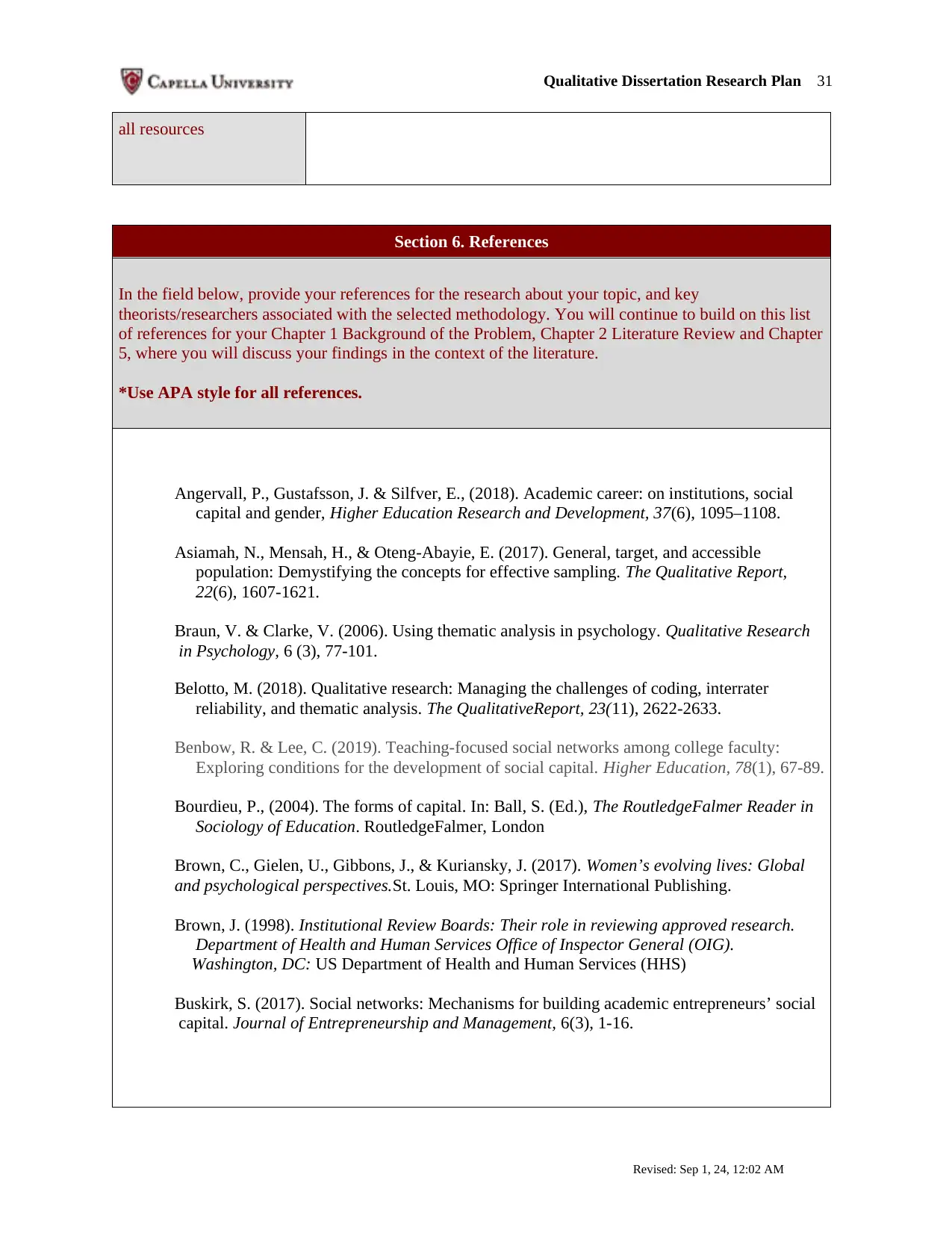
Qualitative Dissertation Research Plan 31
all resources
Section 6. References
In the field below, provide your references for the research about your topic, and key
theorists/researchers associated with the selected methodology. You will continue to build on this list
of references for your Chapter 1 Background of the Problem, Chapter 2 Literature Review and Chapter
5, where you will discuss your findings in the context of the literature.
*Use APA style for all references.
Angervall, P., Gustafsson, J. & Silfver, E., (2018). Academic career: on institutions, social
capital and gender, Higher Education Research and Development, 37(6), 1095–1108.
Asiamah, N., Mensah, H., & Oteng-Abayie, E. (2017). General, target, and accessible
population: Demystifying the concepts for effective sampling. The Qualitative Report,
22(6), 1607-1621.
Braun, V. & Clarke, V. (2006). Using thematic analysis in psychology. Qualitative Research
in Psychology, 6 (3), 77-101.
Belotto, M. (2018). Qualitative research: Managing the challenges of coding, interrater
reliability, and thematic analysis. The QualitativeReport, 23(11), 2622-2633.
Benbow, R. & Lee, C. (2019). Teaching-focused social networks among college faculty:
Exploring conditions for the development of social capital. Higher Education, 78(1), 67-89.
Bourdieu, P., (2004). The forms of capital. In: Ball, S. (Ed.), The RoutledgeFalmer Reader in
Sociology of Education. RoutledgeFalmer, London
Brown, C., Gielen, U., Gibbons, J., & Kuriansky, J. (2017). Women’s evolving lives: Global
and psychological perspectives.St. Louis, MO: Springer International Publishing.
Brown, J. (1998). Institutional Review Boards: Their role in reviewing approved research.
Department of Health and Human Services Office of Inspector General (OIG).
Washington, DC: US Department of Health and Human Services (HHS)
Buskirk, S. (2017). Social networks: Mechanisms for building academic entrepreneurs’ social
capital. Journal of Entrepreneurship and Management, 6(3), 1-16.
Revised: Sep 1, 24, 12:02 AM
all resources
Section 6. References
In the field below, provide your references for the research about your topic, and key
theorists/researchers associated with the selected methodology. You will continue to build on this list
of references for your Chapter 1 Background of the Problem, Chapter 2 Literature Review and Chapter
5, where you will discuss your findings in the context of the literature.
*Use APA style for all references.
Angervall, P., Gustafsson, J. & Silfver, E., (2018). Academic career: on institutions, social
capital and gender, Higher Education Research and Development, 37(6), 1095–1108.
Asiamah, N., Mensah, H., & Oteng-Abayie, E. (2017). General, target, and accessible
population: Demystifying the concepts for effective sampling. The Qualitative Report,
22(6), 1607-1621.
Braun, V. & Clarke, V. (2006). Using thematic analysis in psychology. Qualitative Research
in Psychology, 6 (3), 77-101.
Belotto, M. (2018). Qualitative research: Managing the challenges of coding, interrater
reliability, and thematic analysis. The QualitativeReport, 23(11), 2622-2633.
Benbow, R. & Lee, C. (2019). Teaching-focused social networks among college faculty:
Exploring conditions for the development of social capital. Higher Education, 78(1), 67-89.
Bourdieu, P., (2004). The forms of capital. In: Ball, S. (Ed.), The RoutledgeFalmer Reader in
Sociology of Education. RoutledgeFalmer, London
Brown, C., Gielen, U., Gibbons, J., & Kuriansky, J. (2017). Women’s evolving lives: Global
and psychological perspectives.St. Louis, MO: Springer International Publishing.
Brown, J. (1998). Institutional Review Boards: Their role in reviewing approved research.
Department of Health and Human Services Office of Inspector General (OIG).
Washington, DC: US Department of Health and Human Services (HHS)
Buskirk, S. (2017). Social networks: Mechanisms for building academic entrepreneurs’ social
capital. Journal of Entrepreneurship and Management, 6(3), 1-16.
Revised: Sep 1, 24, 12:02 AM
Paraphrase This Document
Need a fresh take? Get an instant paraphrase of this document with our AI Paraphraser
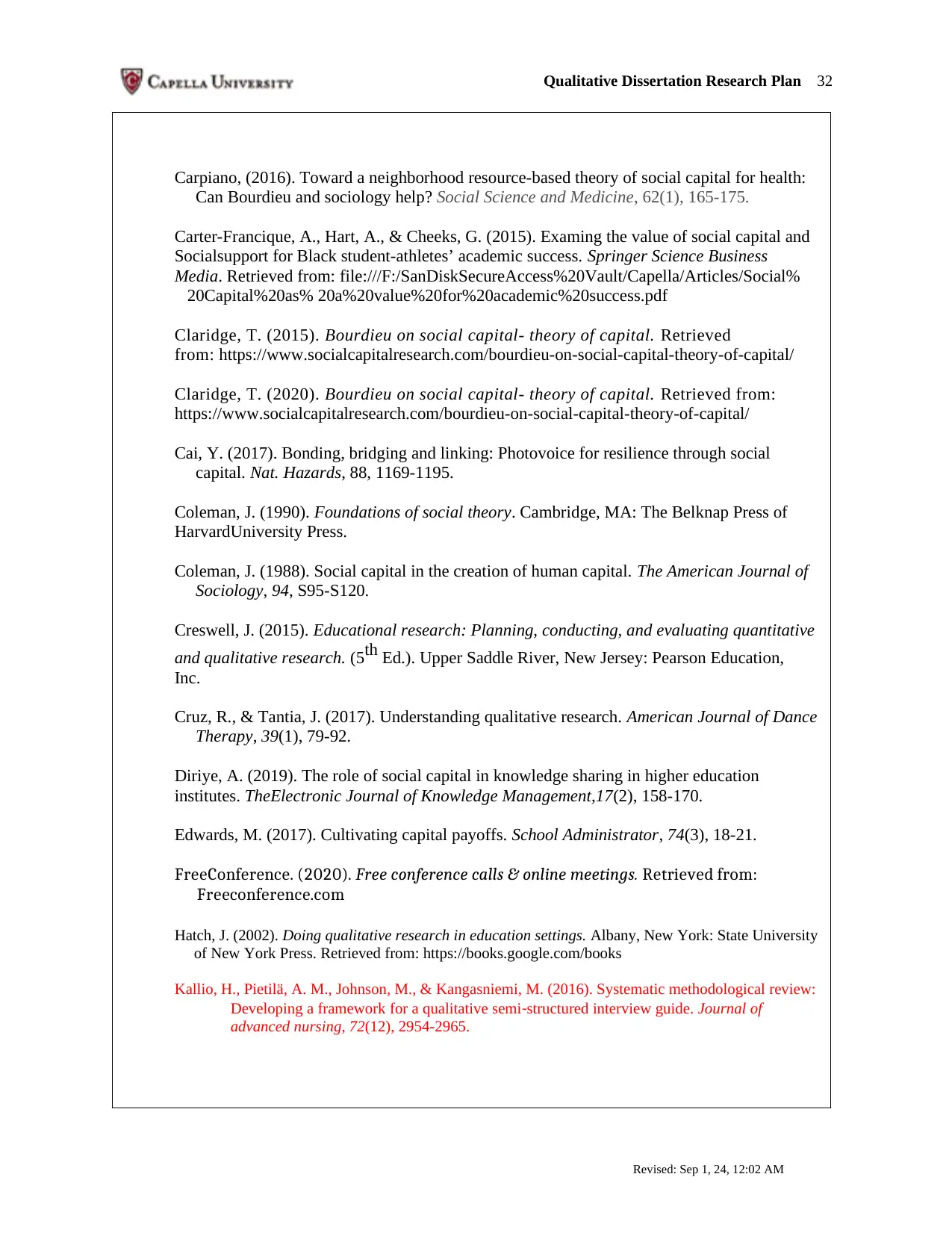
Qualitative Dissertation Research Plan 32
Carpiano, (2016). Toward a neighborhood resource-based theory of social capital for health:
Can Bourdieu and sociology help? Social Science and Medicine, 62(1), 165-175.
Carter-Francique, A., Hart, A., & Cheeks, G. (2015). Examing the value of social capital and
Socialsupport for Black student-athletes’ academic success. Springer Science Business
Media. Retrieved from: file:///F:/SanDiskSecureAccess%20Vault/Capella/Articles/Social%
20Capital%20as% 20a%20value%20for%20academic%20success.pdf
Claridge, T. (2015). Bourdieu on social capital- theory of capital. Retrieved
from: https://www.socialcapitalresearch.com/bourdieu-on-social-capital-theory-of-capital/
Claridge, T. (2020). Bourdieu on social capital- theory of capital. Retrieved from:
https://www.socialcapitalresearch.com/bourdieu-on-social-capital-theory-of-capital/
Cai, Y. (2017). Bonding, bridging and linking: Photovoice for resilience through social
capital. Nat. Hazards, 88, 1169-1195.
Coleman, J. (1990). Foundations of social theory. Cambridge, MA: The Belknap Press of
HarvardUniversity Press.
Coleman, J. (1988). Social capital in the creation of human capital. The American Journal of
Sociology, 94, S95-S120.
Creswell, J. (2015). Educational research: Planning, conducting, and evaluating quantitative
and qualitative research. (5th Ed.). Upper Saddle River, New Jersey: Pearson Education,
Inc.
Cruz, R., & Tantia, J. (2017). Understanding qualitative research. American Journal of Dance
Therapy, 39(1), 79-92.
Diriye, A. (2019). The role of social capital in knowledge sharing in higher education
institutes. TheElectronic Journal of Knowledge Management,17(2), 158-170.
Edwards, M. (2017). Cultivating capital payoffs. School Administrator, 74(3), 18-21.
FreeConference. (2020). Free conference calls & online meetings. Retrieved from:
Freeconference.com
Hatch, J. (2002). Doing qualitative research in education settings. Albany, New York: State University
of New York Press. Retrieved from: https://books.google.com/books
Kallio, H., Pietilä, A. M., Johnson, M., & Kangasniemi, M. (2016). Systematic methodological review:
Developing a framework for a qualitative semi‐structured interview guide. Journal of
advanced nursing, 72(12), 2954-2965.
Revised: Sep 1, 24, 12:02 AM
Carpiano, (2016). Toward a neighborhood resource-based theory of social capital for health:
Can Bourdieu and sociology help? Social Science and Medicine, 62(1), 165-175.
Carter-Francique, A., Hart, A., & Cheeks, G. (2015). Examing the value of social capital and
Socialsupport for Black student-athletes’ academic success. Springer Science Business
Media. Retrieved from: file:///F:/SanDiskSecureAccess%20Vault/Capella/Articles/Social%
20Capital%20as% 20a%20value%20for%20academic%20success.pdf
Claridge, T. (2015). Bourdieu on social capital- theory of capital. Retrieved
from: https://www.socialcapitalresearch.com/bourdieu-on-social-capital-theory-of-capital/
Claridge, T. (2020). Bourdieu on social capital- theory of capital. Retrieved from:
https://www.socialcapitalresearch.com/bourdieu-on-social-capital-theory-of-capital/
Cai, Y. (2017). Bonding, bridging and linking: Photovoice for resilience through social
capital. Nat. Hazards, 88, 1169-1195.
Coleman, J. (1990). Foundations of social theory. Cambridge, MA: The Belknap Press of
HarvardUniversity Press.
Coleman, J. (1988). Social capital in the creation of human capital. The American Journal of
Sociology, 94, S95-S120.
Creswell, J. (2015). Educational research: Planning, conducting, and evaluating quantitative
and qualitative research. (5th Ed.). Upper Saddle River, New Jersey: Pearson Education,
Inc.
Cruz, R., & Tantia, J. (2017). Understanding qualitative research. American Journal of Dance
Therapy, 39(1), 79-92.
Diriye, A. (2019). The role of social capital in knowledge sharing in higher education
institutes. TheElectronic Journal of Knowledge Management,17(2), 158-170.
Edwards, M. (2017). Cultivating capital payoffs. School Administrator, 74(3), 18-21.
FreeConference. (2020). Free conference calls & online meetings. Retrieved from:
Freeconference.com
Hatch, J. (2002). Doing qualitative research in education settings. Albany, New York: State University
of New York Press. Retrieved from: https://books.google.com/books
Kallio, H., Pietilä, A. M., Johnson, M., & Kangasniemi, M. (2016). Systematic methodological review:
Developing a framework for a qualitative semi‐structured interview guide. Journal of
advanced nursing, 72(12), 2954-2965.
Revised: Sep 1, 24, 12:02 AM
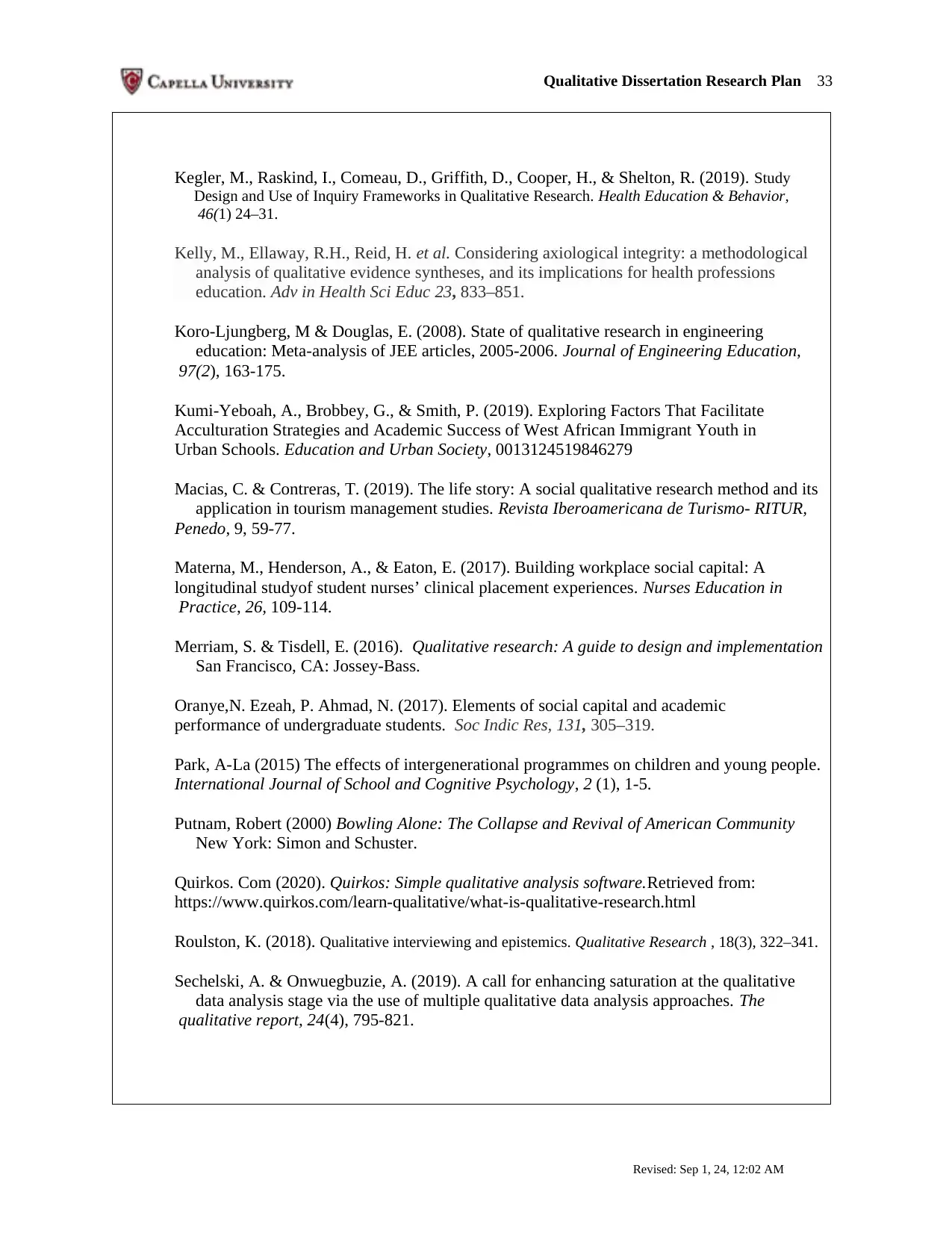
Qualitative Dissertation Research Plan 33
Kegler, M., Raskind, I., Comeau, D., Griffith, D., Cooper, H., & Shelton, R. (2019). Study
Design and Use of Inquiry Frameworks in Qualitative Research. Health Education & Behavior,
46(1) 24–31.
Kelly, M., Ellaway, R.H., Reid, H. et al. Considering axiological integrity: a methodological
analysis of qualitative evidence syntheses, and its implications for health professions
education. Adv in Health Sci Educ 23, 833–851.
Koro-Ljungberg, M & Douglas, E. (2008). State of qualitative research in engineering
education: Meta-analysis of JEE articles, 2005-2006. Journal of Engineering Education,
97(2), 163-175.
Kumi-Yeboah, A., Brobbey, G., & Smith, P. (2019). Exploring Factors That Facilitate
Acculturation Strategies and Academic Success of West African Immigrant Youth in
Urban Schools. Education and Urban Society, 0013124519846279
Macias, C. & Contreras, T. (2019). The life story: A social qualitative research method and its
application in tourism management studies. Revista Iberoamericana de Turismo- RITUR,
Penedo, 9, 59-77.
Materna, M., Henderson, A., & Eaton, E. (2017). Building workplace social capital: A
longitudinal studyof student nurses’ clinical placement experiences. Nurses Education in
Practice, 26, 109-114.
Merriam, S. & Tisdell, E. (2016). Qualitative research: A guide to design and implementation
San Francisco, CA: Jossey-Bass.
Oranye,N. Ezeah, P. Ahmad, N. (2017). Elements of social capital and academic
performance of undergraduate students. Soc Indic Res, 131, 305–319.
Park, A-La (2015) The effects of intergenerational programmes on children and young people.
International Journal of School and Cognitive Psychology, 2 (1), 1-5.
Putnam, Robert (2000) Bowling Alone: The Collapse and Revival of American Community
New York: Simon and Schuster.
Quirkos. Com (2020). Quirkos: Simple qualitative analysis software.Retrieved from:
https://www.quirkos.com/learn-qualitative/what-is-qualitative-research.html
Roulston, K. (2018). Qualitative interviewing and epistemics. Qualitative Research , 18(3), 322–341.
Sechelski, A. & Onwuegbuzie, A. (2019). A call for enhancing saturation at the qualitative
data analysis stage via the use of multiple qualitative data analysis approaches. The
qualitative report, 24(4), 795-821.
Revised: Sep 1, 24, 12:02 AM
Kegler, M., Raskind, I., Comeau, D., Griffith, D., Cooper, H., & Shelton, R. (2019). Study
Design and Use of Inquiry Frameworks in Qualitative Research. Health Education & Behavior,
46(1) 24–31.
Kelly, M., Ellaway, R.H., Reid, H. et al. Considering axiological integrity: a methodological
analysis of qualitative evidence syntheses, and its implications for health professions
education. Adv in Health Sci Educ 23, 833–851.
Koro-Ljungberg, M & Douglas, E. (2008). State of qualitative research in engineering
education: Meta-analysis of JEE articles, 2005-2006. Journal of Engineering Education,
97(2), 163-175.
Kumi-Yeboah, A., Brobbey, G., & Smith, P. (2019). Exploring Factors That Facilitate
Acculturation Strategies and Academic Success of West African Immigrant Youth in
Urban Schools. Education and Urban Society, 0013124519846279
Macias, C. & Contreras, T. (2019). The life story: A social qualitative research method and its
application in tourism management studies. Revista Iberoamericana de Turismo- RITUR,
Penedo, 9, 59-77.
Materna, M., Henderson, A., & Eaton, E. (2017). Building workplace social capital: A
longitudinal studyof student nurses’ clinical placement experiences. Nurses Education in
Practice, 26, 109-114.
Merriam, S. & Tisdell, E. (2016). Qualitative research: A guide to design and implementation
San Francisco, CA: Jossey-Bass.
Oranye,N. Ezeah, P. Ahmad, N. (2017). Elements of social capital and academic
performance of undergraduate students. Soc Indic Res, 131, 305–319.
Park, A-La (2015) The effects of intergenerational programmes on children and young people.
International Journal of School and Cognitive Psychology, 2 (1), 1-5.
Putnam, Robert (2000) Bowling Alone: The Collapse and Revival of American Community
New York: Simon and Schuster.
Quirkos. Com (2020). Quirkos: Simple qualitative analysis software.Retrieved from:
https://www.quirkos.com/learn-qualitative/what-is-qualitative-research.html
Roulston, K. (2018). Qualitative interviewing and epistemics. Qualitative Research , 18(3), 322–341.
Sechelski, A. & Onwuegbuzie, A. (2019). A call for enhancing saturation at the qualitative
data analysis stage via the use of multiple qualitative data analysis approaches. The
qualitative report, 24(4), 795-821.
Revised: Sep 1, 24, 12:02 AM
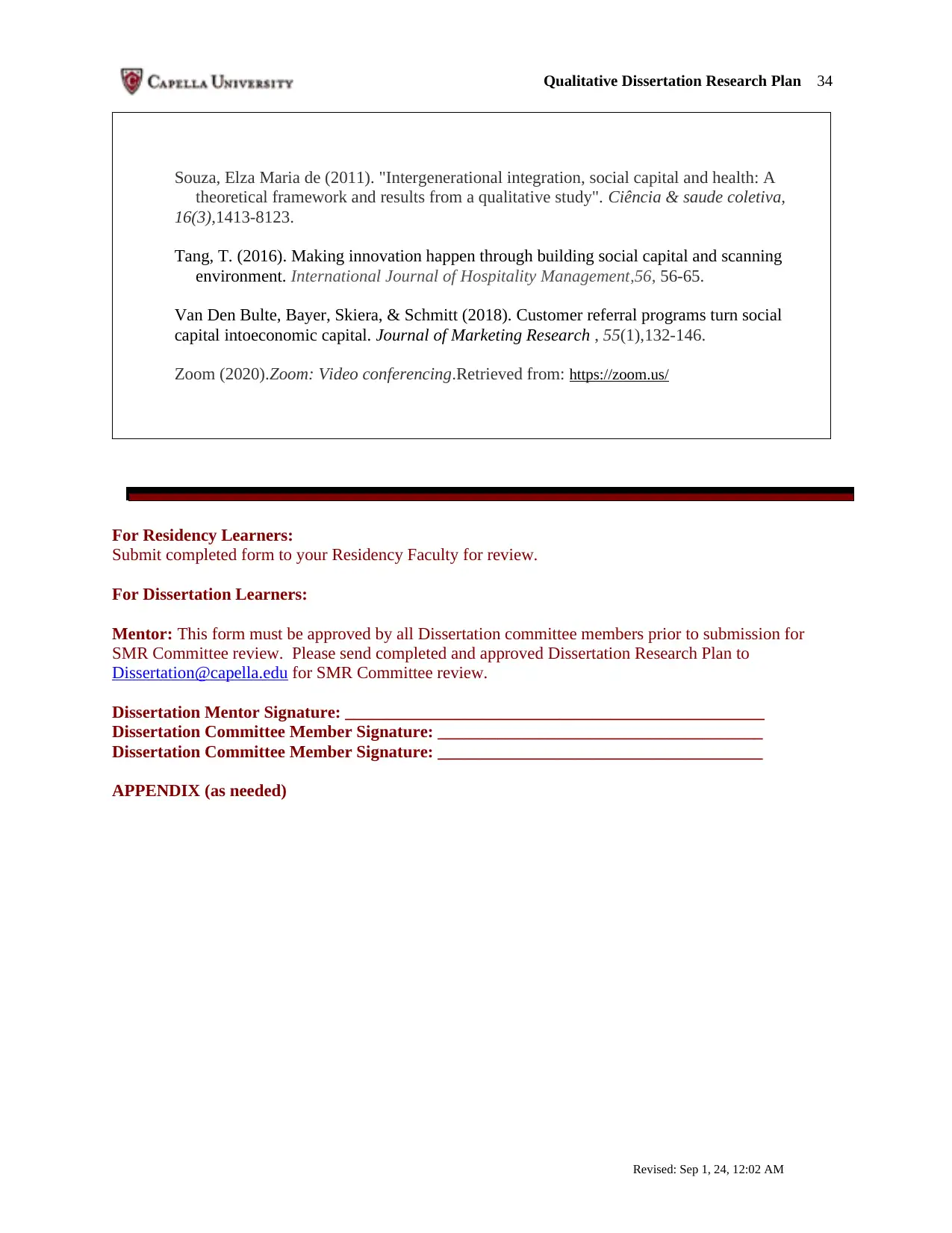
Qualitative Dissertation Research Plan 34
Souza, Elza Maria de (2011). "Intergenerational integration, social capital and health: A
theoretical framework and results from a qualitative study". Ciência & saude coletiva,
16(3),1413-8123.
Tang, T. (2016). Making innovation happen through building social capital and scanning
environment. International Journal of Hospitality Management,56, 56-65.
Van Den Bulte, Bayer, Skiera, & Schmitt (2018). Customer referral programs turn social
capital intoeconomic capital. Journal of Marketing Research , 55(1),132-146.
Zoom (2020).Zoom: Video conferencing.Retrieved from: https://zoom.us/
Section 6. References
For Residency Learners:
Submit completed form to your Residency Faculty for review.
For Dissertation Learners:
Mentor: This form must be approved by all Dissertation committee members prior to submission for
SMR Committee review. Please send completed and approved Dissertation Research Plan to
Dissertation@capella.edu for SMR Committee review.
Dissertation Mentor Signature: _________________________________________________
Dissertation Committee Member Signature: ______________________________________
Dissertation Committee Member Signature: ______________________________________
APPENDIX (as needed)
Revised: Sep 1, 24, 12:02 AM
Souza, Elza Maria de (2011). "Intergenerational integration, social capital and health: A
theoretical framework and results from a qualitative study". Ciência & saude coletiva,
16(3),1413-8123.
Tang, T. (2016). Making innovation happen through building social capital and scanning
environment. International Journal of Hospitality Management,56, 56-65.
Van Den Bulte, Bayer, Skiera, & Schmitt (2018). Customer referral programs turn social
capital intoeconomic capital. Journal of Marketing Research , 55(1),132-146.
Zoom (2020).Zoom: Video conferencing.Retrieved from: https://zoom.us/
Section 6. References
For Residency Learners:
Submit completed form to your Residency Faculty for review.
For Dissertation Learners:
Mentor: This form must be approved by all Dissertation committee members prior to submission for
SMR Committee review. Please send completed and approved Dissertation Research Plan to
Dissertation@capella.edu for SMR Committee review.
Dissertation Mentor Signature: _________________________________________________
Dissertation Committee Member Signature: ______________________________________
Dissertation Committee Member Signature: ______________________________________
APPENDIX (as needed)
Revised: Sep 1, 24, 12:02 AM
Secure Best Marks with AI Grader
Need help grading? Try our AI Grader for instant feedback on your assignments.
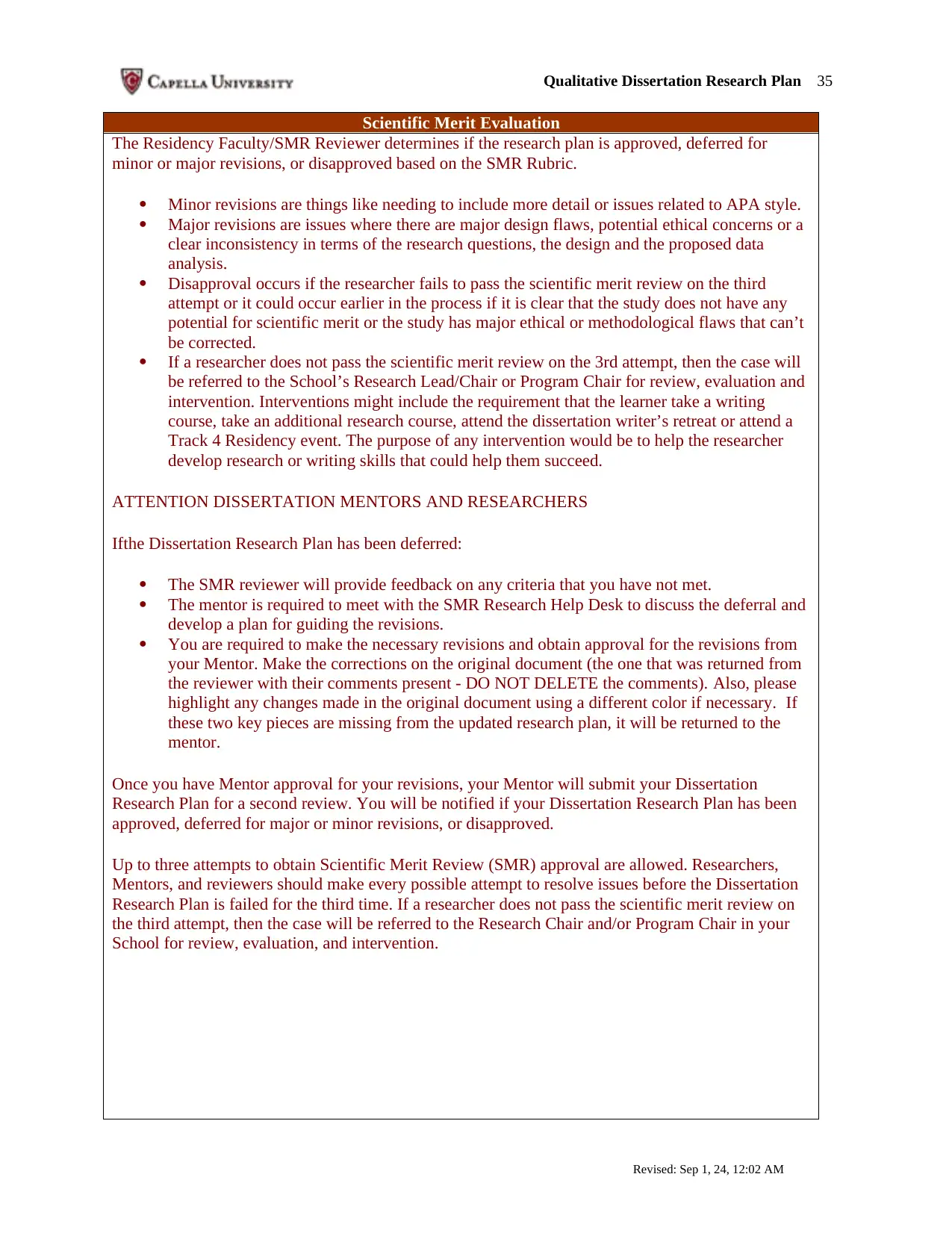
Qualitative Dissertation Research Plan 35
Scientific Merit Evaluation
The Residency Faculty/SMR Reviewer determines if the research plan is approved, deferred for
minor or major revisions, or disapproved based on the SMR Rubric.
Minor revisions are things like needing to include more detail or issues related to APA style.
Major revisions are issues where there are major design flaws, potential ethical concerns or a
clear inconsistency in terms of the research questions, the design and the proposed data
analysis.
Disapproval occurs if the researcher fails to pass the scientific merit review on the third
attempt or it could occur earlier in the process if it is clear that the study does not have any
potential for scientific merit or the study has major ethical or methodological flaws that can’t
be corrected.
If a researcher does not pass the scientific merit review on the 3rd attempt, then the case will
be referred to the School’s Research Lead/Chair or Program Chair for review, evaluation and
intervention. Interventions might include the requirement that the learner take a writing
course, take an additional research course, attend the dissertation writer’s retreat or attend a
Track 4 Residency event. The purpose of any intervention would be to help the researcher
develop research or writing skills that could help them succeed.
ATTENTION DISSERTATION MENTORS AND RESEARCHERS
Ifthe Dissertation Research Plan has been deferred:
The SMR reviewer will provide feedback on any criteria that you have not met.
The mentor is required to meet with the SMR Research Help Desk to discuss the deferral and
develop a plan for guiding the revisions.
You are required to make the necessary revisions and obtain approval for the revisions from
your Mentor. Make the corrections on the original document (the one that was returned from
the reviewer with their comments present - DO NOT DELETE the comments). Also, please
highlight any changes made in the original document using a different color if necessary. If
these two key pieces are missing from the updated research plan, it will be returned to the
mentor.
Once you have Mentor approval for your revisions, your Mentor will submit your Dissertation
Research Plan for a second review. You will be notified if your Dissertation Research Plan has been
approved, deferred for major or minor revisions, or disapproved.
Up to three attempts to obtain Scientific Merit Review (SMR) approval are allowed. Researchers,
Mentors, and reviewers should make every possible attempt to resolve issues before the Dissertation
Research Plan is failed for the third time. If a researcher does not pass the scientific merit review on
the third attempt, then the case will be referred to the Research Chair and/or Program Chair in your
School for review, evaluation, and intervention.
Revised: Sep 1, 24, 12:02 AM
Scientific Merit Evaluation
The Residency Faculty/SMR Reviewer determines if the research plan is approved, deferred for
minor or major revisions, or disapproved based on the SMR Rubric.
Minor revisions are things like needing to include more detail or issues related to APA style.
Major revisions are issues where there are major design flaws, potential ethical concerns or a
clear inconsistency in terms of the research questions, the design and the proposed data
analysis.
Disapproval occurs if the researcher fails to pass the scientific merit review on the third
attempt or it could occur earlier in the process if it is clear that the study does not have any
potential for scientific merit or the study has major ethical or methodological flaws that can’t
be corrected.
If a researcher does not pass the scientific merit review on the 3rd attempt, then the case will
be referred to the School’s Research Lead/Chair or Program Chair for review, evaluation and
intervention. Interventions might include the requirement that the learner take a writing
course, take an additional research course, attend the dissertation writer’s retreat or attend a
Track 4 Residency event. The purpose of any intervention would be to help the researcher
develop research or writing skills that could help them succeed.
ATTENTION DISSERTATION MENTORS AND RESEARCHERS
Ifthe Dissertation Research Plan has been deferred:
The SMR reviewer will provide feedback on any criteria that you have not met.
The mentor is required to meet with the SMR Research Help Desk to discuss the deferral and
develop a plan for guiding the revisions.
You are required to make the necessary revisions and obtain approval for the revisions from
your Mentor. Make the corrections on the original document (the one that was returned from
the reviewer with their comments present - DO NOT DELETE the comments). Also, please
highlight any changes made in the original document using a different color if necessary. If
these two key pieces are missing from the updated research plan, it will be returned to the
mentor.
Once you have Mentor approval for your revisions, your Mentor will submit your Dissertation
Research Plan for a second review. You will be notified if your Dissertation Research Plan has been
approved, deferred for major or minor revisions, or disapproved.
Up to three attempts to obtain Scientific Merit Review (SMR) approval are allowed. Researchers,
Mentors, and reviewers should make every possible attempt to resolve issues before the Dissertation
Research Plan is failed for the third time. If a researcher does not pass the scientific merit review on
the third attempt, then the case will be referred to the Research Chair and/or Program Chair in your
School for review, evaluation, and intervention.
Revised: Sep 1, 24, 12:02 AM
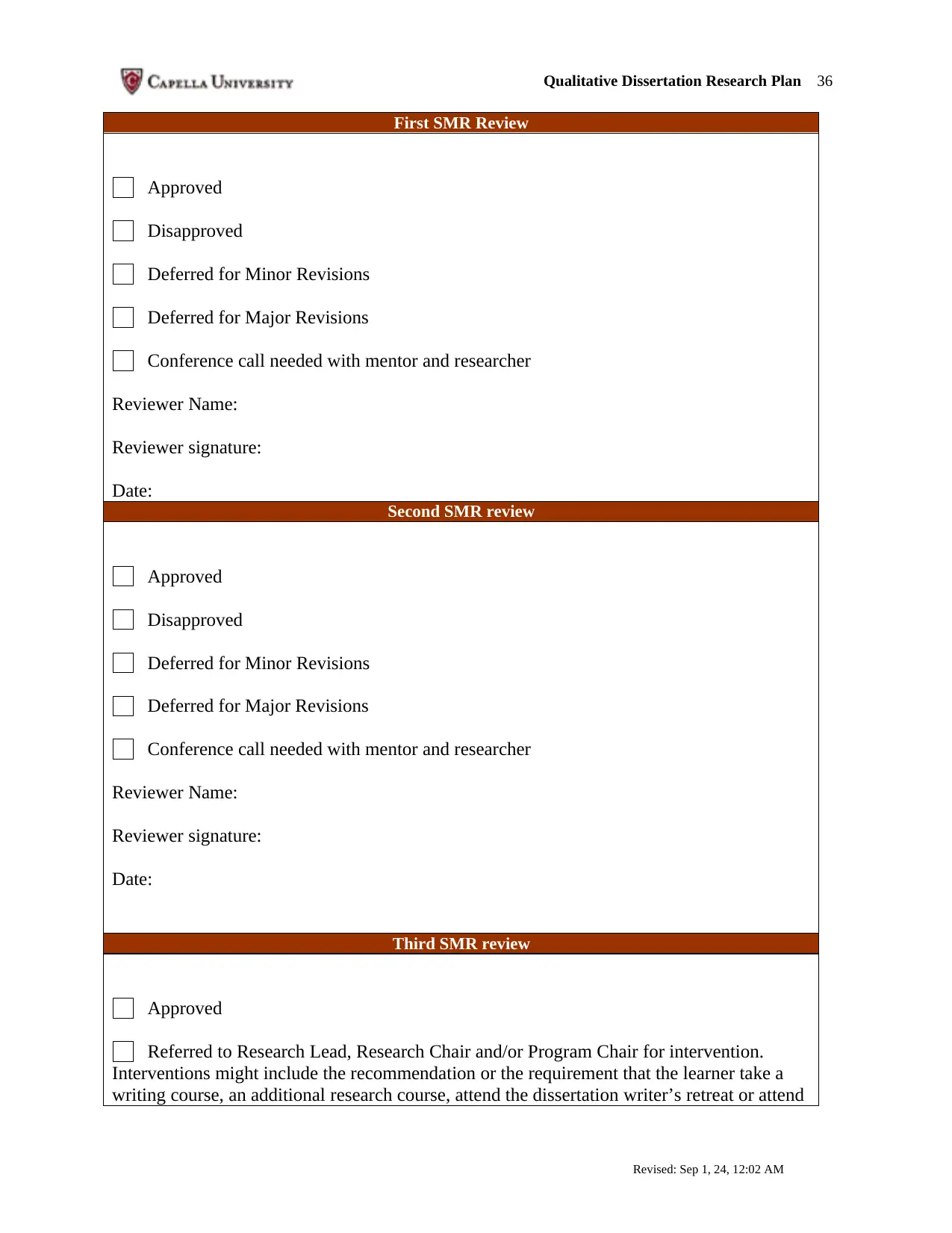
Qualitative Dissertation Research Plan 36
First SMR Review
Approved
Disapproved
Deferred for Minor Revisions
Deferred for Major Revisions
Conference call needed with mentor and researcher
Reviewer Name:
Reviewer signature:
Date:
Second SMR review
Approved
Disapproved
Deferred for Minor Revisions
Deferred for Major Revisions
Conference call needed with mentor and researcher
Reviewer Name:
Reviewer signature:
Date:
Third SMR review
Approved
Referred to Research Lead, Research Chair and/or Program Chair for intervention.
Interventions might include the recommendation or the requirement that the learner take a
writing course, an additional research course, attend the dissertation writer’s retreat or attend
Revised: Sep 1, 24, 12:02 AM
First SMR Review
Approved
Disapproved
Deferred for Minor Revisions
Deferred for Major Revisions
Conference call needed with mentor and researcher
Reviewer Name:
Reviewer signature:
Date:
Second SMR review
Approved
Disapproved
Deferred for Minor Revisions
Deferred for Major Revisions
Conference call needed with mentor and researcher
Reviewer Name:
Reviewer signature:
Date:
Third SMR review
Approved
Referred to Research Lead, Research Chair and/or Program Chair for intervention.
Interventions might include the recommendation or the requirement that the learner take a
writing course, an additional research course, attend the dissertation writer’s retreat or attend
Revised: Sep 1, 24, 12:02 AM
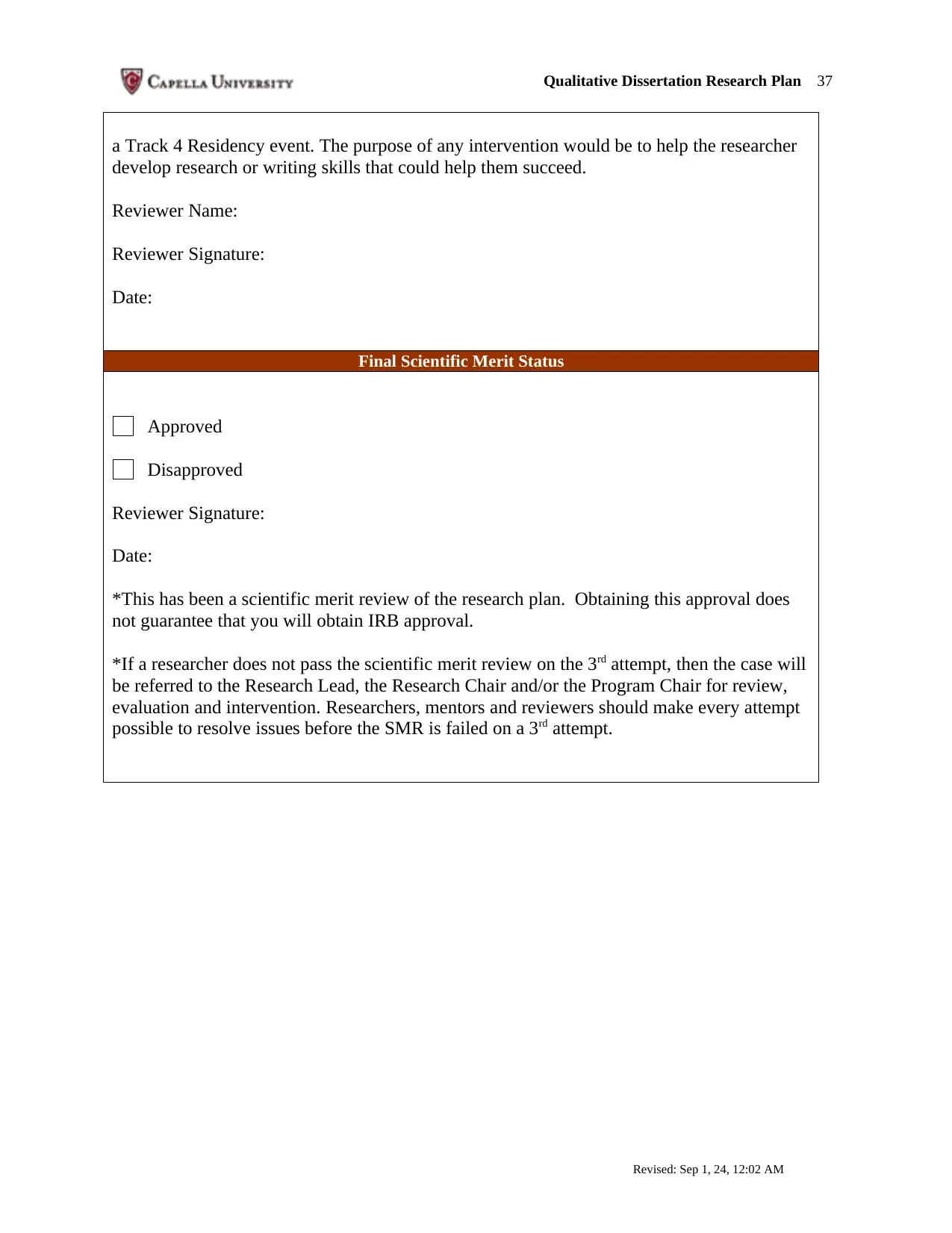
Qualitative Dissertation Research Plan 37
a Track 4 Residency event. The purpose of any intervention would be to help the researcher
develop research or writing skills that could help them succeed.
Reviewer Name:
Reviewer Signature:
Date:
Final Scientific Merit Status
Approved
Disapproved
Reviewer Signature:
Date:
*This has been a scientific merit review of the research plan. Obtaining this approval does
not guarantee that you will obtain IRB approval.
*If a researcher does not pass the scientific merit review on the 3rd attempt, then the case will
be referred to the Research Lead, the Research Chair and/or the Program Chair for review,
evaluation and intervention. Researchers, mentors and reviewers should make every attempt
possible to resolve issues before the SMR is failed on a 3rd attempt.
Revised: Sep 1, 24, 12:02 AM
a Track 4 Residency event. The purpose of any intervention would be to help the researcher
develop research or writing skills that could help them succeed.
Reviewer Name:
Reviewer Signature:
Date:
Final Scientific Merit Status
Approved
Disapproved
Reviewer Signature:
Date:
*This has been a scientific merit review of the research plan. Obtaining this approval does
not guarantee that you will obtain IRB approval.
*If a researcher does not pass the scientific merit review on the 3rd attempt, then the case will
be referred to the Research Lead, the Research Chair and/or the Program Chair for review,
evaluation and intervention. Researchers, mentors and reviewers should make every attempt
possible to resolve issues before the SMR is failed on a 3rd attempt.
Revised: Sep 1, 24, 12:02 AM
1 out of 37
Your All-in-One AI-Powered Toolkit for Academic Success.
+13062052269
info@desklib.com
Available 24*7 on WhatsApp / Email
![[object Object]](/_next/static/media/star-bottom.7253800d.svg)
Unlock your academic potential
© 2024 | Zucol Services PVT LTD | All rights reserved.